
Giant's Causeway

- 1.1 Visitor information
- 3 Get around
The Giant's Causeway is a spectacular series of rock formations on the north coast of Northern Ireland . The main site stretches for 2-3 miles, with some 40,000 basalt columns rising out of the sea. The area is owned by the National Trust and is Northern Ireland's only UNESCO World Heritage Site : it's impressive but very touristy, with a million visitors each year. It's mobbed on fine weekends, try to visit off-peak.
Understand [ edit ]

Some 60 million years ago, a great rift developed in the earth's surface that sundered Europe from America and formed the North Atlantic. Lava gushed up from fissures: it was fluid and spread out into vast fiery lakes, rather than heaping up into volcanoes. The lava cooled into a deep layer of basalt, the Thulian Plateau. The Atlantic widened and fractured the plateau into what is now the Scottish Hebrides, Northern Ireland, Iceland, Greenland and maritime Canada. It's still widening and the lava continues to well up from time to time, most obviously in Iceland.
Basalt layers are found worldwide, they form the dark maria or "seas" of the moon, are common on Mars, and are seen elsewhere in the solar system. The shape they take on cooling depends on conditions: here a thick lava flow cooled slowly, contracting slightly. This created a network of vertical fractures in a hexagonal pattern like mud in a dried-up lake-bed: it's the most energy-efficient way to dissipate the contraction stress. Horizontal cracks were wider spaced so as the basalt and other material eroded, this exposed tall black columns of about 0.5 m diameter, with a stepped appearance as upper segments washed off.
These formations were discovered by tourists in the 18th century, but local people had long wondered at them, and their fishermen told of similar formations across the North Channel in the Hebrides. Such a cascade of steps was surely not natural, but no mortal man could have wrought such things. Fortunately they knew just the fellow, one of the superheroes that inhabited the Ireland of legend. In the green corner, step forward Fionn mac Cumhaill or Finn McCool. In the blue corner for Scotland, step forward Bennandonner, the towering Bluto to McCool's Popeye, loud boos and jeers from the Ulster audience. It's a real grudge match because these two have a lot of previous. Like the time McCool scooped up a clod of earth to hurl at Bennandonner, but it fell short and created the Isle of Man, while the clod-hole filled with water as Lough Neagh.
Still the North Channel lies between them, with swift cold currents, too far to swim and McCool is too large for any boat yet built. So he creates a causeway across the sea, and storms ashore in Scotland to confront his foe. But then he sees Bennandonner up close for the first time. Big? Huge?? Humongous — McCool realises he's made a serious mistake, and legs it back to Ireland. Benandonner pursues him across the causeway, a tad slower, so McCool makes it home and has a few minutes to consider his defence.
Bennandonner pounds on the door and Mrs Oonagh McCool answers — "You'll be waking the baby!... my man Finn, oh but he's gone to the fields... do come in and wait, he wouldn't want to miss you, but keep quiet and don't wake the baby!" Bennandonner clocks the size of this baby — it's Finn himself playing cute in frills and a vast cradle. Baby that size, perhaps Bennandonner won't wait around to meet the father. So he scarpers back to Scotland and tears up the causeway behind him.
Visitor information [ edit ]
- Giant's Causeway guide
Get in [ edit ]

Day trips run from Belfast and even from Dublin - if you don't have your own transport and have limited time, these are a good option. They're sure to take in the other big-name attractions of Bushmills Distillery, Carrick-a-Rede Bridge and Dark Hedges; maybe a glimpse of the Antrim Glens.
By public transport you usually travel via Bushmills 3 miles south. That will mean a train from Belfast to Coleraine then Bus 402 / 172 along the coast. Stay on the bus at Bushmills and another five minutes brings you to Giant's Causeway. The bus continues east to Dunseverick (for crumbly castle), Ballintoy (for Carrick-a-Rede Bridge) and Ballycastle (for ferries to Rathlin Island ).
Alternatively, express bus 221 goes directly from Belfast 's Europa Buscentre to the Giant's Causeway and back again. It takes about an hour and a half and runs twice a day in each direction (departing Belfast in the morning and returning in the late afternoon), leaving plenty of time in between to explore the site. Tickets and timetables at TransLink .
By car reckon 80 min from Belfast via M2 / A26 to Ballymena then A44 towards Ballycastle, branching west on the coast road A2.
Get around [ edit ]

The area is maintained by the National Trust and is free to enter all year 24 hours, but you pay heavily for parking in a congested car park. You can avoid this by using other transport over the last couple of miles, and the high charges are meant to encourage you to do so. The options are:
Parking at the Causeway is only available with a ticket to the Visitor Centre: adult £13, child £6.50, NT members free. Pre-booking is advised at busy times. The centre has toilets and an exhibition: it's of interest, but not remotely worth what they're charging. You don't have to enter it to access the site.
55.233 -6.518 1 The Visitor Centre , built in 2012, is next to the car park. It's open daily Apr-Sep: 10AM-5PM, Oct-Mar: 10AM-4PM.
From the centre it's half a mile or so to the start of the area of interest, along the tarmac lane which descends to become the low-level path. A shuttle bus plies along it, £1 each way, NT free. This path gives the best view of the site but it dead-ends at Port Neostan - its continuation east has been closed because of erosion. The other path from the centre is along the cliff tops and extends for miles, great views out to sea but only oblique or more distant views of the rock formations. There's a steep link between these paths (the Shepherd's Steps) in the middle.
See [ edit ]
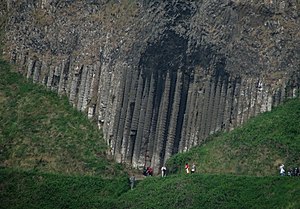
- Causeway School east side of the car park was an art school then a museum. It's now offices for the National Trust.
- Throughout the area, watch for bird life. Resident species include fulmar, petrel, cormorant, shag, redshank, guillemot and razorbill.
- 55.234 -6.524 1 Portcoon Jetty is the cove everybody misses, as you branch west instead of following the beaten trail. Right of the jetty, east side of the cove, is the large Portcoon Cave. You need low tide to scramble along the beach and into it, and torches to get any distance inside.
- 55.237 -6.518 2 Portnaboe or Bay of the Cow is the first inlet you reach on the low-level path north of the Visitor Centre. On the shore find The Camel, a hump-backed blade of rock formed as a "dyke" by lava cooling within a crack in now-vanished rocks.
- Great Stookan is the promontory closing that bay to the east, and the headland above is Weir Snout. The Granny is a rock part way up, said to resemble a stooped old woman climbing the hill - many visitors have difficulty spotting it, or seeing any resemblance. The inlet beyond is Port Ganny, bounded to the east by the centrepiece of the causeway.
- 55.24 -6.512 3 Grand Cascade is the one in all the tourist publicity, the great stairway, more suitable for a dance routine in top hat and tails than for clumping quarrelsome giants. The Wishing Chair is a throne-like cluster of columns gazing down amidst this vista, where what you wish is that your backside wasn't so wet and cold. The chair hexagon retains dampness, so take a plastic shopping bag to tuck under your butt, easily hidden from your partner's photo. The headland above is called Aird Snout and a steep path leads down, the Shepherd's Steps. In 2021 this path is closed by a rock fall.

- Port Noffer is the next small bay east. On the shore, The Boot is a large rock, from which it's calculated that Finn McCool stood 16 m tall. But suppose it's just the baby's boot?
- 55.242 -6.504 4 Organ Pipes are unbroken 15 m columns set into the cliffs above Port Noffer.
- Port Reostan is the next little cove east, backed by the cliffs of The Amphitheatre. The low-level path ends here, so if you want to explore further east, you need to backtrack and join the clifftop path. One offshore rock has a column that makes it resemble a submarine with a conning tower.
- 55.246 -6.502 5 Lacanda Point bounds that bay east, with The Chimney Tops the cliff formation above - erosion has separated these columns from the main rockface.
- Spanish Bay is the next, where the Armada galleas Girona was wrecked on 26 Oct 1588, with the loss of almost all 1300 aboard. After the Armada scattered and fled around Scotland, Girona was patched up in Donegal and attempted to head for Scotland instead of running for home along the Irish Atlantic coast, but a storm drove her onto the rocks here. In 1967 the wreck was located, and a huge hoard of gold recovered; diving on the wreck is forbidden. Set into the hillside, the Spanish Organ is similar to the Organ Pipes.
- Port na Callan , Port na Tober and Port na Plaiskin are the last three inlets at the east limit of the park area.
Do [ edit ]

- Giant's Causeway and Bushmills Railway [dead link] trundles for two miles through the sandhills between village and Causeway. See Bushmills for details, as it's best to park free at that end of the line.
- Sandy beaches are just west of the park towards Portballintrae.
Buy [ edit ]
- There's a gift shop within the Visitor Centre, but you've already paid them plenty just to go in the centre.
- There's no ATM here, the nearest is in Bushmills.
Eat [ edit ]
- 55.2326 -6.516 1 The Nook , 48 Causeway Rd, Bushmills BT57 8SU , ☏ +44 28 2073 2993 . Su-F 11AM-5PM, Sa noon-5PM . Bar and restaurant right by the entrance, gets very busy and you're paying for the convenience. ( updated Mar 2021 )
- Bushmills and Ballycastle have lots more eating places.
Drink [ edit ]

- Save the Bushmills whiskey for evening. Those cliffs are high and the rocks are wet and slippery enough even with a steady gait.
Sleep [ edit ]
- Finn McCool's Hostel and the Causeway Hotel are by the main car park, see Bushmills .
- Bushmills village 3 miles south has lots more accommodation.
- Portrush west and Ballycastle east have plenty more.
Connect [ edit ]
As of March 2021, the area has 4G from all UK carriers. This continues south to Bushmills but there are dead spots on the road east to Ballycastle. 5G has not reached this area.
Go next [ edit ]
- Bushmills has the well-known whiskey distillery.
- Carrick-a-Rede Bridge is a few miles east along the coast towards Ballycastle. Although it's called a "rope bridge" it's nowadays a sturdy metal hawser structure, open all year.
- Ballycastle is a pleasant beach resort, with ferries to Rathlin Island .
- The Antrim Glens are reached along the coast east between Ballycastle, Cushendall and Larne .
- West along the coast are the resorts of Portrush and Portstewart .
- Fingal's Cave on the island of Staffa is the Scottish end of the Causeway. You reach it by boat trip from Mull .
- Iceland was covered in lava as part of the Thulian Plateau, with further flows right up to the present day. It has lots of basalt formations, and a dozen of them are spectacular.
- UNESCO World Heritage Sites
- UNESCO tag to be fixed
- Has custom banner
- Has mapframe
- Maps with non-default size
- Has map markers
- Articles with dead external links
- Has Geo parameter
- County Antrim
- All destination articles
- Usable parks
- Usable articles
- Park articles
- Pages with maps
Navigation menu
Are you sure you want to sure you want to leave the feed?
Oops... something went wrong!
Looking for inspiration? Planning a trip? Or just want to scroll yourself happy? We'll show you an Ireland that's tailor-made for you.
- #Landscapes
- #CultureandHeritage
- #OutdoorActivities

Oops, no internet connection
While offline, you can still add items to ‘My Board’. New travel reccomendations will only show up once you’re back online.
See what Ireland has in store for you
Items without a physical location are not shown in map view.
Looks like your board is empty
Look out for the little heart icon around Ireland.com, simply tap the icon to start adding items to your board!

Board settings
Collection cover image.
Visible to people you share your board with
Share Board
Share a link to your ‘My Ireland’ board and inspire friends, co-travellers and family. Only you can add or remove items from your board.

Forgot your password?
Create an account.
Access My Ireland across all of your devices by logging in.
Sign up Not got an account?
Terms of use | Privacy policy
Login Got an account?
Location access
- View offers and deals nearby you
- Get travel inspiration based on your location
- Local weather warnings and useful travel information
Enable location access
Location access on ios.
- 1 Open the website settings for this website in your browser
- 2 Select Location settings
- 3 Choose “Allow
- 1 Open the My Ireland website

- 2 Select the Icon below

- 3 Select “Website Settings

- 4 Change “Location” to “Allow”

Notifications
Travel times.
Tell us when you are going to be travelling Ireland, and we will show you tailored recommendations for the duration of your trip.

- Tips for events happening during your stay
- Helpful travel reminders and updates
You have unsaved changes. Save before leaving?
We take your privacy very serious and only ever process your data with your persmission. If possible this is handled anonymously and we will never store your data for longer than is required. For more information on how we handle your personal data please read our Privacy Policy.
Remove Data
To securely remove all data associated with your profile please contact our Data Protection Officer.
Reset your Board
This will remove all the items you have previously liked from your board. Please note, you can’t undo this action.
Are you sure you want to reset your board?
This will completely reset your board and all associated data permanently. This cannot be undone.
- Created date 19 July 2023
Delete account
Sorry you’re leaving. But you gotta do what you gotta do. Just a reminder, if you delete your account, you won’t be able to post in Community. And it’s permanent so you can’t “undo” it in the future.

Giant's Causeway
- #MythsandLegends

Ireland in your inbox
Sign up to receive free email newsletters from Tourism Ireland, including vacation ideas, insider tips, news, and events.
We will use your email address to send you personalised content straight to your inbox based on how you interact with this website and our advertisements on other websites.
Something went wrong...
Success! Thank you for subscribing to our Newsletter!
I understand that by signing up, I will receive personalised email content based on my use of Tourism Ireland’s website, emails and Tourism Ireland’s advertising on other websites, cookies and tracking pixels. You can unsubscribe at any time by clicking 'unsubscribe' in our emails. Find out more information on "How we handle your personal data" in our privacy policy .
I would like to receive information and special offers by email from carefully selected travel partners. For more information please see our privacy policy .
There’s nothing modest about Northern Ireland's coastline. Drive along the famous Causeway Coast, and one stunning site leads to another.
The craggy castle ruins of Dunluce Castle, the pale cream sands of Whiterocks Beach or the stunning views of the Carrick-a-Rede rope bridge are just some of the fine attractions. But as you weave along this great driving route, one sight jumps out as truly spectacular: the Giant’s Causeway.
Stand on the hills that gently arc this unique place and you’ll look down on thousands of basalt columns tumbling down into the Atlantic Ocean. It’s an epic sight, with a whopping 40,000 or so of these hexagonal-shaped stepping stones, which date back to a volcanic age almost 60 million years ago.

The Giant's Causeway
County Antrim

Explore the Causeway Coastal Route
If you’ve made your way to the Giant’s Causeway, don’t stop there… it may be the jewel in the crown of the Causeway Coastal Route, but there are plenty of other places to enjoy on this epic road trip…
Step into the Giant’s Causeway Visitor Centre and you can discover a story that’s close to the heart of this UNESCO World Heritage Site. The star of the show is Fionn mac Cumhaill (Finn McCool) – an Irish giant who picked a fight with Scottish big man Benandonner.
Legend has it that the giants loathed each other. And so one day after enduring insults from Benandonner, Fionn built a path to use as stepping-stones to reach Scotland, which was then ripped up by Benandonner. The result was the Giant’s Causeway.
It's highly recommended that you book your visit in advance online. Tickets include reserved parking, guided tours, audio guides and access to the Visitor Centre and all of its facilities.
Giant's Causeway things to do
L-R: The Giant's Causeway, County Antrim
It’s no wonder this place is a UNESCO World Heritage Site, because beyond the mindboggling beauty, the Causeway is our portal into Earth’s most ancient past. ELEANOR KILLOUGH, GIANT’S CAUSEWAY VISITOR CENTRE
And what a truly special place it is. An enjoyable walk of just under a kilometre will bring you down to the Causeway itself, where you can hop over the stones, explore the surrounding hills, or just sit and contemplate the puzzling geology that has led to one of the most remarkable natural sites in Europe. Here, the light changes through the day, with remarkable beauty from sharp greens and greys to warm tobacco brown.
It’s what dreams are made of.

Your portable Ireland guide
Take your plans with you and get local offers while you're in Ireland. Discover new things nearby and access your saved places, even when you're offline.
Installing on iOS
Press the Share button

Select Add to Home Screen

Press the Add to Home Screen button

County Antrim highlights
Don't miss these things to see and do

The Gobbins Cliff Path

Destination
Rathlin Island
An upside down lighthouse and a bird sanctuary: Rathlin Island is full of curiosities.

The Causeway Coast
Embark on an epic adventure on the Causeway Coast
Northern Ireland

5 ways to see Belfast city
You don’t just have to walk around Belfast to see it up close!

Carrick-a-Rede Rope Bridge

Dunluce Castle

Accommodation
The Bushmills Inn
Flanked by the wild North Atlantic Ocean and a landscape of dramatic cliffs, the Giant's Causeway is a geological wonder and home to a wealth of history and legend. The 40,000 basalt stone columns left by volcanic eruptions 60 million years ago, has captured the imagination of all who see it.
Carrick-a-Rede one of Northern Ireland’s most loved attractions in Northern Ireland, cared for by the National Trust, a registered conservation charity founded to protect beautiful and special places for ever, for everyone.
Dunluce Castle is located dramatically close to a headland that plunges straight into the sea, along the North County Antrim coast.
The Bushmills Inn is a luxury Hotel with an AA Rosette restaurant in the heart of Northern Ireland’s Causeway Coast. One of Ireland’s most well known luxurious hotels, The Bushmills Inn boasts open turf fires, gas lights and hidden nooks & crannies.

How To Visit the Giant’s Causeway in Northern Ireland
Written By: The Planet D
Northern Ireland
Updated On: April 22, 2024
When road-tripping along the rugged landscape of County Antrim, you will find Northern Ireland’s only UNESCO World Heritage Site and most visited attraction, the Giant’s Causeway. It truly is a natural wonder. But, depending on when you go, your Giant’s Causeway visit can be amazing or average. We will share how to visit the Giant’s Causeway with insider tips for how to avoid the crowds, where to find the best places to stay, and what you will actually see when you make a stop at this awe-inspiring destination along the Causeway Coast.
Tips for Visiting the Giant’s Causeway
If you’re planning to visit the Giant’s Causeway and want to make the most of your trip, follow this guide to experience the Giant’s Causeway like a pro. We have visited the Giant’s Causeway three times on organized tours and independently. We’ve marveled at its unique basalt columns at sunrise, sunset, and everywhere in between. So, we know the best way to visit the Giant’s Causeway. Are you ready to start planning your trip? Let’s go!
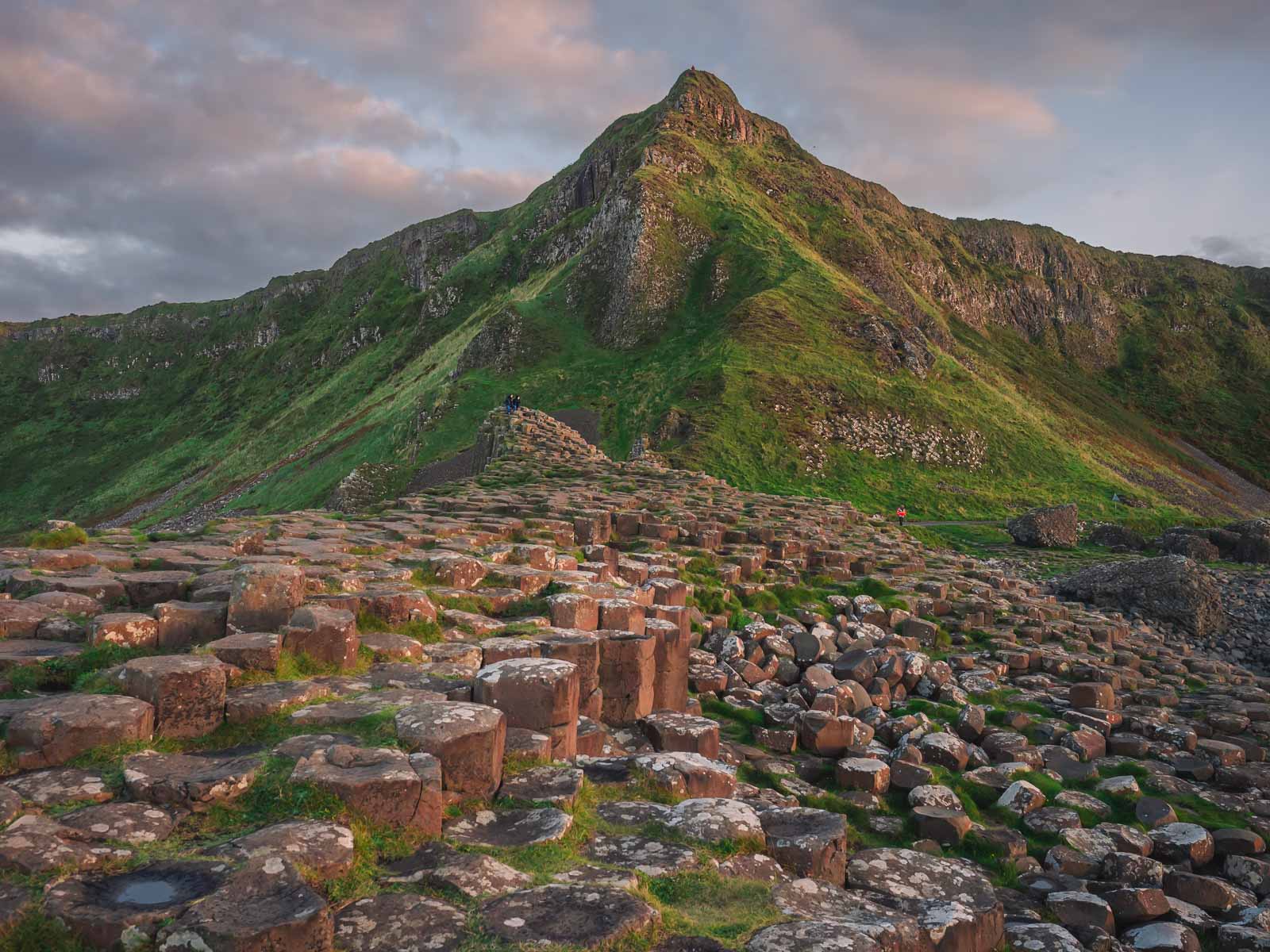
The Giant’s Causeway never ceases to amaze us; its basalt columns look like perfectly placed stepping stones leading out to the water’s edge. However, one of our Giant’s Causeway visits was less than stellar due to crowds, as we visited at the wrong time of day. So, to help you avoid making the same mistake we made on our first visit, we will share the best ways to visit the Giant’s Causeway from our other experiences exploring the North Antrim Coast of Northern Ireland.
This UNESCO World Heritage Site offers a magical landscape steeped in myth and beauty. Known for its unique basalt columns formed by ancient volcanic fissure eruptions, the Giant’s Causeway is Northern Ireland’s most popular attraction. It is truly incredible and lives up to the hype.
Where is the Giant’s Causeway
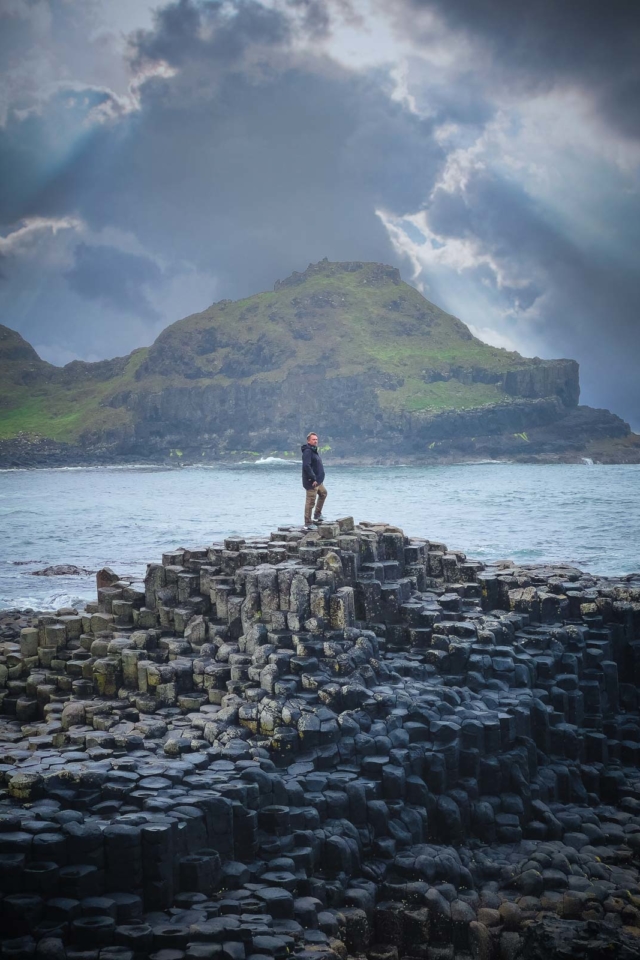
The Giant’s Causeway is located in County Antrim on the northeast coast of Northern Ireland, about 60 miles from Belfast. The best way to reach this iconic landmark is by car, allowing you to explore at your own pace. Check for Rental Car Prices here.
Driving from Belfast takes approximately 1 hour and 30 minutes via the M2 and A26, leading you through some of Northern Ireland’s most picturesque landscapes. It is just 2.5 miles north of Bushmills Village and 1 hour and 20 minutes from Belfast.
Public transportation options include train services from Belfast to Coleraine, followed by a connecting bus to the Causeway. There is a bus service from Balintoy Village.
If you don’t have a car, you can join a guided tour from Belfast or Derry/Londonderry, which often includes other attractions along the Causeway Coast.
The best time to visit The Giant’s Causeway
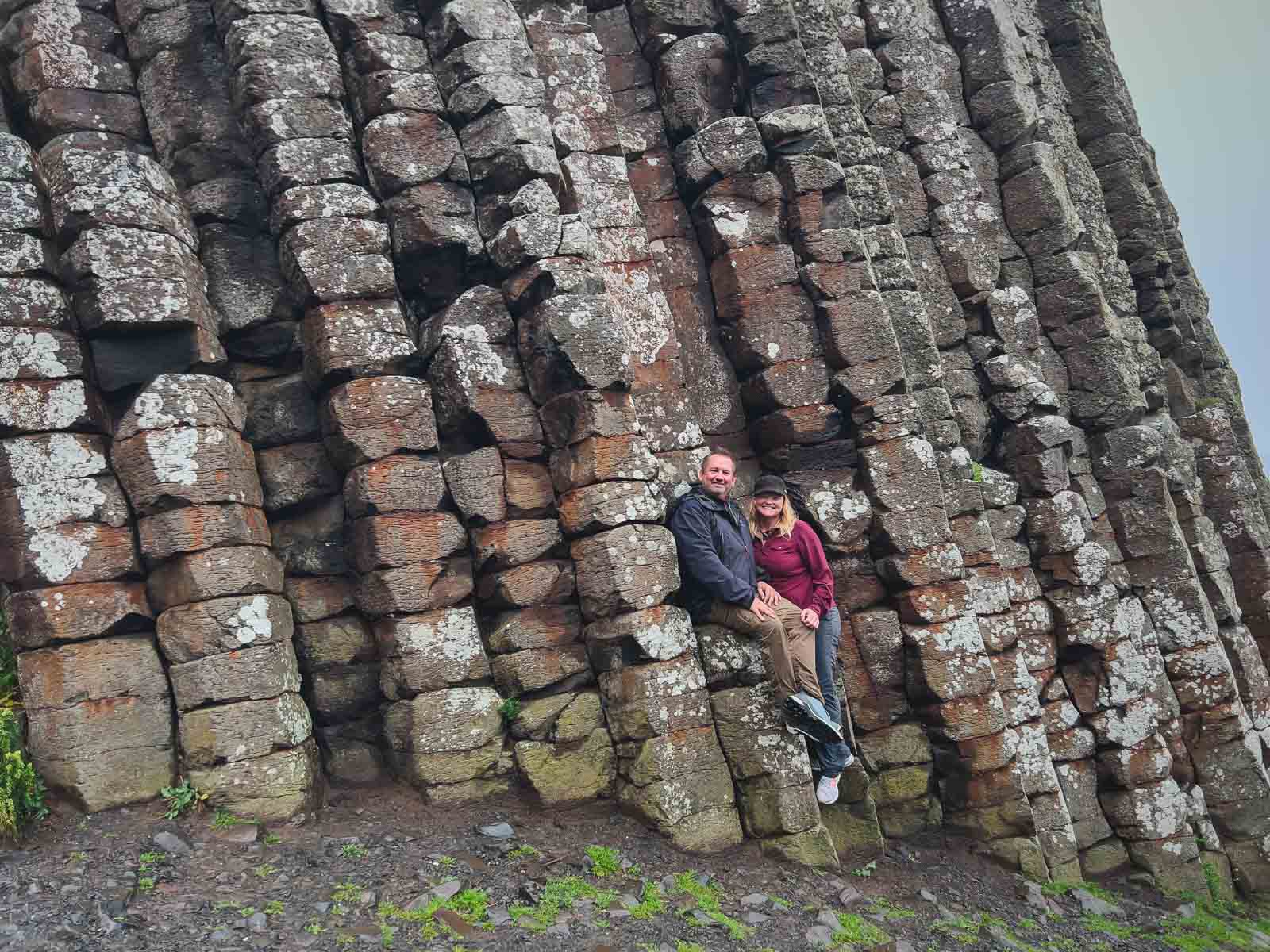
The Giant’s Causeway is open year-round so that you can visit anytime. However, the best times to explore this UNESCO World Heritage Site are the shoulder seasons of spring (April to June) and autumn (September to November).
During these months, visitors can enjoy mild weather and fewer crowds. Temperatures during these seasons average a comfortable 10°C to 15°C (50°F to 59°F), ideal for walking and photography.
While the summer months (July and August) promise warmer weather, with temperatures ranging from 15°C to 20°C (59°F to 68°F), they also bring the peak tourist season, resulting in larger crowds and longer wait times.
The winter months, though less crowded, can be challenging due to colder temperatures, around 5°C to 8°C (41°F to 46°F), and shorter daylight hours.
Best Time of Day to Visit
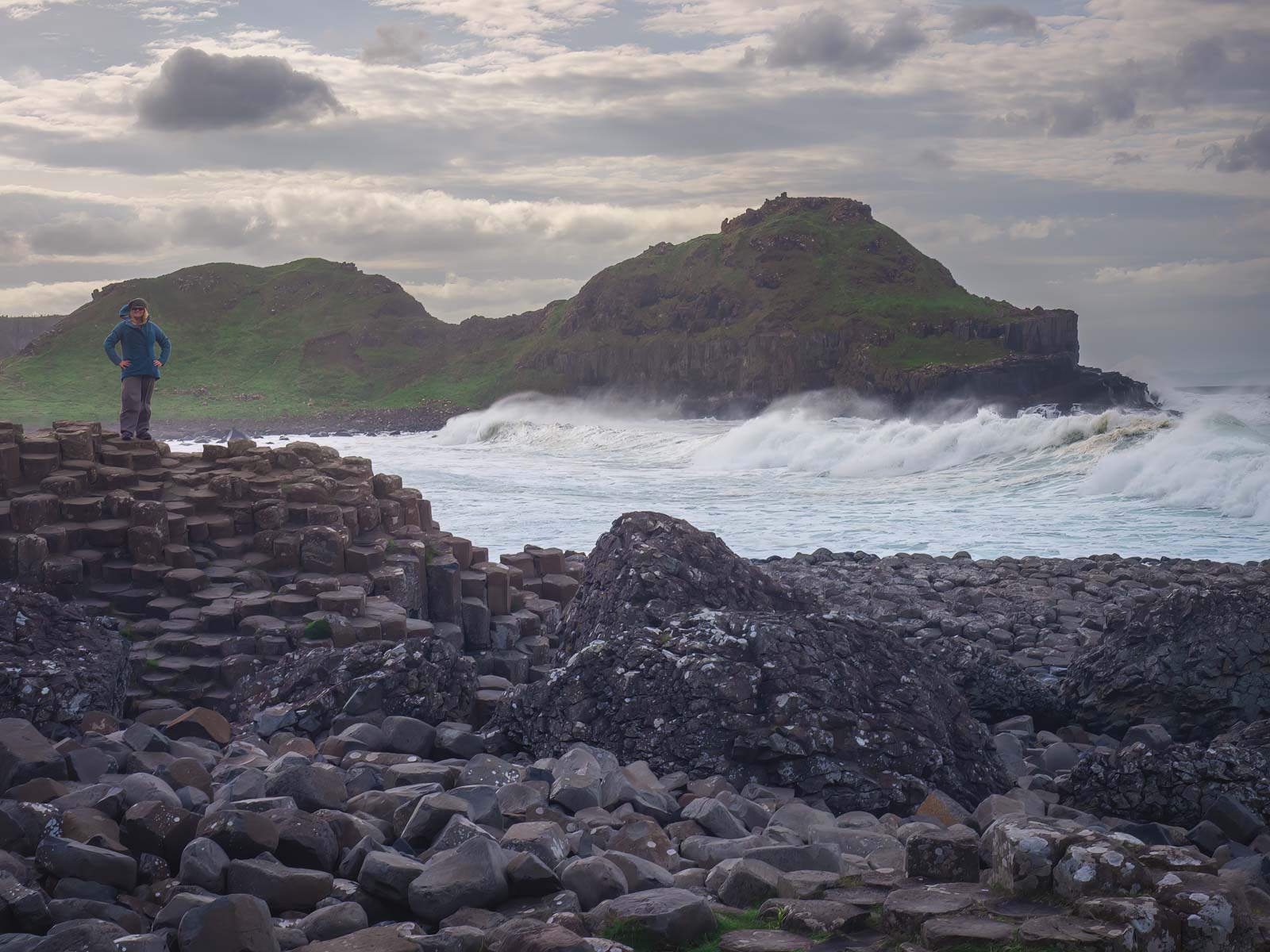
The best time to visit the Giant’s Causeway during the day is at sunrise or sunset. The Visitor Centre is open from 9:00 AM to 5:00 PM daily, but you can visit outside of opening hours.
To truly appreciate its splendor without the crowds, aim to visit either early in the morning or late in the afternoon. We visited both times in different years and times of year, and both times, we had it virtually to ourselves. Plus, the softer light made for stunning photographs, and we enjoyed quieter moments while roaming the site.
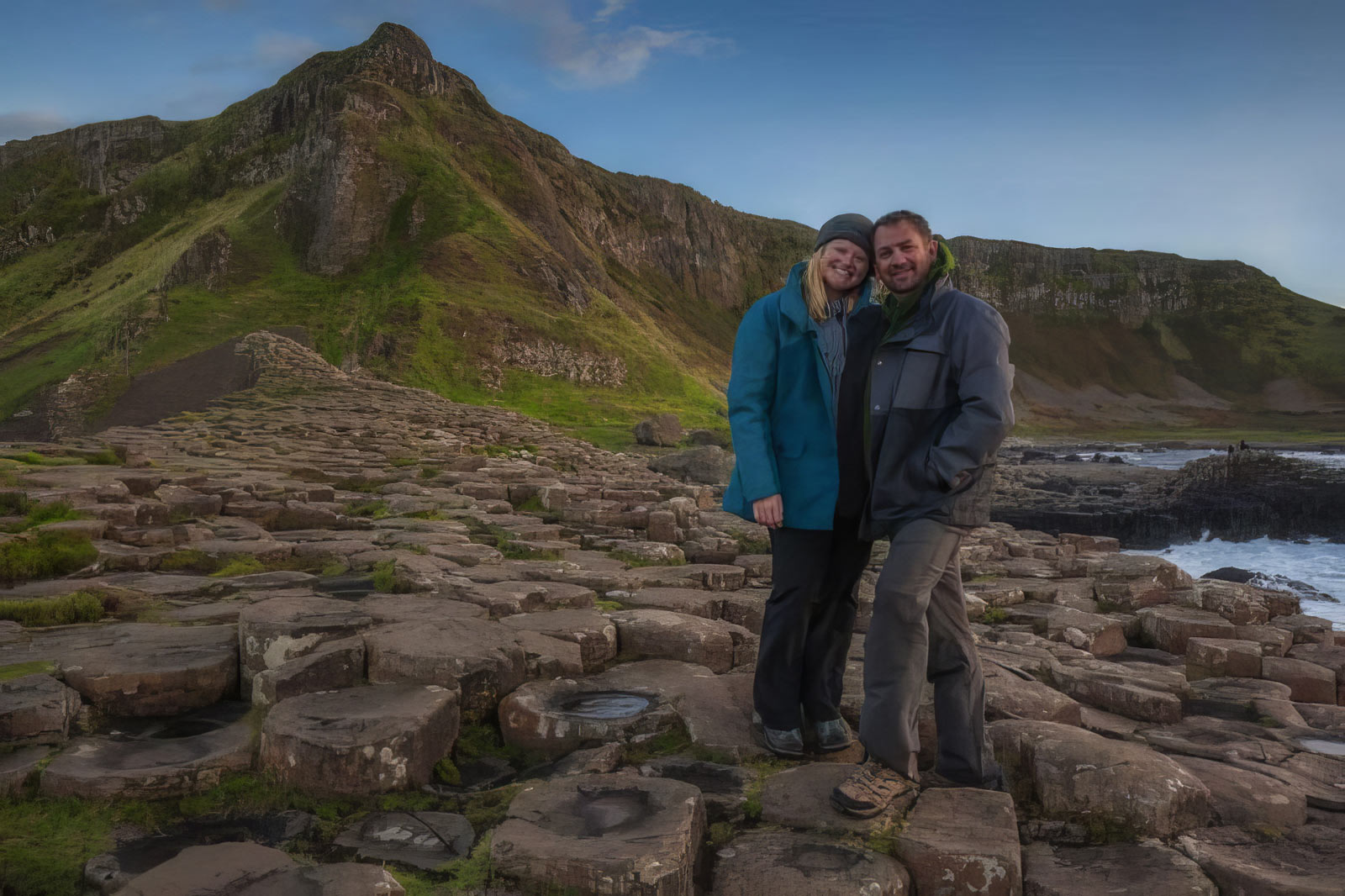
We walked down at sunrise well before the visitor center opened and could hike all over the weathered rock formations, taking in views from different angles. By the time the buses started arriving, we had our fill and went back to the hotel for breakfast.
We did the same thing at night. Once the buses left, we walked down to watch the sunset with two other people. It is truly magical to be along the Giant’s Causeway.
The one time we were on a bus tour, we arrived in mid-day, and it was chaos.
Many people visit the Giant’s Causeway on a road trip around the Causeway Coast or as part of a day tour from Belfast. The guided tours and bus tours stop at the Giant’s Causeway starting at 10 am, so if you can get in before that, you will have a better time.
What is the Giant’s Causeway
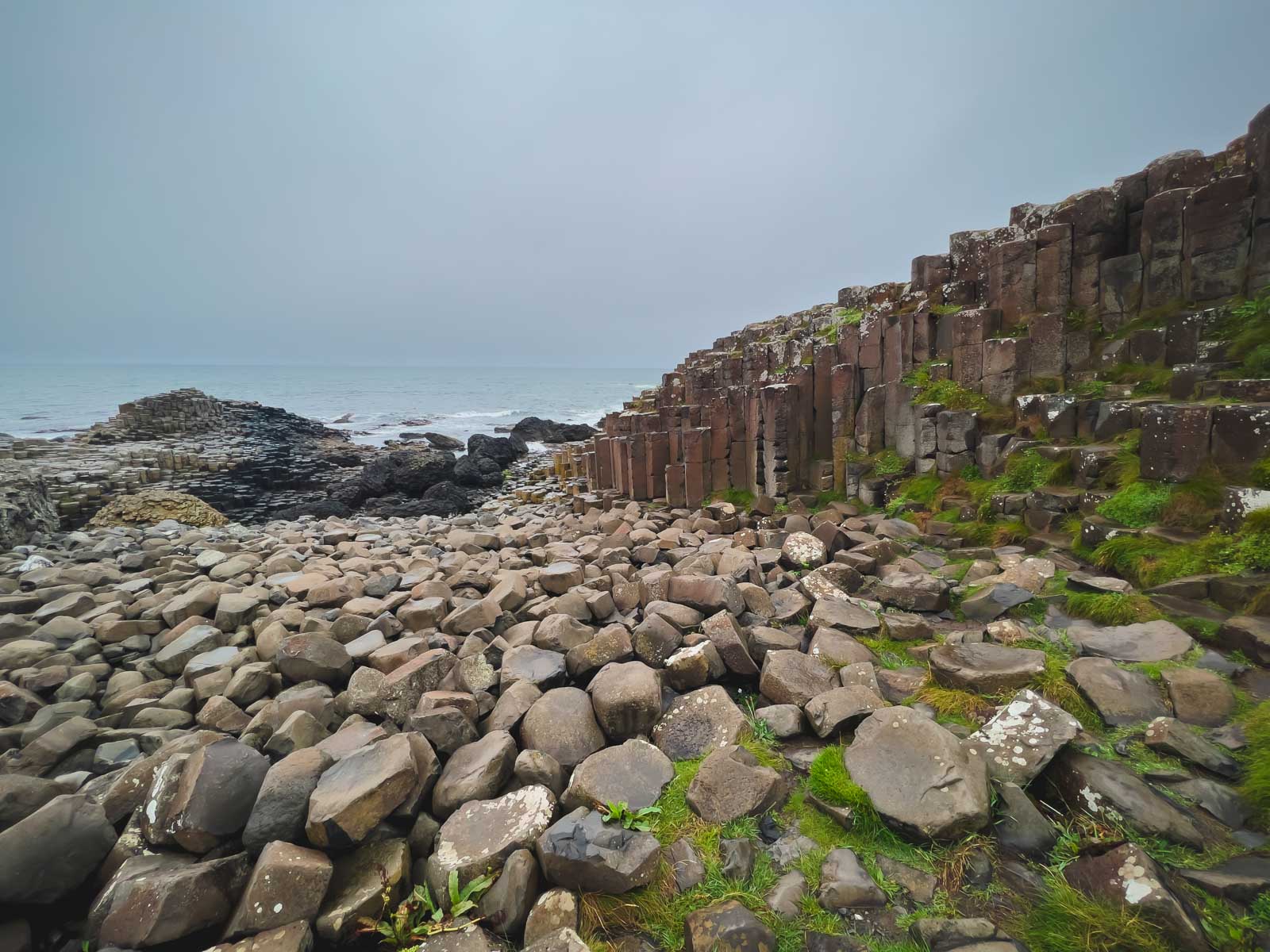
The Giant’s Causeway is a unique natural phenomenon of exceptional beauty, easily making its designation as a UNESCO World Heritage Site. It was formed 60 million years ago during a volcanic eruption, and it is truly a wonder of the world. There are more than 40 thousand basalt columns that are perfectly stacked, creating what looks like a giant set of interlocking bricks leading out to the sea.
The basalt columns were formed during the eruption when the flowing lava crashed into the sea waves. As the ocean cooled the lava, it turned it into volcanic stones. Similar basalt columns exist worldwide, including in Iceland and across the sea; you can visit the Scottish Island Staffa Flow (Isle of Staffa) to see Fingals Cave, another amazing sight formed by volcanic activity.
Giant’s Causeway Visitor Centre
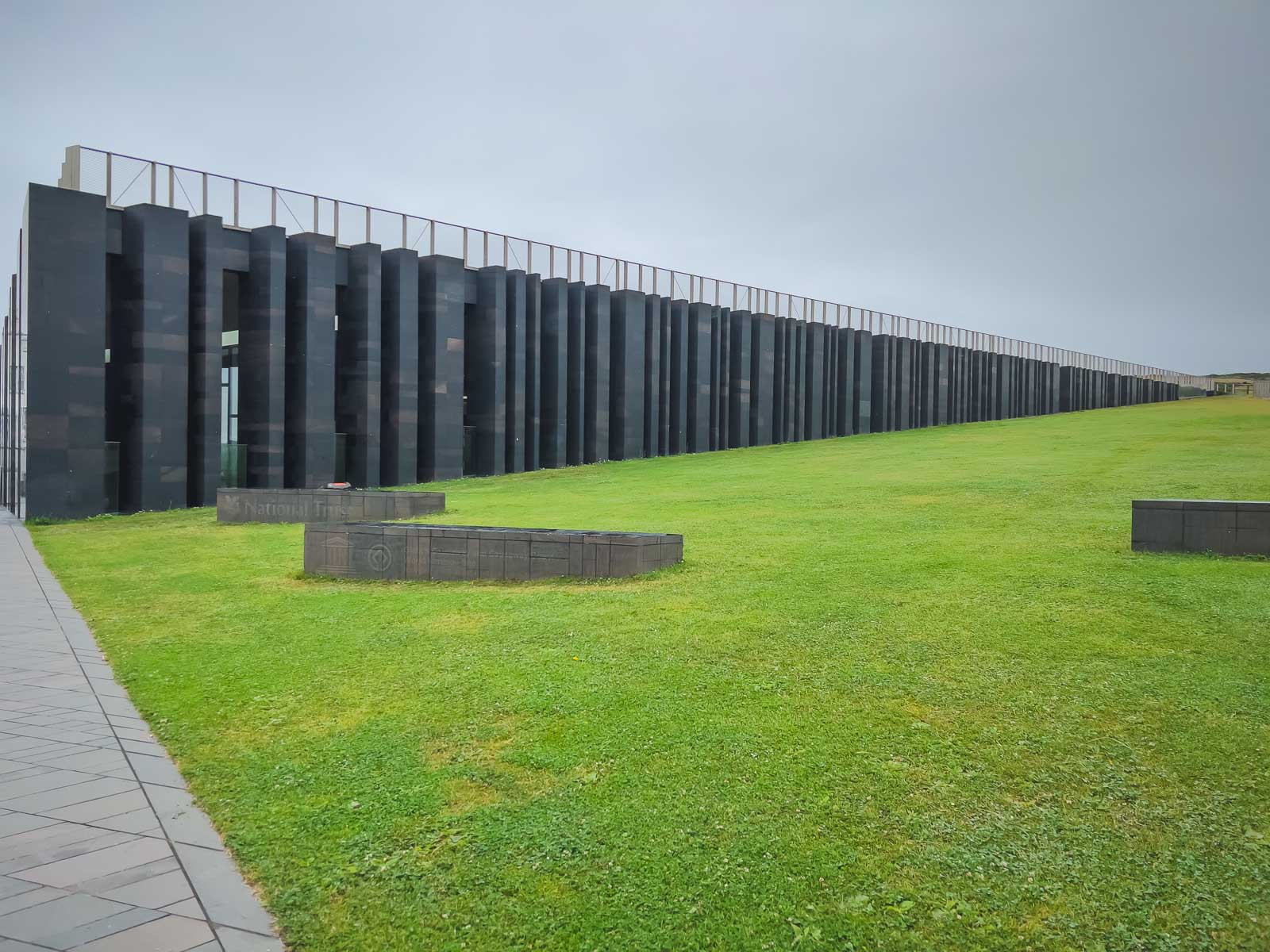
The Giant’s Causeway is run by the National Trust, an organization that promotes the preservation of natural and architectural wonders. The Trust has created a Visitor Center to enhance the visitor experience with interactive displays and an interpretation area that blends seamlessly with the landscape.
Entrance is free if you have a National Trust Membership. Since most tourists obviously won’t have a membership, let’s go through the coasts.
If you stay at the Causeway Hotel, you can also visit the Giant’s Causeway for free.
Prices vary, but current entrance fee rates of £13.50 for adults and £6.70 for children offer value for those interested in learning more about the area’s geological and mythological background. National Trust members can enjoy free entry and parking. Prices change at peak season.
The Giant’s Causeway Visitor Centre opens at 10:00 am and closes depending on the time of year, anywhere from 5 pm to 9 pm. But you can visit it alone and walk down anytime if you stay at the Causeway Hotel. From the parking lot, you will walk through a tunnel taking you to the Blue Trail which is a half-mile walk downhill.
Driving and Car Park Locations
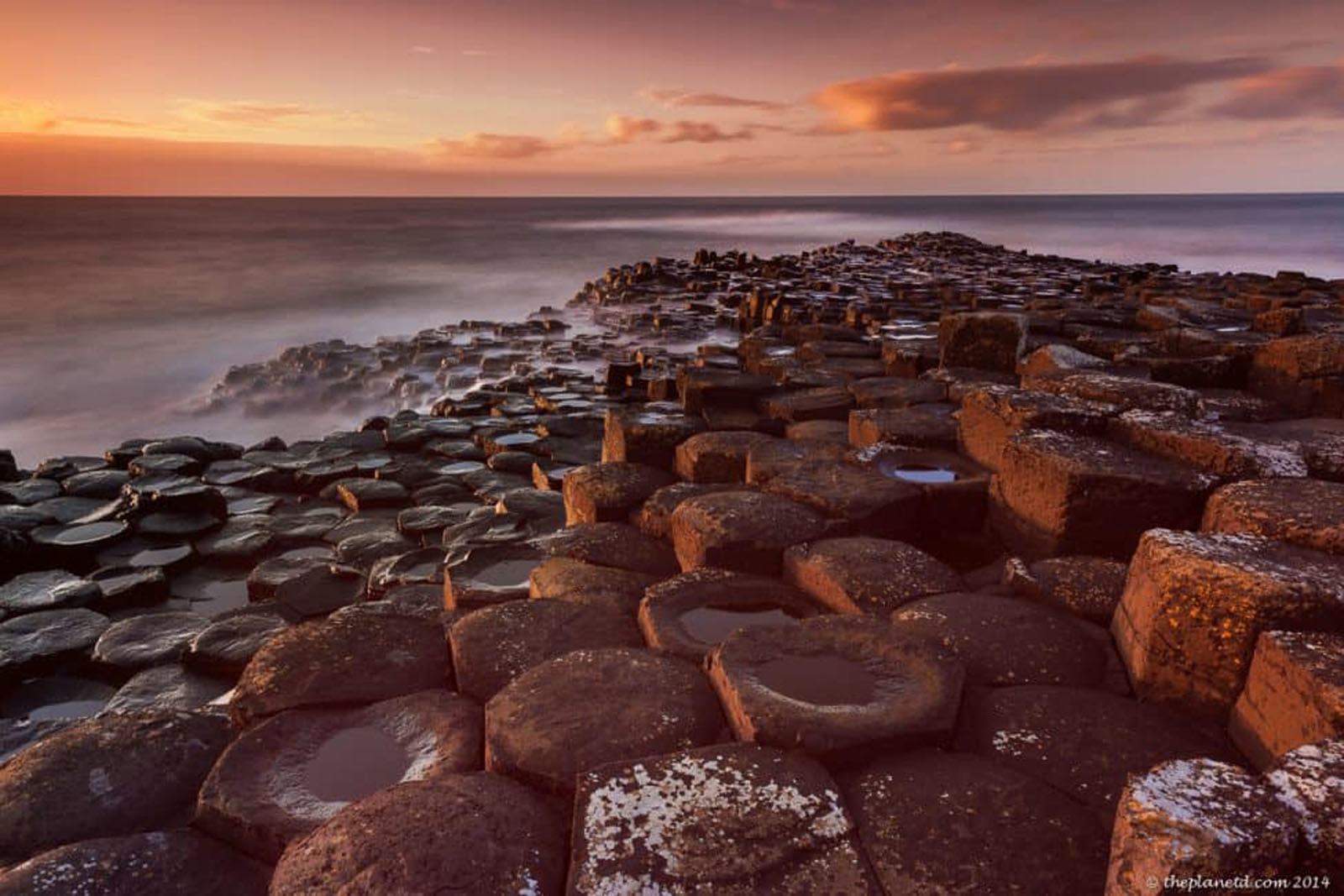
If you are not staying at the Causeway Hotel, you will need to pay for parking, or you can walk. Some of the guest houses near Giant’s Causeway are not too far away, either. There are some good hiking trails to the Giant’s Causeway as well, and if you are up for a hike, you can walk from Dunserverick Castle or Portballintrae.
If you are driving, you will need to purchase a parking ticket. Using the car park closest to the visitor center costs £13 per person, adding up quickly. The cost for parking is £13 per adult in the car. £32.50 for a family and £6.50 for children.
That makes The Causeway Hotel an even more desirable option. When you stay here, parking and entrance is free.
There is another car park along the Causeway Road, The Causeway Coast Car park costs £10 and is an easy walk to the visitor centre.
When you purchase a ticket online, it includes parking, a guided tour, and audio guides. You can also access the Visitor Centre, the exhibition, café and souvenir shop.
Guided Tours
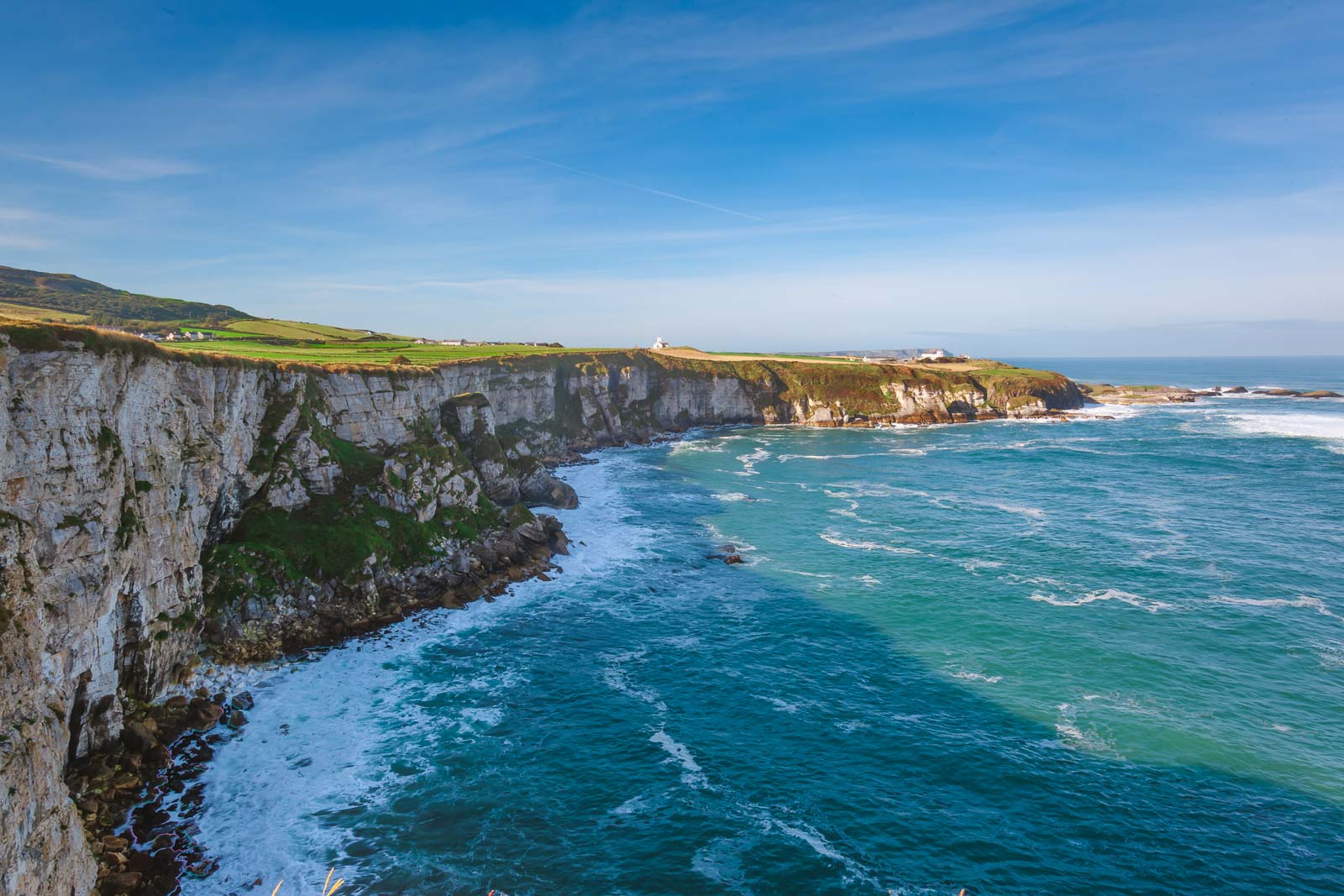
We realize that most people will not want to drive on the other side of the road and there are plenty of guided tours from Dublin , and Belfast . Plus, if you book a tour, you won’t need to worry about any of these costs as they will all be included. Here are a couple of guided tours that we recommend that also explore more of County Antrim and Northern Ireland.
This full-day guided tour is highly rated and takes you along the Causeway Coastal Route to see the Carrick-a-Rede Rope Bridge, Dunluce Castle, The Dark Hedges, and Giants Causeway.
Giant’s Causeway Walking Trails
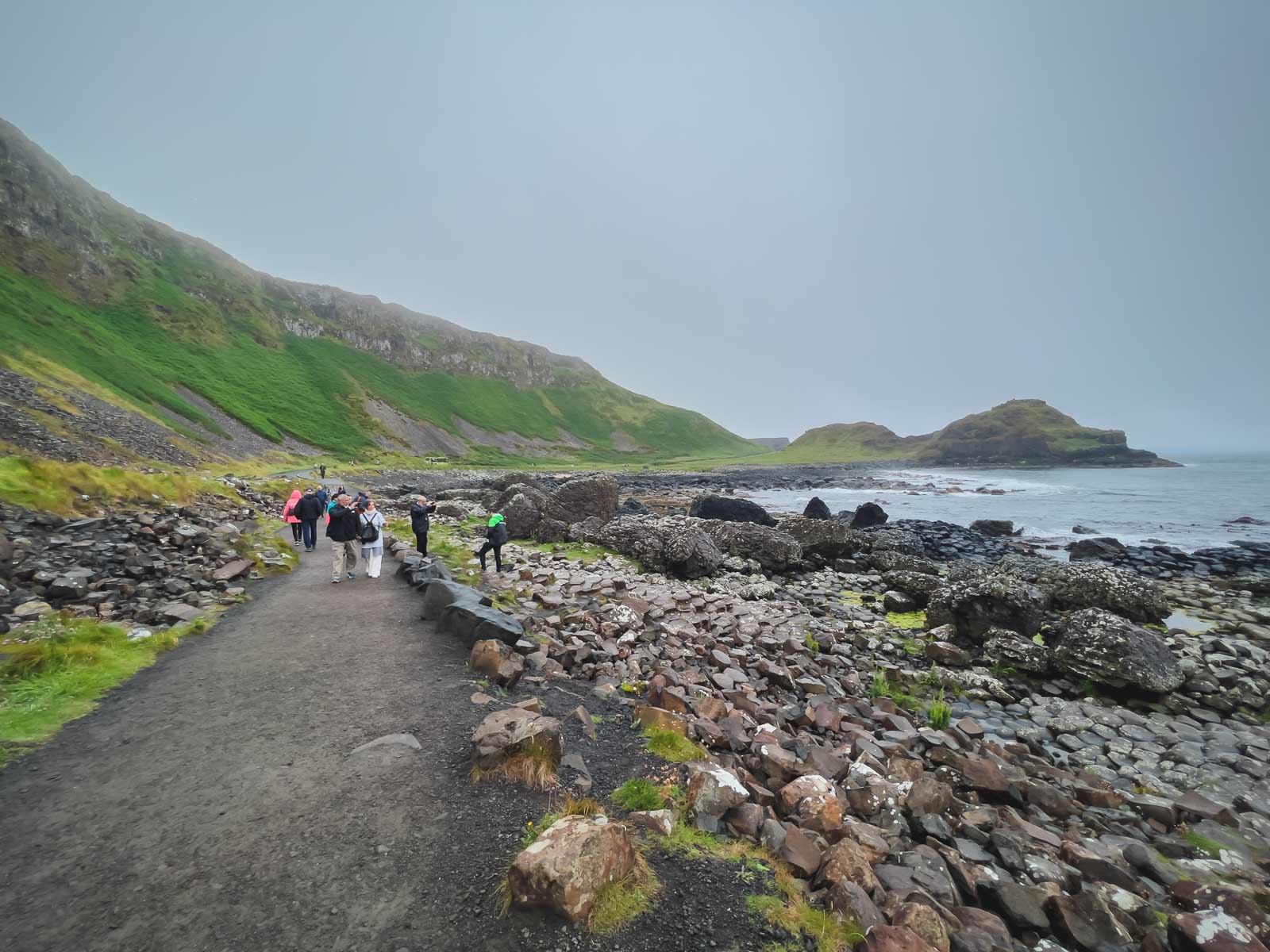
Blue Trail – This is the common trail that is along the paved road leading to Giant’s Causeway from the Visitor Centre.
Green Trail – This is a 3.2 km (2 miles) hike that takes 1.5 hours. This trail starts at the Causeway Hotel and follows the path toward path towards Runkerry Head. This trail is suitable for people with disabilities and is wheelchair friendly. It is also kid-friendly for buggies. This trail takes you out to see the Portcoon Cave, 150 yards long and 40-foot high, sea cave.
Red Trail – The Red Trail is a moderate trail that takes about 1.5 hours. It starts at the Giant’s Causeway visitor’s centre and goes along the top of the cliffs.
Yellow Trail – The Yellow Trail is a challenging hike that begins at Runkery Head and ends at Hamilton’s Seat. The trailhead is accessible near the village of Portballintrae and goes past the Causeway Hotel and Visitors Centre. You’ll meet up with the Blue Trail and can go down to the Giant’s Causeway or stay high to continue on the Yellow Trail. There are sheer cliffs on this path, so be careful.
Where to Stay at the Giant’s Causeway
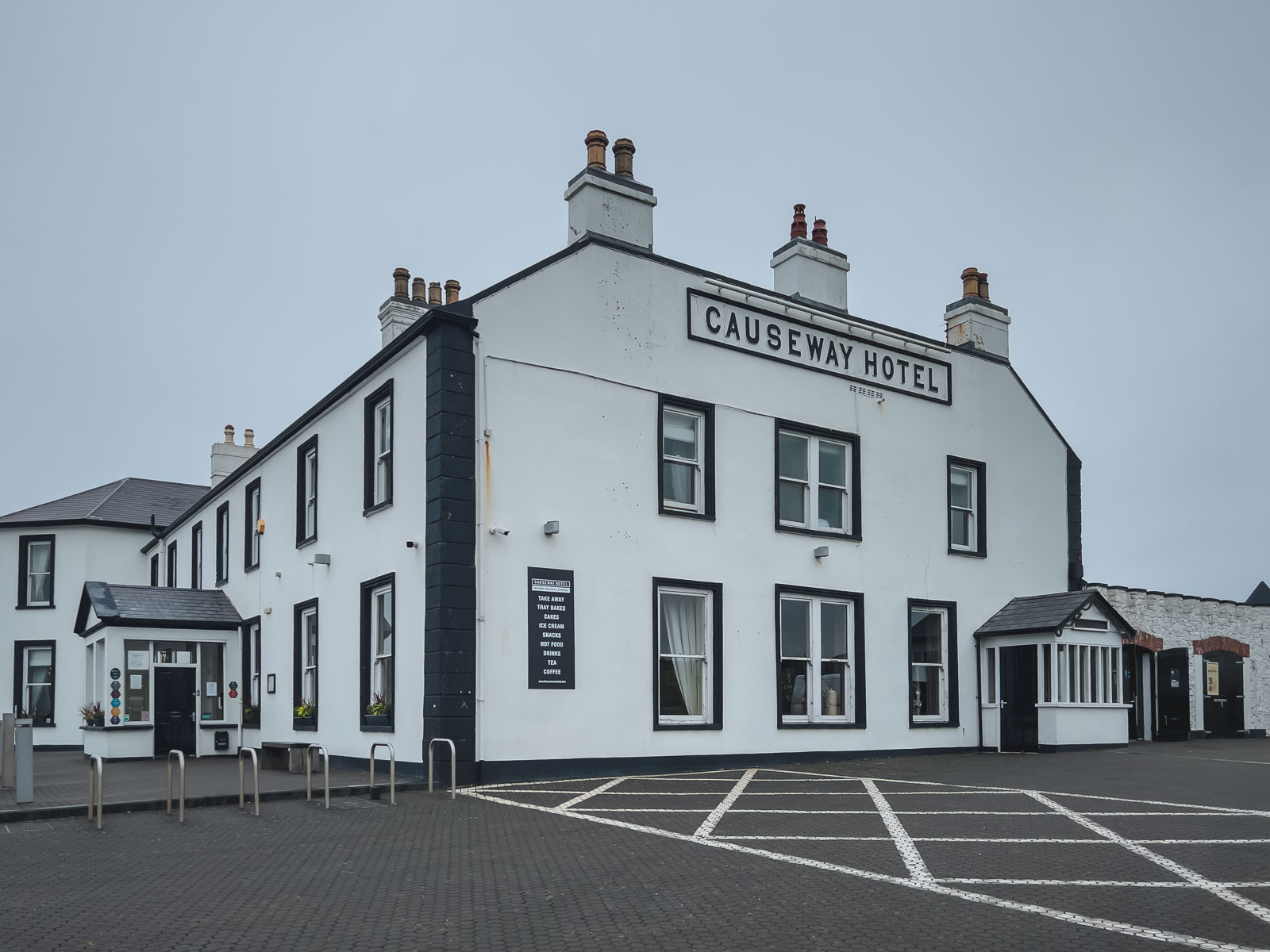
We highly recommend spending more time at the Giant’s Causeway than just on a quick day trip. The reason being is that if you join a tour, you will arrive at the Giant’s Causeway at midday with all the crowds. On two of our visits, we stayed at the Causeway Hotel and could walk down to see the Giant’s Causeway at sunrise and sunset. During these times of the day, we had it all to ourselves.
Causeway Hotel

The Causeway Hotel is the closest hotel to the Giant’s Causeway located directly at the visitor’s centre. But there are plenty of BnBs around the area and other hotels in Bushmills which is just 2.5 miles away. You can then easily drive to the Giant’s Causeway for sunrise or sunset. See reviews on TripAdvisor and Check prices on Booking.com
The Causeway Hotel has a bar and restaurant so you don’t have to leave at all and can spend maximum time at the Giant’s Causeway. The rooms are pretty basic, though, and need an update. What the rooms lack in ambiance is made up for in its location.
Bushmills Inn
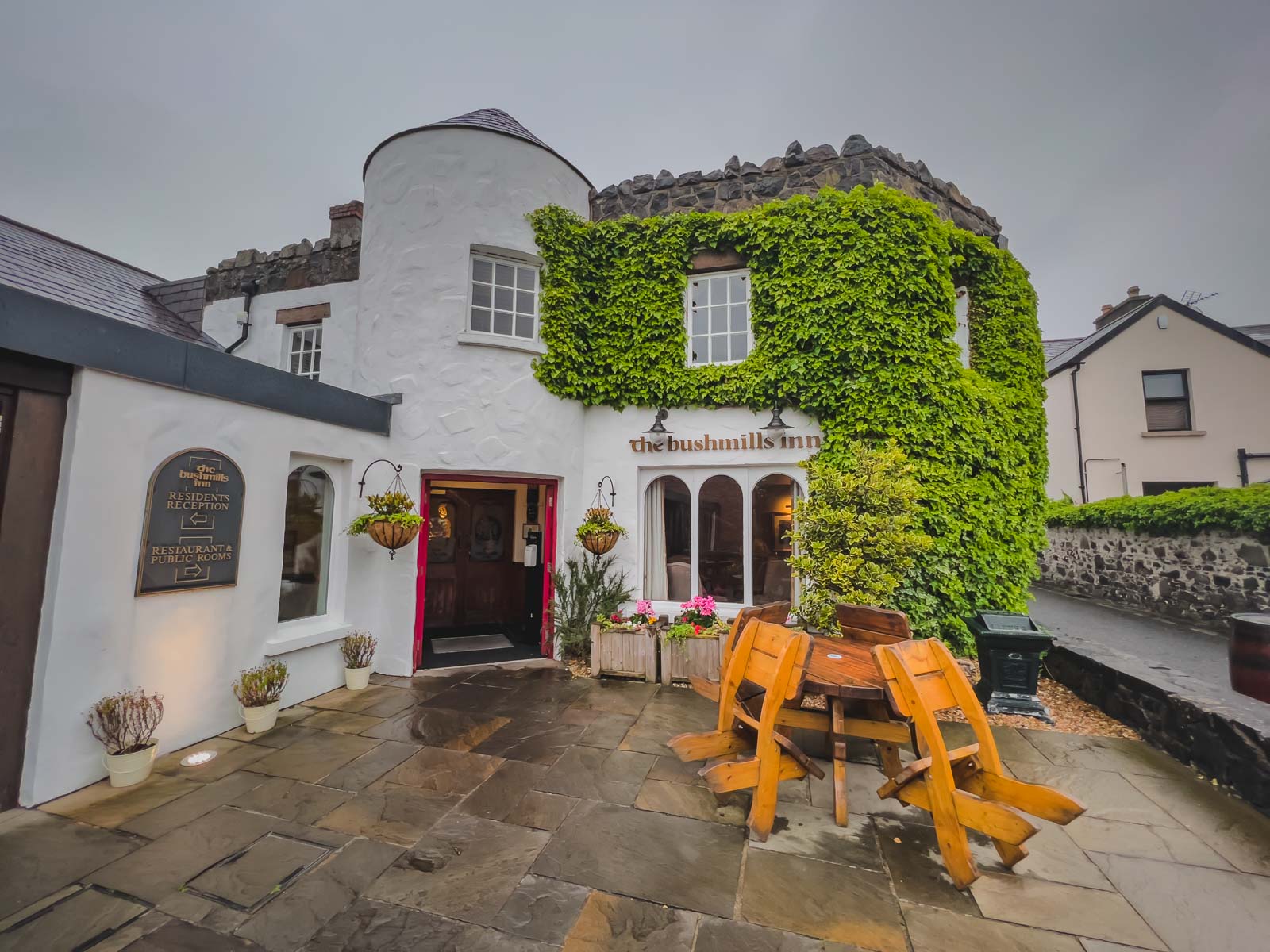
The Bushmills Inn is another great option located in town. We ate here and had an amazing meal. It dates back to 1600 and was a coaching inn at the time. It has been completely renovated and the rooms are now a 4-star luxury. If you want something more upscale and don’t mind needing to drive to the Giant’s Causeway, this is a great option. See reviews on TripAdvisor and Check Prices on Booking.com
Giant’s Causeway History – The Legend
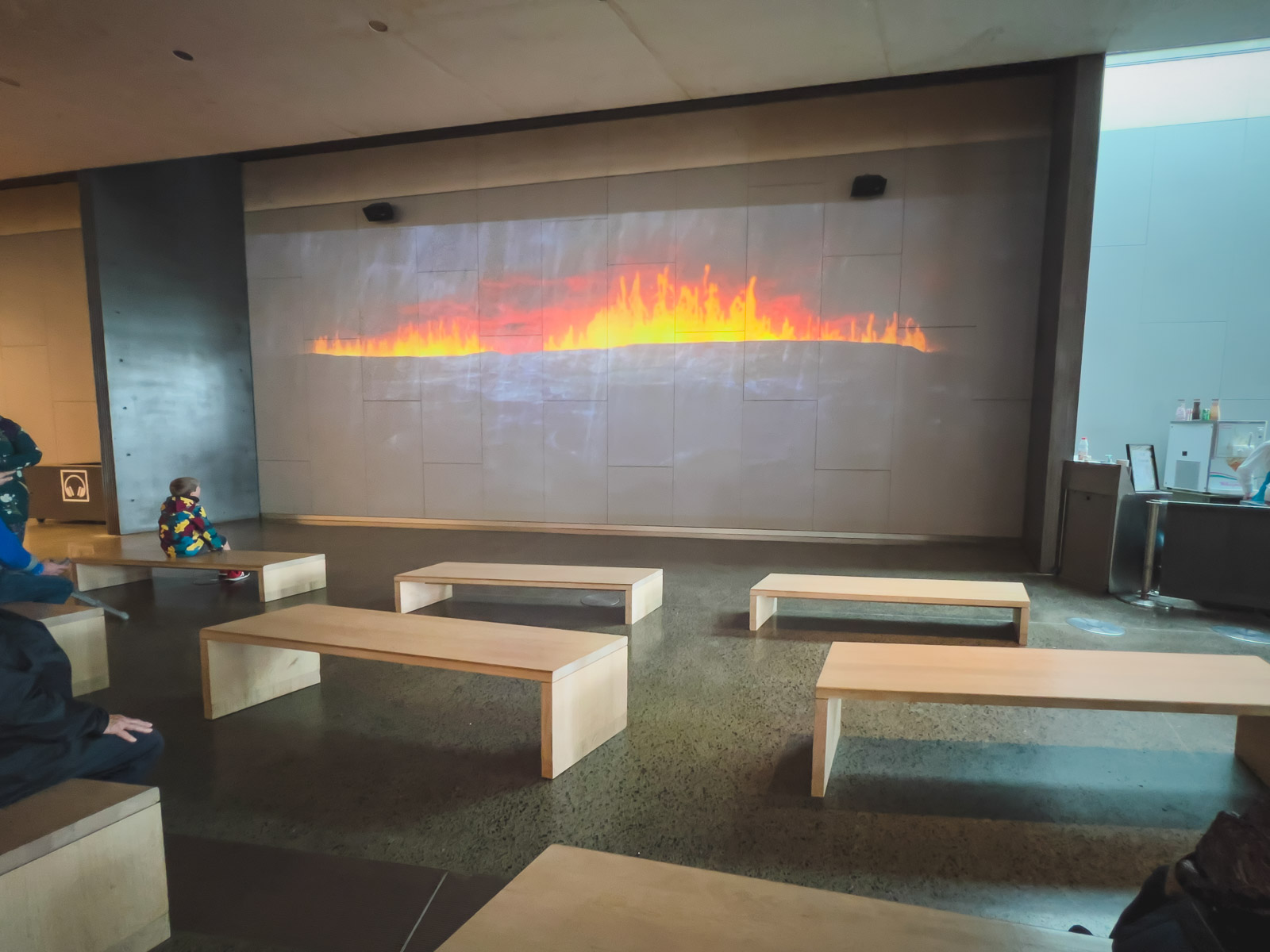
Inside the visitors center, there is a gift shop, a snack bar, and a coffee shop. There is also a film about the legend of the Giant’s Causeway involving the Irish Giant Finn McCool and the Scottish Giant Benandonner.
Before science, it was believed that the Irish giant Finn McCool made the Giant’s Causeway to create a bridge to Scotland to challenge his rival. Legend says that rivals Fionn Mac Cumhaill (Finn McCool) of County Antrim in Ireland were constantly bickering with the Scottish Giant Benandonner.
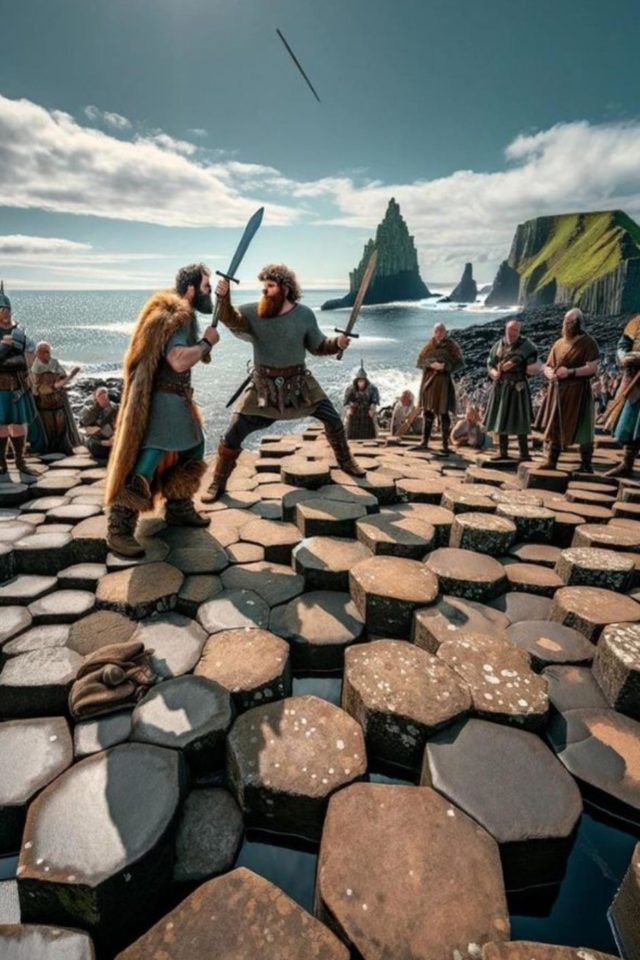
One day Finn McCool decided to build a bridge to cross the sea and challenge Benandonner to a fight. It’s an easy legend to believe, as each stone seems to be placed there for a purpose. Read the full legend at The Legend of the Giant’s Causeway – Do You Believe?
The Actual History of the Giant’s Causeway
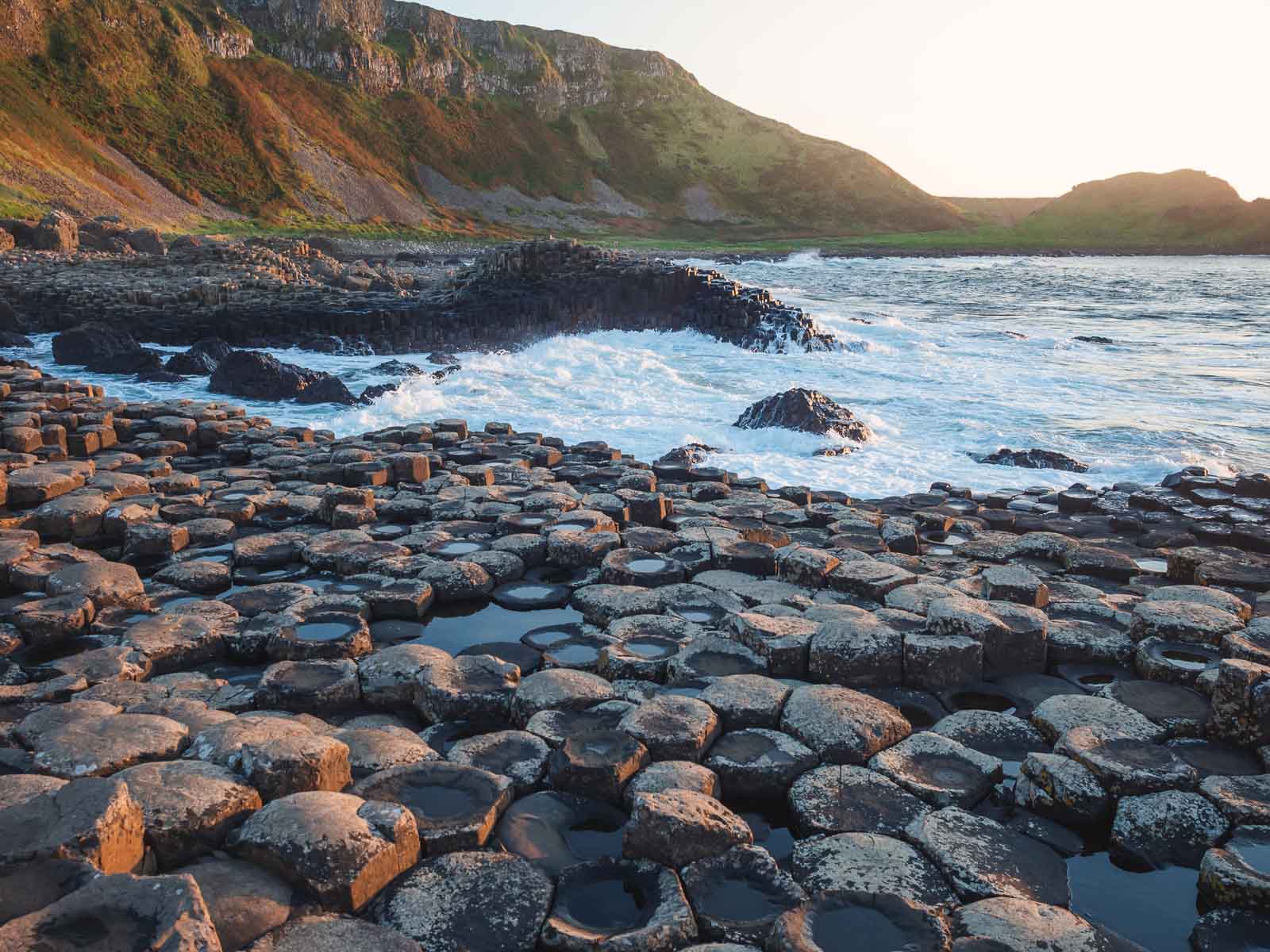
Formed over 60 million years ago due to intense volcanic eruptions, the Causeway is famous for its 40,000 interlocking basalt columns, creating a natural phenomenon that has intrigued visitors for centuries.
This blend of geological wonder and mythical tales, coupled with the site’s breathtaking natural beauty, makes the Giant’s Causeway a pivotal subject of study for geologists and a must-visit destination for tourists worldwide.
It is Northern Ireland’s only UNESCO World Heritage Site. Whether you’re drawn by the allure of its ancient origins or intrigued by the enchanting stories passed down through generations, the Giant’s Causeway offers a unique window into the past, making it an essential part of Northern Ireland’s cultural and natural heritage.
Mobility and the Giant’s Causeway
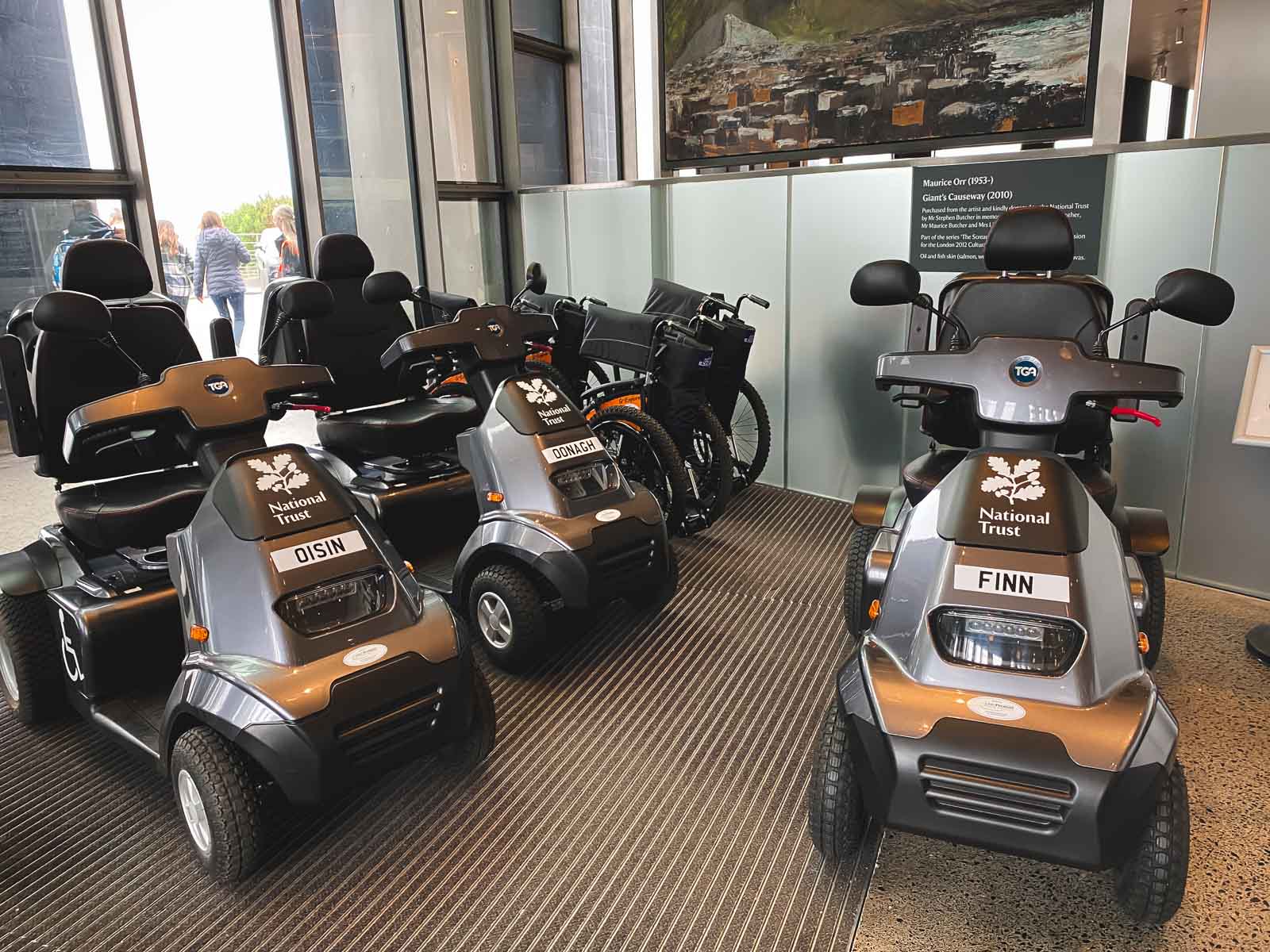
For those with mobility issues, there is a bus that you can take down and up to the Giant’s Causeway from the visitor’s center. They also have wheelchairs and scooters available to borrow at the Giant’s Causeway visitor centre. Note that they are available on a first come first serve basis. The bus costs
Things to do Near the Giant’s Causeway
After the morning visit, there are plenty of things to see and do nearby. Giant’s Causeway is located along the Causeway Coastal Route, and it is one of the most spectacular road trips on earth.
What to See and Do
Beyond the awe-inspiring basalt columns, the Giant’s Causeway area is rich in attractions worth exploring:
- The Visitor Centre : Start your visit here to delve into the Causeway’s fascinating geological and mythological stories.
- The Shepherd’s Steps : Challenge yourself by climbing these steep steps to be rewarded with panoramic views.
- The Giant’s Boot : Discover this curious rock formation that, according to legend, belongs to the giant Finn McCool.
- Dunluce Castle : A short drive away, the ruins of this medieval castle offer a glimpse into Northern Ireland’s storied past.
- Bushmills Distillery : No trip to County Antrim is complete without a visit to the world’s oldest licensed distillery, offering tours and tastings.
Dunluce Castle
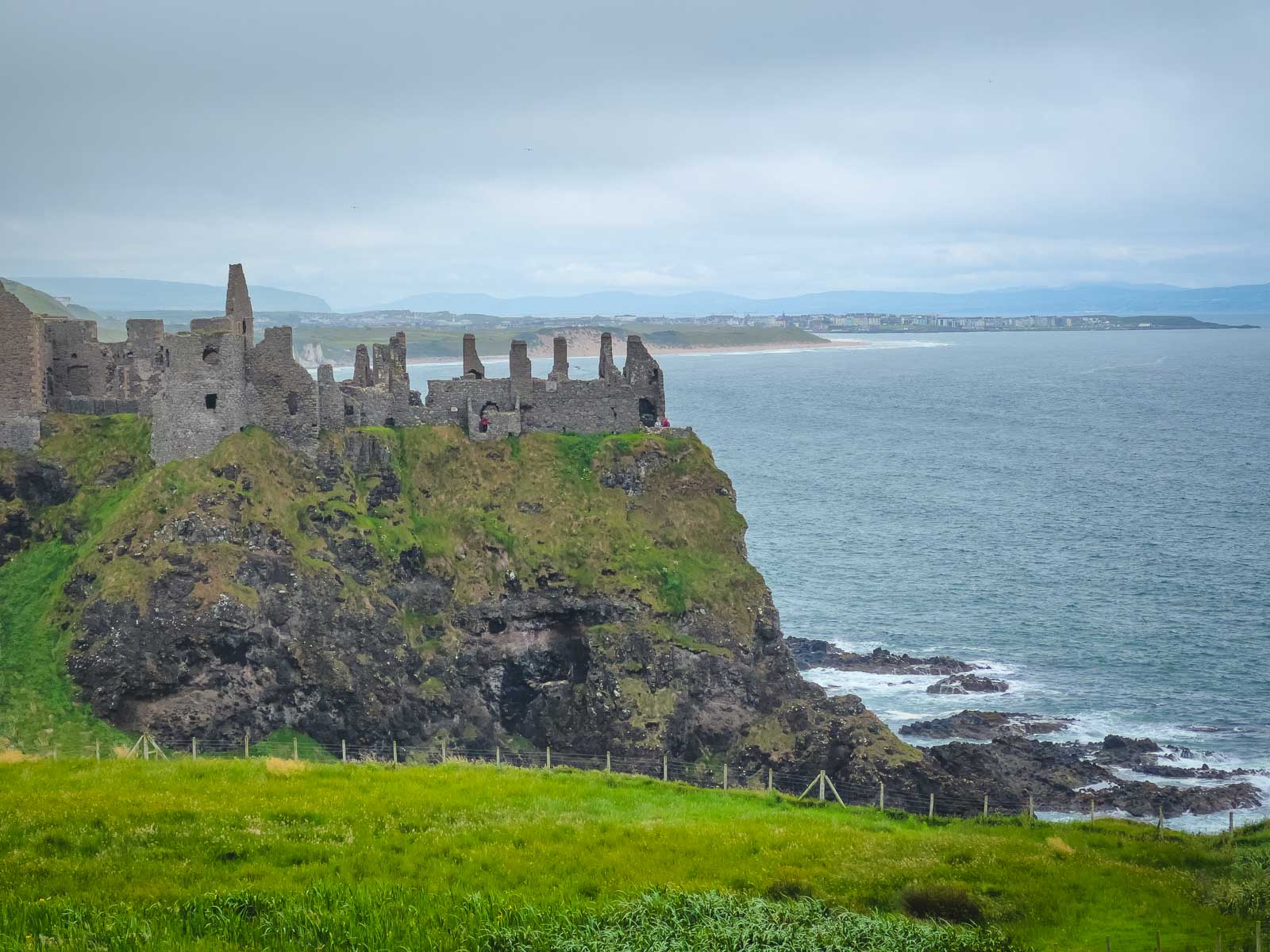
Dunluce Castle is a lovely stop located just 10 minutes from Giant’s Causeway. The ruins sit high on a cliff and are one of the most picturesque castles in Northern Ireland.
Make sure to continue driving west to stop at the viewing platform just a short distance further. This just opened this year, and there are two fantastic lookouts where you can see Dunluce Castle on one side and the high sea cliffs of Northern Ireland on the other.
Bushmills Distillery

Bushmills is Dave’s favourite whisky, and we always stop to pick up a bottle of their signature 16-year-old. You can do a distillery tour and it is highly recommended. Even if you don’t do a tour, you can get into the grounds for a peek and into the gift shop to purchase a bottle or two. Bushmills Distillery is located in Bushmills Village and is just a five-minute drive from Giant’s Causeway.
Dark Hedges
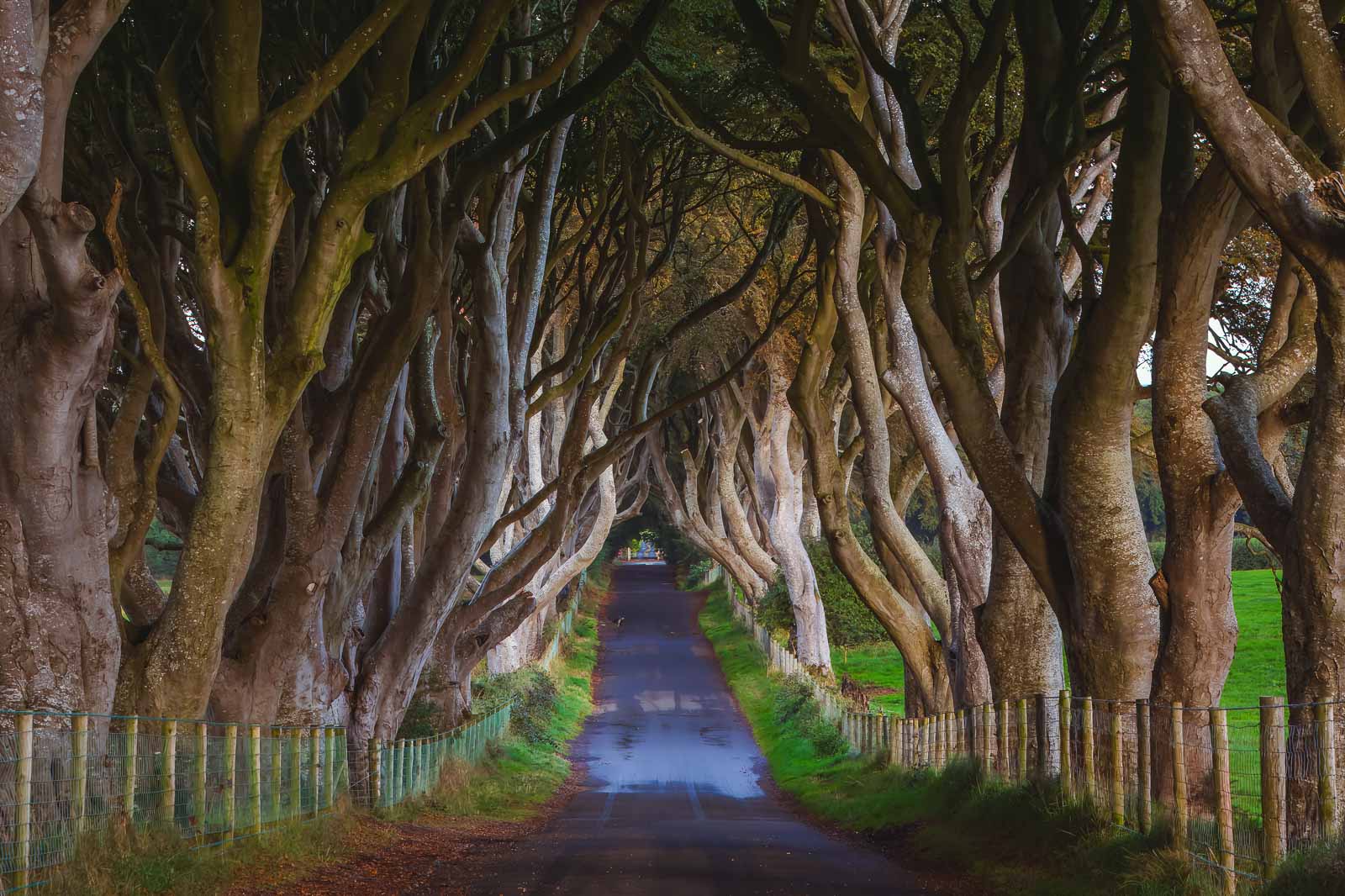
The Dark Hedges is 20 minutes from Giant’s Causeway and they are the most photographed place in Northern Ireland. The Dark Hedges are located on Bregagh Road near the town of Ballymoney in County Antrim. It is lined with 90 beech trees forming an arch all the way along the road. It was used as The King’s Road in Game of Thrones. Note: Some Dark Hedges have been cut down due to deteriorating conditions, but there are still many standing. Read more: The Dark Hedges of Northern Ireland – Tips to Visit and What you Need to Know
Carrick a Rede
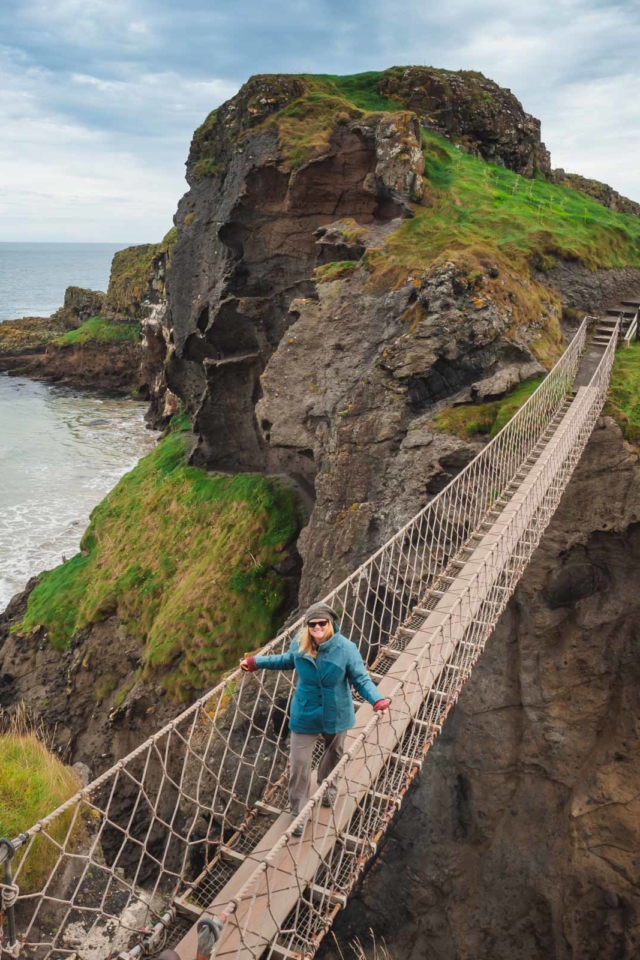
The Carrick a Rede Rope Bridge is another amazing stop that is located just 15 minutes from Giant’s Causeway. It was once a dangerous bridge to cross only used by fishermen, but today it has been restored and tourists can walk across this suspension bridge for unparalleled coastline views.
The Giant’s Causeway and the Causeway Coast are extraordinary places to visit. Spending time in this part of Northern Ireland will create memories to last a lifetime as you explore one of the most beautiful coasts in the world. Read more about the Causeway Coast at: The Ultimate Causeway Coastal Route Itinerary, Northern Ireland
Giant’s Causeway Belfast Tours

You can book day tours to the Giant’s Causeway from Belfast if you aren’t doing a self-drive around the Causeway Coastal Route. This highly rated tour takes you to see famous sights along the Antrim coast before reaching the Giant’s Causeway. Places you’ll see en route to the Giant’s Causeway are Cushendun Caves, Carnlough Harbour, and the Dark Hedges. Learn about the history from live commentary on board.
Another excellent option for a tour from Belfast to the Giant’s Causeway is this popular Game of Thrones Tour. You’ll enjoy the beauty of the Antrim Coast before hitting the world-famous Giant’s Causeway. During this guided day tour, you’ll stop at places like Carrickfergus Castle and the nine Glens of Antrim before seeing the coastal town of Ballycastle. It’s then time to see HBO’s Game of Thrones filming locations like Magharmorne Quarry, which is the location of Castle Black and the Dark Hedges, to see King’s Road.
From Dublin
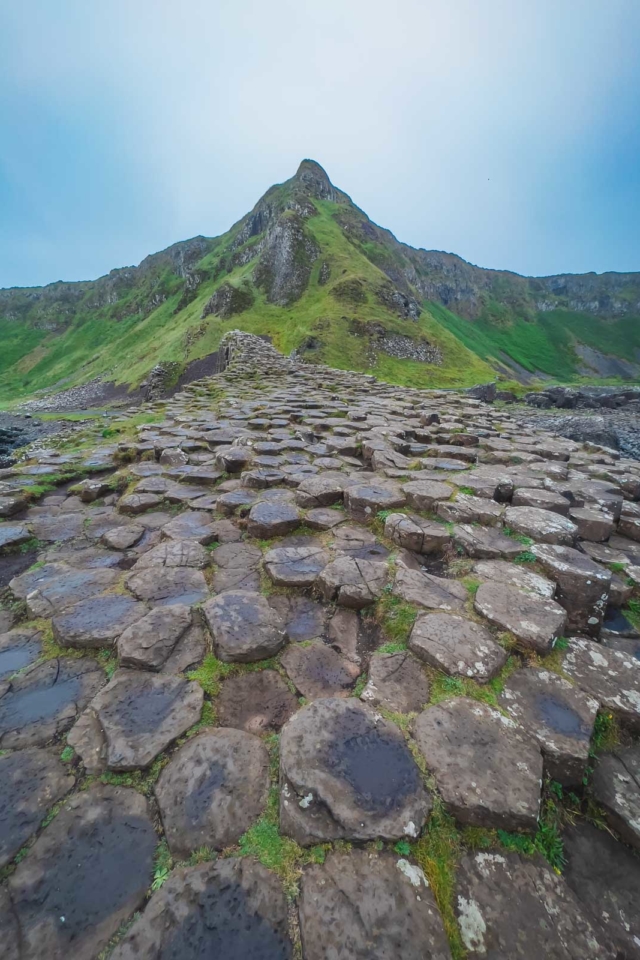
Tours to the Giant’s Causeway even be booked from Dublin. This highly rated tour is the perfect day trip for people with limited time but who still want to enjoy some of the top Northern Ireland destinations when they visit Ireland. Visit the Dark Hedges, Dunluce Castle, and Giant’s Causeway, and spend some time in Belfast on a guided tour from Dublin.
- Admire the formations of the Giant’s Causeway, a UNESCO World Heritage Site
- Head to Portaneevy View Point to see the Carrick-a-Rede Rope Bridge
- Marvel at the stunning scenery of the Antrim coastal route
- Hear stories of folklore and history with a few myths and legends too
- See some of the Game of Thrones sites throughout the day
Other Places with Columns in the World
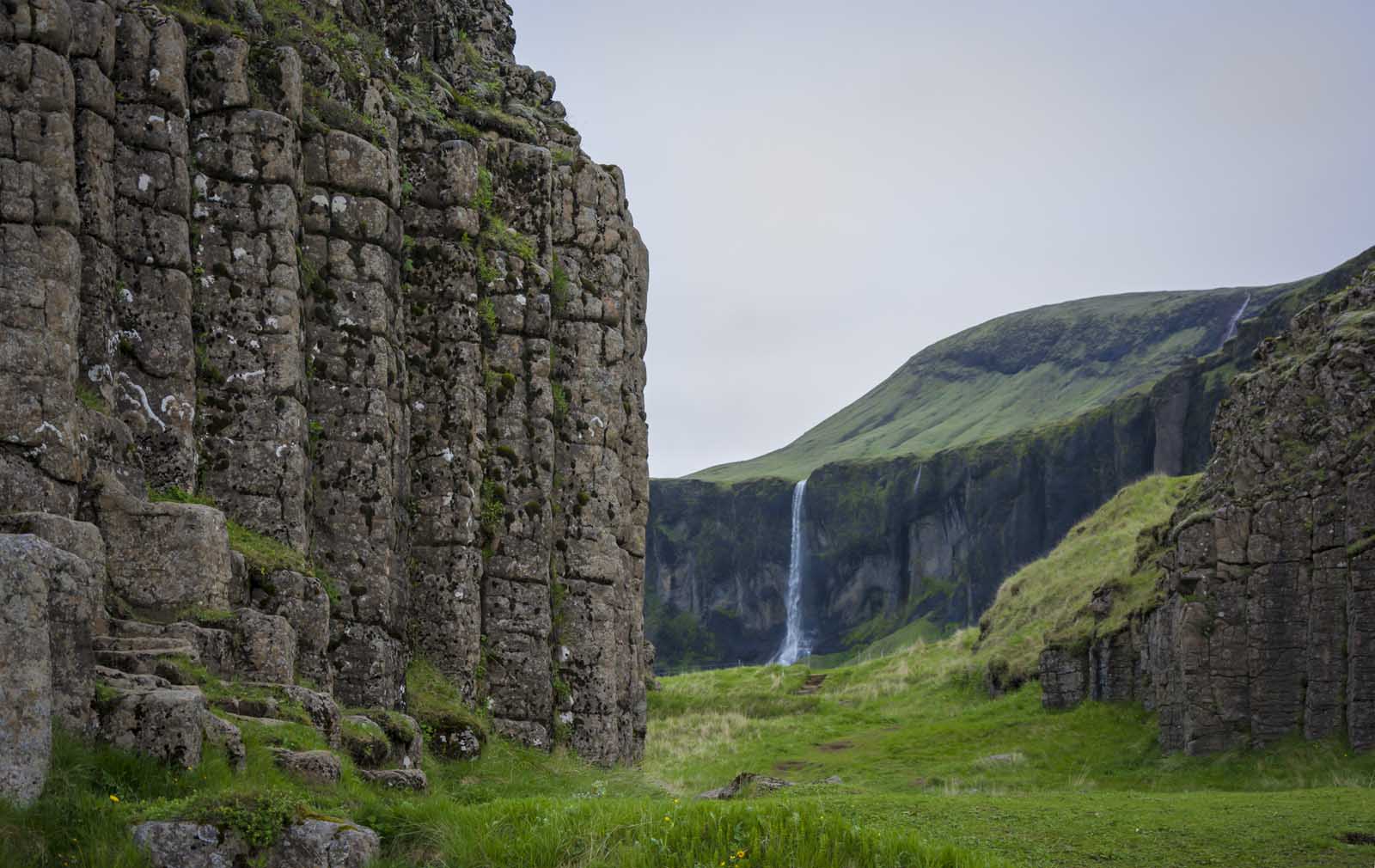
A quick Google search will show you that there are dozens of hexagonal columns around the world. We noted Iceland and Scotland, but they can be found from Mongolia to Thailand. Ones that we’ve seen with our own eyes are Iceland, Namibia, Australia, and California. We even recently saw incredible formations in Santiago Chile.
If you aren’t driving, this is a good day tour that includes visiting the top attractions on the Causeway Coast including Giant’s Causeway, Dunluce Castle and the Dark Hedges. Visit RentalCars.com to see prices for car rentals from Dublin or Belfast.
Resources for Planning Your Trip to Northern Ireland
- Things to do in Belfast, Northern Ireland
- 27 Best Things to Do in Northern Ireland
- A Game of Thrones Tour of Northern Ireland
- The Dark Hedges of Northern Ireland – Tips to Visit and What you Need to Know
The Ultimate Causeway Coastal Route Itinerary, Northern Ireland
- Things to do in Derry – Londonderry, Northern Ireland
Travel Planning Resources
Looking to book your next trip? Why not use these resources that are tried and tested by yours truly.
Flights: Start planning your trip by finding the best flight deals on Skyscanner
Book your Hotel: Find the best prices on hotels with these two providers. If you are located in Europe use Booking.com and if you are anywhere else use TripAdvisor
Find Apartment Rentals: You will find the cheapest prices on apartment rentals with VRBO .
Travel Insurance: Don't leave home without it. Here is what we recommend:
- Allianz - Occasional Travelers.
- Medjet - Global air medical transport and travel security.
Need more help planning your trip? Make sure to check out our Resources Page where we highlight all the great companies that we trust when we are traveling.
You May Also Like

38 Best Things to Do in Belfast, Northern Ireland
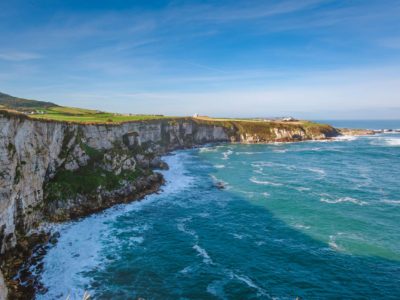
Things to do in Derry – Londonderry, Northern Ireland
About The Planet D
Dave Bouskill and Debra Corbeil are the owners and founders of The Planet D. After traveling to 115 countries, on all 7 continents over the past 13 years they have become one of the foremost experts in travel. Being recognized as top travel bloggers and influencers by the likes of Forbes Magazine , the Society of American Travel Writers and USA Today has allowed them to become leaders in their field.
Join thousands of others who get our monthly updates!
Leave a comment cancel reply.
Save my name, email, and website in this browser for the next time I comment.
1 thought on “How To Visit the Giant’s Causeway in Northern Ireland”
wow!! amazing write up. I got a lot of information about Northern Ireland. This is the best place of northern Ireland. Thanks a lot for sharing it.
The Complete Guide to the Giant's Causeway
:max_bytes(150000):strip_icc():format(webp)/NatalieKennedy-5acc5535303713003794200e.jpg)
Chiara Salvadori/Getty Images
National Trust - Giant's Causeway Visitor Centre
The Antrim coast is known for its unique and rugged beauty, but the most breathtaking stop of all is surely the Giant’s Causeway. Made up of 40,000 black basalt stone columns placed at the water’s edge, the Giant’s Causeway is an important geologic formation and a World Heritage site. The stone pillars rising from the sea attract almost a million visitors every year who come to marvel at the incredible natural wonder.
Know when to visit and find out how exactly the columns were created – here is the complete guide to the Giant’s Causeway in Northern Ireland.
News of the Giant’s Causeway generated a huge amount of interest when the existence of thousands of stone columns along the northern Irish coast was announced in London in 1693. The natural formation of rocks was discovered by the Bishop of Derry in 1692, but information about the magnificent place only really made a stir when it was reported in a paper published by Sir Richard Bulkeley of Trinity College a year later.
While written reports of the natural attraction have only existed for a few hundred years, the Giant’s Causeway is much older than that. The causeway was formed just under 60 million years ago when the landmasses of Europe and North America were still attached to each other. As the European landmass started to pull away, huge cracks were created on the earth’s surface. Molten lava was then able to come up through these gaps. Eventually, rivers formed when things cooled down and changed the new landscape even further.
It was during a second period of volcanic activity that the basalt rock columns that make up the Giant’s Causeway were actually formed. This time when the molten lava reached the surface, it encountered a rough landscape covered with soil. The specific conditions that existed in this exact spot 60 million years ago were so unique that the Giant’s Causeway is the only rock formation of its kind anywhere in the world.
In fact, when it was “discovered” in the 17 th century, scholars could not agree if the unique columns of basalt were natural or if they had been carved by man. The shape and number of the rock formations have been inspiring artists and stirring imaginations ever since and have even resulted in a beloved local legend about the history of the site.
The Legend of the Giant’s Causeway
There is really no doubt that the Giant’s Causeway was created by volcanic activity, but the formation takes its name from a popular local legend that claims it was built by an Irish giant named Fionn mac Cumhaill—better known as Finn McCool.
Finn McCool was actually not that large when it came to giants, and he stood at a mere 52 feet and 6 inches tall, but that did not stop him from picking a fight with a much larger Scottish giant named Benandonner.
Finn and Benandonner spent their days yelling at each other across the Sea of Moyle until they finally agreed to meet to test their strength and decide once and for all who was the mightier giant. Finn even offered to build the pathway—a causeway—across the Irish Sea to make the meeting possible.
Finn set to work and built a path to the Scottish isle of Staffa, which his rival giant called home. However, the work of building the causeway was so exhausting that Finn had to lie down and sleep.
The next morning, Finn’s wife awoke to the deafening sound of heavy footsteps—it was the Scottish giant crossing the causeway for the long-anticipated meeting. Her husband was still asleep and she realized that he would be no match for the much larger Benandonner. Thinking quickly, she threw a nightgown over Finn’s sleeping form and covered his face with a bonnet.
When the Scottish giant arrived demanding to fight Finn, Finn’s wife whispered, “Be quiet! You’ll wake the baby!”
Benandonner took one look at the “baby” and turned and ran away back across the causeway. “If this is Finn’s baby,” he thought, “Finn himself must be truly enormous!”
The scared Scottish giant destroyed the pathway on his way out, ensuring that Finn could never follow him home. This ruined pathway is what we now know as the Giant’s Causeway.
What to See and Do
The Giant’s Causeway is a natural attraction, meaning it is entirely outside.
When visiting the beautiful outdoor area, the must-see stop is the Grand Causeway. This is the largest of the three rock outcroppings and the best place to see the hexagonal basalt columns that the causeway is famous for.
There are various walks that will loop visitors past some of the best-known formations and sights including the Harp, the Chimney stacks, and the Camel, who served as Finn McCool’s horse according to legend and can be spotted by his humps which lie at the bottom of the cliffs.
You will find gorgeous views of the Giant’s Causeway at Port Noffer, a picturesque bay that wraps around the rock formations. Here you will find a path to the water where one particular rock draws a lot of attention. Shaped like a gigantic shoe, this stone is known as the Giant’s Boot and supposedly belonged to Finn McCool.
Another picture-worthy stop is at the Wishing Throne, where the rocks have formed a natural throne fit for a king. Find your seat (it is well worn away now), and snap a photo.
The one-of-a-kind rock formations of the Giant’s Causeway have also created a unique habitat for seabirds, plants, and insects. Keep an eye out for the amazing biodiversity as you follow the paths along the rocks.
Finally, there is a lovely and award-winning visitors center designed by Heneghan Peng , which opened in 2012. The unique architecture is designed to look like the natural black stone columns that make up the Giant’s Causeway. Inside are interactive exhibits about the geology and history of the site, audio guides (which can be taken out on walks), and a cozy cafeteria with free Wi-Fi.
Location and How to Visit
The Giant’s Causeway is part of the larger Causeway Coast which skirts the Atlantic Ocean for 33 miles in County Antrim , Northern Ireland.
The easiest way to reach the Giant’s Causeway is by car, and there is parking on site. The visitors center and access to the rocks can be found off the B147 Causeway Road, about two miles outside the village of Bushmills. From April to October, there is also a free shuttle from the village to the center, and visitors receive a green discount if they arrive this way.
Several buses also stop at the Giant’s Causeway, including Ulsterbus Service 172 and the open-top Causeway Coast Service 177.
The most unique way to arrive is via train using the Giant's Causeway and Bushmills Railway Company . The small railroad is now used as a tourist attraction, but it was first built in the 1880s. It reopened for service in 2002 and now runs between the town of Bushmills and the Causeway Hotel, with daily departures in July and August and a weekend-only timetable for September and October.
The best time to visit the Giant’s Causeway is between April and October when the weather is relatively mild. The outdoor site is open every day from dawn to dusk, which means longer hours in summer when there is more daylight. Note that the trails may not be accessible in very bad weather due to the risk of landslides.
Accommodations
The most iconic place to stay near the Giant’s Causeway is at the classic Causeway Hotel. The three-star hotel was recently remodeled and has maintained its traditional charm while adding modern touches. Best of all, the property is a five-minute walk from the visitors center.
There are also numerous B&Bs in the village of Bushmills that are close to the site but offer a town setting, which is lacking at the stand-alone Causeway Hotel.
What Else to Do Nearby
The natural wonder is located just outside the village of Bushmills, which happens to be famous for its whiskey. Plan a visit to the Old Bushmills Distillery to learn more about how the drink is made, and then (of course) taste a few samples.
The ruins of Dunseverick Castle are less than five miles from the main outcroppings of the Giant’s Causeway and make up part of the coastal cliff-top walk along the area. It dates back to at least the 5 th century, which is when Saint Patrick is said to have visited.
About a 20-minute drive away, you will find Dunluce Castle , which also lies in ruins. However, the picturesque crumbling walls and fallen towers are so precariously placed next to steep ocean drop-offs that this is easily one of Ireland’s best castles even in its ruined state.
After admiring the views at Dunluce Castle, carry on to Carrick-a-Rede rope bridge. The dangling bridge is only 66 feet long, but it sways 100 feet over the crashing waves of the Atlantic Ocean and will literally take your breath away. Remember to exhale, and then cross the one-of-a-kind bridge to explore Carrick-a-Rede island and learn about its 350 years of fishery history.
The Top 10 Things to Do in County Antrim
Dunluce Castle: The Complete Guide
The 7 Best Day Trips from Belfast
8 Places of Myth and Legend in the United Kingdom
Carrick-a-Rede: Ireland's Exhilarating Rope Bridge
Every UNESCO World Heritage Site in the UK
Touring Northern Ireland in a Week
The Top 20 Places to See in Ireland
The 16 Most Beautiful Natural Features in the UK
Your Trip to Ireland: The Complete Guide
The Top 22 Things to Do in Ireland
Top 10 Game of Thrones Sites to Visit in Northern Ireland
The Top 20 Things to Do in the UK
The 11 Best Castles to Visit in Ireland
How to Spend 5 Days in Ireland
9 Romantic Things to Do in Ireland
Take advantage of the search to browse through the World Heritage Centre information.
Share on social media
Unesco social media, giant's causeway and causeway coast.
- Description
The Giant's Causeway lies at the foot of the basalt cliffs along the sea coast on the edge of the Antrim plateau in Northern Ireland. It is made up of some 40,000 massive black basalt columns sticking out of the sea. The dramatic sight has inspired legends of giants striding over the sea to Scotland. Geological studies of these formations over the last 300 years have greatly contributed to the development of the earth sciences, and show that this striking landscape was caused by volcanic activity during the Tertiary, some 50–60 million years ago.
Description is available under license CC-BY-SA IGO 3.0
Chaussée des Géants et sa côte
Au pied des falaises qui bordent le plateau d'Antrim en Irlande du Nord, la Chaussée des Géants, composée de quelque 40 000 colonnes de basalte, s'enfonce doucement dans la mer. Elle a inspiré des légendes où des géants l'utilisaient pour franchir la mer jusqu'en Écosse. Les études géologiques qui lui ont été consacrées depuis 300 ans ont contribué au développement des sciences de la Terre et montré que ce paysage spectaculaire s'expliquait par des activités volcaniques datant du tertiaire, il y a quelque 50 à 60 millions d'années.
ممر العمالقة وساحله
عند قدم المنحدرات الصخرية المحيطة بهضبة أنتريم في ايرلندا الشمالية، ينغمس ممر العمالقة المؤلف من 40000 عمود من البزلت بهدوء في البحر. وقد شكل مصدر ايحاء لعدد من الأساطير حيث كان العمالقة يستخدمونه لعبور البحر حتى اسكتلندا. وساهمت الدراسات الجيولوجية التي خصصت له منذ 300 عام في تطور علوم الأرض وأثبتت ان روعة هذا المنظر تعزى الى نشاطات بركانية يعود تاريخها الى الزمن الجيولوجي الثالث أي من 50 الى 60 مليون سنة.
source: UNESCO/CPE Description is available under license CC-BY-SA IGO 3.0
“巨人之路”位于北爱尔兰安特令平原边沿,沿着海岸坐落在玄武岩悬崖的山脚下,由大约40 000个黑色玄武岩巨型石柱组成,这些石柱一直延伸到大海。这个令人称奇的景观使人们联想出巨人跨过海峡到达苏格兰的传说。300年来,地质学家们研究其构造,了解到它是在第三纪(大约5000-6000万年前)时由活火山不断喷发而成的。这个状观景点同时大大推动了地球科学的发展。
Calzada y Costa del Gigante
Al pie de los acantilados que bordean la meseta de Antrim, en Irlanda del Norte, la Calzada del Gigante, formada por 40.000 columnas de basalto, se hunde suavemente en el mar. Su fantástica apariencia ha inspirado leyendas de gigantes que cruzaban el mar por ella hasta las costas de Escocia. Los estudios de que han sido objeto estas formaciones geológicas en los tres últimos siglos han contribuido al desarrollo de las ciencias de la tierra, mostrando que este paisaje espectacular fue originado por la actividad volcánica de la Era Terciaria, hace unos 50 o 60 millones de años.
ジャイアンツ・コーズウェーとコーズウェー海岸
source: NFUAJ
Giant’s Causeway en Causeway kust
De Giant’s Causeway ligt aan de voet van de basaltrotsen langs de kust, aan de rand van het Antrim-plateau in Noord-Ierland. De rotsformatie bestaat uit zo’n 40.000 massieve zwarte basaltzuilen die uit de zee steken. De dramatische aanblik was inspiratie voor legendes over reuzen die over zee naar Schotland liepen. De Causeway-kust - zo'n zes kilometer lang - toont een ongeëvenaarde weergave van geologische formaties, het gevolg van vulkanische activiteit tijdens het Tertiairtijdperk, zo’n 50 tot 60 miljoen jaar geleden. Geologische studies van deze formaties gedurende de afgelopen 300 jaar hebben veel bijgedragen aan de ontwikkeling van de aardwetenschappen.
Source: unesco.nl
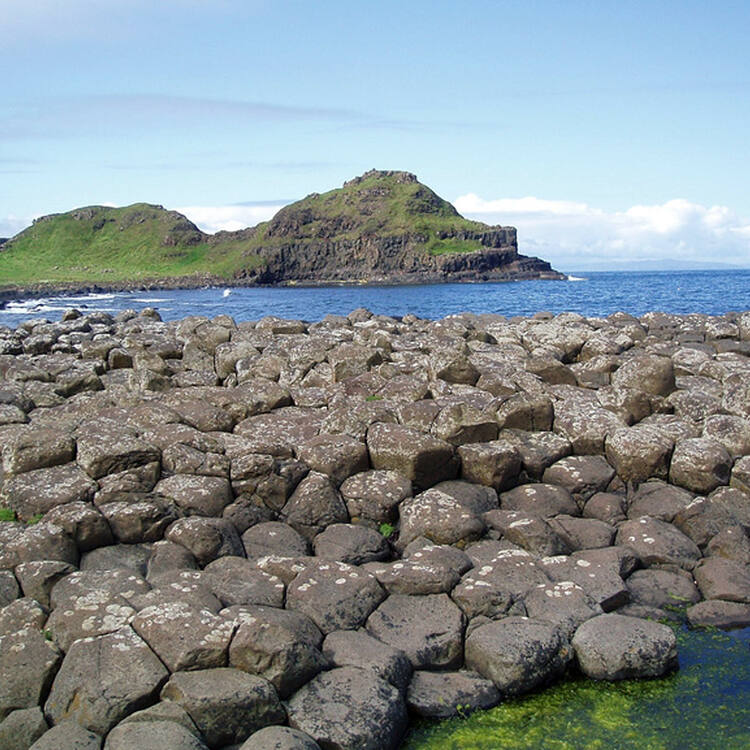
Outstanding Universal Value
Brief synthesis
The Giant’s Causeway and Causeway Coast is a spectacular area of global geological importance on the sea coast at the edge of the Antrim plateau in Northern Ireland. The most characteristic and unique feature of the site is the exposure of some 40,000 large, regularly shaped polygonal columns of basalt in perfect horizontal sections, forming a pavement. This dramatic sight has inspired legends of giants striding over the sea to Scotland. Celebrated in the arts and in science, it has been a visitor attraction for at least 300 years and has come to be regarded as a symbol for Northern Ireland.
The property’s accessible array of curious geological exposures and polygonal columnar formations formed around 60 million years ago make it a ‘classic locality’ for the study of basaltic volcanism. The features of the Giant’s Causeway and Causeway Coast site and in particular the strata exposed in the cliff faces, have been key to shaping the understanding of the sequences of activity in the Earth’s geological history.
Criterion (vii): The cliff exposures of columnar and massive basalt at the edge of the Antrim Plateau present a spectacle of exceptional natural beauty. The extent of visible rock sections and the quality of the exposed columns in the cliff and on the Causeway combine to present an array of features of considerable significance.
Criterion (viii): The geological activity of the Tertiary era is clearly illustrated by the succession of the lava flows and interbasaltic beds which are in evidence on the Causeway Coast. Interpretation of the succession has allowed a detailed analysis of Tertiary events in the North Atlantic. The extremely regular columnar jointing of the Tholeiitic basalts is a spectacular feature which is displayed in exemplary fashion at the Giant’s Causeway. The Causeway itself is a unique formation and a superlative horizontal section through columnar basalt lavas.
Most of the 70 ha site is in the ownership and management of the National Trust. Access to the coast is by a system of footpaths which allow visitors the opportunity to view the coastal scenery from the cliff tops and also examine the geological features at close range. The path is generally unobtrusive, and monitored and maintained to keep it in a safe condition. The cliff exposures and causeway stones, key attributes of the property, are protected by ownership in perpetuity by The National Trust. The removal of ‘souvenir’ stones from the Causeway, which occurred before the area was protected, has long since ceased.
Protection and management requirements
The property has many layers of statutory and non-statutory protection. In addition to World Heritage status, most of the property is a National Nature Reserve and also forms part of the Giant’s Causeway and Dunseverick Area of Special Scientific Interest. Almost all of the terrestrial area of the property (mainly its vegetated sea cliffs) has been designated as the North Antrim Coast Special Area of Conservation (SAC) under the Habitats Directive (Natura 2000). The designation of the Causeway Coast Area of Outstanding Natural Beauty (AONB), which covers an area of spectacular coastal scenery stretching over approximately 29 km, gives formal statutory recognition to the quality of the landscape.
The UK Government protects World Heritage properties and their surroundings under the spatial planning system through a hierarchy of regional and local policies and plans. Planning Policy Statements (PPSs) for Northern Ireland set out policies on land-use and other planning matters. Two PPSs specifically refer to World Heritage properties and SACs, noting that “development which would adversely affect such sites or the integrity of their settings will not be permitted unless there are exceptional circumstances.”
The National Trust holds most of the land in inalienable ownership, with approximately 5% of the property remaining in private ownership. The Crown Estate is considered the legal owner of all lands between high and low water mark and has rights over the sea bed within territorial waters. A World Heritage Steering Group comprising relevant stakeholders provides the framework for implementation of the property’s Management Plan, ensuring the conservation of the property as well as managing visitation, as the Causeway is Northern Ireland's most popular tourist attraction. A world-class visitor centre, aimed at improving both the visitor experience and ensuring the integration of the centre within the landscape in order to maintain the property’s outstanding scenic beauty, has been built by the National Trust.
This management framework ensures delivery of the management requirements for the property and its Outstanding Universal Value, as well as the conservation requirements arising from all the various designations, with the delivery of a world-class experience of the property by its visitors.
The Giant’s Causeway World Heritage Site Management Plan acknowledges the continuing effects of natural erosion which will gradually alter the cliff exposures. Path routes, and possibly even site boundaries, may need to be changed to accommodate the effects of this process. Changes in sea level or an increased frequency of storm events may also, in the future, affect the degree to which the causeway is accessible or visible. The need to continue to monitor the effects of climate change and erosion is recognised in the Management Plan and associated action plan.
Other threats requiring effective protection and management include direct damage to natural features within the property through human impact. This is addressed through legal control and management by the National Trust. Damage to the setting of the property through human impact resulting from inappropriate development or land use is addressed through legal and spatial planning control measures.
- Facebook page
- Visit Giant's Causeway, National Trust
- Giant's Causeway World Heritage Site
- Causeway Coast and Glens Heritage Trust Website
- www.discovernorthernireland.com
- Protectedplanet.net
State of Conservation (SOC)

Giant’s Causeway

The Giant’s Causeway is a vast and impressive expanse of closely packed hexagonal basalt columns approximately 40,000 in number that poke out of the Irish Sea. Formed as a result of intense volcanic activity, it lies on the north coast of the County of Antrim, Northern Ireland. The symmetrical and unique rock formations have mesmerised visitors for centuries. In 1986, it received recognition as one of Ireland’s most dramatic landscapes and was designated a World Heritage Site.

There are many myths and legends about the formation of the Giant’s Causeway. One of the most popular is that it was built by a renowned warrior giant named Finn MacCool who tore out large chunks of the cliffs to create a sturdy path to Scotland. Once he got to Scotland, he was going to fight a Scottish giant who he had a disagreement with.
Geologists have put forward a less romantic view, revealing that the terrain was formed as a result of volcanic activity during the Tertiary period 50-60 million years ago. Streams of fiery molten rock erupted from deep below the surface of the Earth, blanketing the landscape with lava for miles around. As the lava cooled rapidly, it contracted, resulting in the instantly recognisable columnar structures.
The pavement of polygonal rock is the Giants Causeway’s most distinguishing feature with each column averaging 45 centimetres in diameter. However, the geological wonder also includes the Giant’s Organ (60 regular, 12 metre high columns) and Chimney Tops (a number of columns that have been separated from the cliffs by erosion).
Walking the Giant’s Causeway
Incredibly, the Giants Causeway is a public right of way, and thus visitors are free to walk along the columns day and night without a charge. Access is via a footpath. Recently, a new visitor centre has been built along the Causeway Coastal Route, which is a great place for information, shopping and stopping for a bite to eat. There is, however, an admission charge, which includes car parking, a multi-lingual audio guide/guided walking tour and shuttle buses down to the Giants Causeway stones.
Alternatively, you can enjoy a different perspective of the stones by taking a trek along the Runkerry Trail, situated next to the Causeway. This cliff top walk provides tranquil viewing points from which to look down on the world famous site. On clear days you can also see over to Scotland and the Inishowen Peninsula in Ireland. The trail is a moderate 3.2-kilometre (2 miles) walk, which will take approximately one hour and thirty minutes.
Where To Stay Near The Giant’s Causeway
It’s easily to find somewhere to stay near the Giants Causeway, as there are a range of accommodation options nearby including hotels, spa resorts, bed and breakfast lodges and farmhouses.
How To Get To The Giants Causeway
Travel by train on the Belfast/Londonderry line to Coleraine or Portrush, and then take a bus to the visitor centre. The Causeway is also easy to reach by road and is very well signposted. Further, a park and ride service operates from Bushmills, which will take you to the visitor centre.

Similar Posts
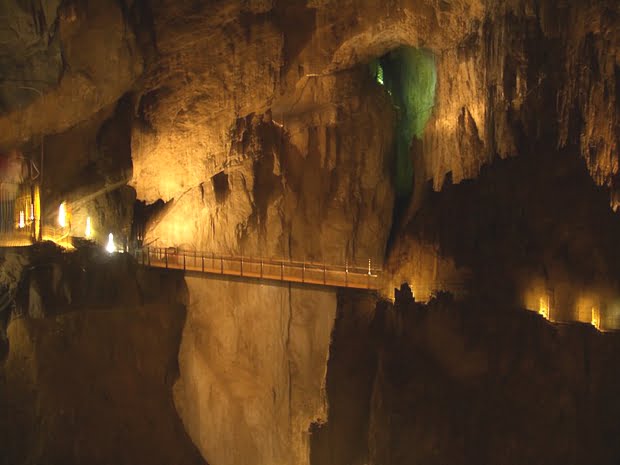
Skocjan caves
The Škocjan caves are an extraordinary series of limestone caves in Slovenia, featuring approximately six kilometres of beautiful underground passages, deep chasms, waterfalls, underground lakes, and caves. Situated in the northeast section of Kraski Landscape Park, this enthralling subterranean world is an area of great natural beauty. Impressively, the caves contain Europe’s largest underground gorge…

Matterhorn Mountain
Matterhorn Elevation & Location Matterhorn mountain is situated in the Pennine Alps on the border between Switzerland and Italy. It is one of the most famous and distinctive of all Alpine peaks. The Matterhorn is a pyramidal-shaped colossus, standing at a skyline-dominating elevation of 4478 metres (14,690 feet tall) which makes it the sixth highest…

Cliffs of Moher
Ireland is a wonderful country with a history steeped in legend and folklore and the rugged coastline of County Clare has more than its share of intriguing tales. Visitors to the magnificent Cliffs of Moher cannot fail to be impressed by such natural grandeur but may also wonder about the origins of some of the…
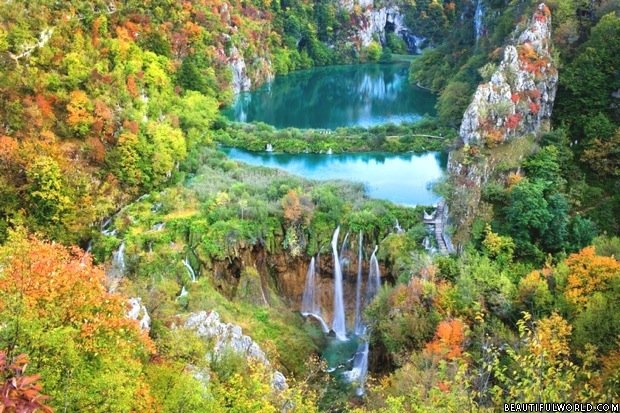
Plitvice Lakes National Park
With cascading waterfalls hidden among lush forest greenery, it’s easy to see why Croatia’s very own Garden of Eden regularly features in lists of the world’s most beautiful places. At the heart of the Plitvice Lakes National Park, 16 azure pools spill into each other, connected with rocky outcrops dripping in moss. The tallest waterfall,…

Aurora Borealis
The Aurora Borealis, or as it’s commonly known, the Northern Lights, is an ethereal phenomenon of extraordinary beauty. The celestial display of coloured lights across the night sky is both beguiling and inspiring in equal measure. Once seen, it is never forgotten. Characteristically, auroras emit a greenish-yellowish light, but blues and reddish-violet hues can also…

Verdon Gorge
The Verdon Gorge is one of Europe’s most beautiful river canyons. Situated in Provence Southeastern France, its name is derived from the striking turquoise color of the Verdon River that flows along its picturesque 25 kilometre (15.5 mile) length. Reaching a depth of 700 meters (2296ft) at numerous points, the Verdon Gorge (‘Gorges du Verdon‘…
What is the causeway like viewed from a boat?
Leave a Reply Cancel reply
Your email address will not be published. Required fields are marked *
What a prickle…
We're sorry – it looks like something's gone wrong
Explore Northern Irelands Only World Heritage Site
The giants causeway guide.

Giant’s Causeway Tour with Guided Cliff Walk
From £57 Per Person
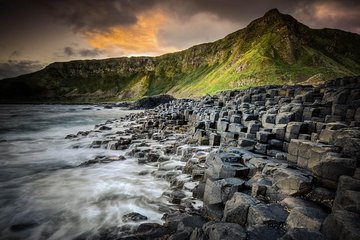
Giant’s Causeway, Belfast Titanic Experience, And Dark Hedges Tour
From £162 Per Person
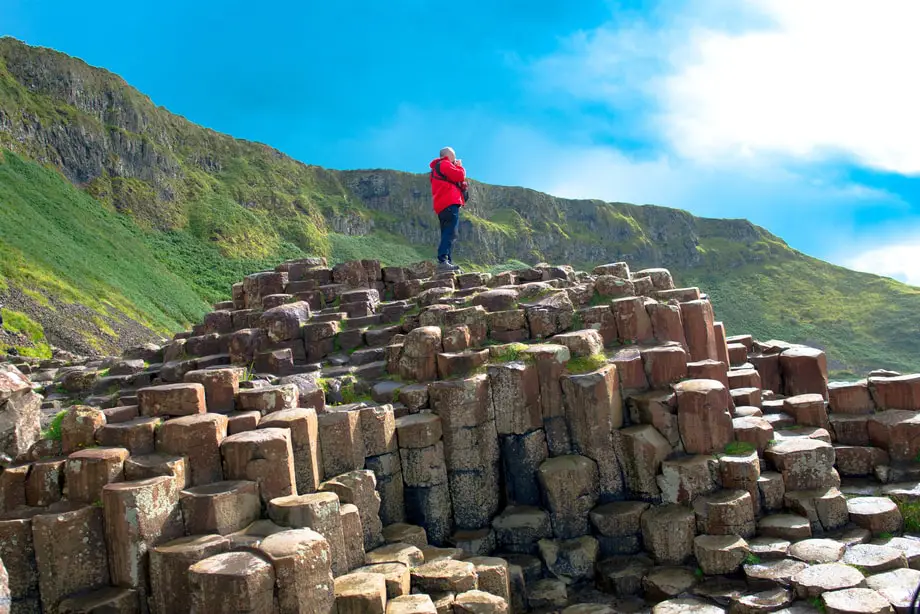
Tour of Giants Causeway and Bushmills Distillery
From £480 Per Group
“You are standing on, or are about to visit, one of my favorite places. The jewel in the crown of the fabulous coast of Antrim. A site of World Heritage and therefore ranked alongside Mount Everest and the Giant Redwoods of California for its importance to humankind. Volcanic activity helped Finn Mc Cool forge this wonder of the World some 60 Million years ago. It is today the habitat of rare plants and animals. Please treat their home with the pride and the care it deserves.” — David Bellamy

Explore the Giant’s Causeway , a UNESCO world Heritage site on the north coast of Northern Ireland, with about 40,000 interlocking hexagonal basalt columns stretching down to the sea. Legends intertwine with science here: some say these formations are the handiwork of underwater volcanic activity, while others recount tales of the giant Finn McCool, whose exploits shaped the north Antrim Coast during a battle with a Scottish Giant.
At the Giants Causeway Official Guide, we’re thrilled to offer entertaining and informative guided tours for individuals, families, and groups. We’re passionate about introducing this magnificent natural spectacle to visitors worldwide.
Embark on an unforgettable journey with a day-long guided tour starting from Portrush, Belfast, or Dublin. As Northern Ireland’s sole UNESCO World Heritage site, the Giant’s Causeway , an award-winning visitor centre, and four walking trails await your exploration. Leave the guidebooks behind and let our knowledgeable guides immerse you in the visitor centre’s exhibition-rich tapestry of history, myth, and beauty this area offers at your own pace.
Experience the renowned Giant’s Causeway Coastal Route in absolute comfort. Be captivated by Northern Ireland’s stunning County Antrim Coast aka the Causeway Coastal Route, the charm of Ireland’s landscapes, awe-inspiring views, and, unmistakably, the Giant’s Causeway, our only UNESCO world heritage site. With us, navigating becomes effortless—we’ll guide you to the best vistas and give you ample time to wander the mesmerizing coastal path from the Giant’s Causeway Visitor Centre car park to the Giant’s Causeway organ pipes and chimney stacks.
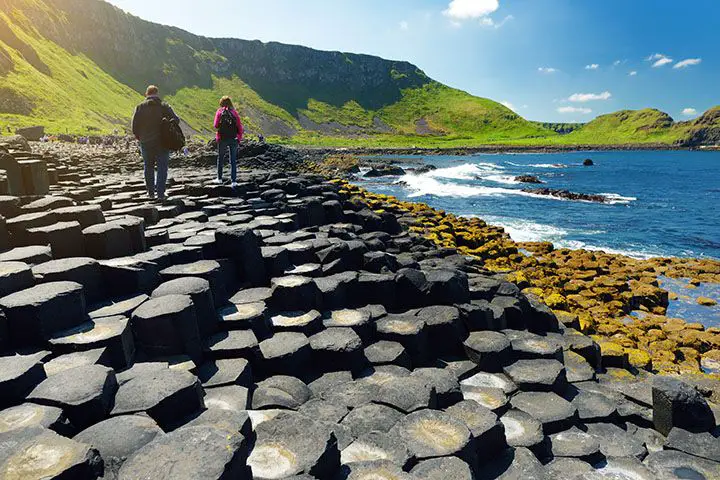
The Giant’s Causeway
Welcome, everyone, to the Causeway Coast Route, one of the world’s most stunning coastal landscapes in County Antrim. It’s a celebrated driving route and home to the Giant’s Causeway, considered one of the most magnificent natural wonders globally.
The Giant’s Causeway is located at the northernmost tip of the Causeway Coastal Route. The giant’s causeway is made up of around 40,000 hexagonal volcanic basalt columns that are neatly arranged in a promontory. The columns were formed some 6 million years ago from basaltic lava flow. The resulting formation is a testament to Earth’s ancient geological processes and looks almost too perfect to be natural.
The Giant’s Causeway is surrounded by a fascinating intersection of myth and science. It’s unclear whether the rapid cooling of lava from an underwater volcano or the work of the legendary Irish Giant Finn MacCool formed the basalt columns. The stories and scientific explanations blend here, adding a layer of mystery and enchantment to our visit.
Visitors worldwide have marvelled at the Giant’s Causeway’s unique rock formations for centuries. This natural wonder has stood for nearly sixty million years as a natural fortress against the fierce North Atlantic storms. The columns’ rugged symmetry never ceases to intrigue and inspire those who walk among them. To wander the Giant’s Causeway is to step back, immersing oneself in the Earth’s ancient history and the tales of giants that once roamed this land.
So, as we prepare to explore this magnificent site together, let your imagination roam free. Remember that the stories and stepping stones off of the Giant’s Causeway have captivated hearts and minds for generations. Today, you join that storied tradition. Welcome to our journey of discovery and wonder!
The Visitor Center
In 2012, a new architecturally designed bespoke Visitor Centre was opened at the Giant’s Causeway, replacing the original building constructed in 1986. The original building was erected when UNESCO added the Giant’s Causeway to its exceptional interest and universal site value list.
The new centre serves as the gateway to the famous Giant’s Causeway, which is semi-hidden in the hillside. It provides visitors with various ways to learn about myths, legends, social history, wildlife, and conservation. The centre is equipped with large screens for shows, an interpretation area, a shop selling souvenirs and local crafts, and a cafe that offers books, pamphlets, tourist information, and multi-lingual audio guides.
The Causeway Visitor Centre is managed by the National Trust, and it is free to enter for National Trust Members.
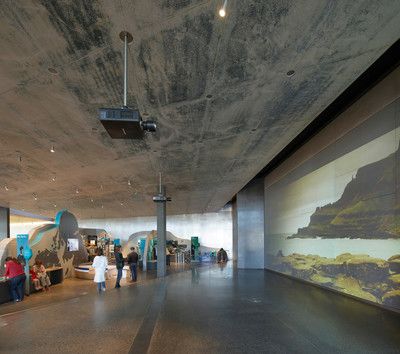
Similar Structures Around The World
The Giant’s Causeway is not as unique as one might think. Similar sites worldwide feature impressive hexagonal columns like those on the North Antrim Coast. The closest site is located on a Scottish island called Staffa Flow, where Fingal’s Cave is also lined with large basalt hexagonal stone columns. Similar structures can also be found in Israel, Iceland, Mexico, and Russia. However, it is worth mentioning that none of these sites are as fantastic as The Giant’s Causeway.
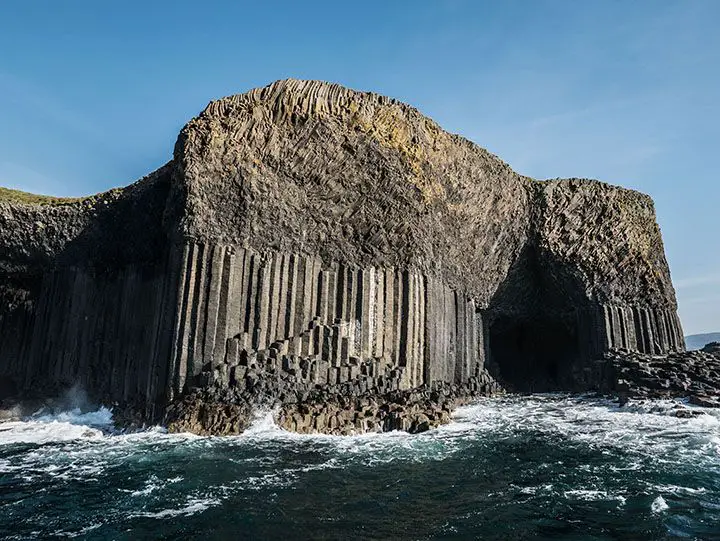
History Of The Giant’s Causeway
Although the Giant’s Causeway was formed over 60 million years ago, the roughly 4000 basalt columns only gained public awareness around 1690 when the Bishop of Down and Conor, William King, “discovered” them. You can learn more about the history of the Giant’s Causeway and how it became a world heritage site here.
Geology Of The Giant’s Causeway
“ When the world was molded and fashioned out of formless chaos, this must have been the bit over—a remnant of chaos !” William Thackeray Tweet Thackeray’s
The Giant’s Causeway, located in Northern Ireland, offers visitors some of the most amazing geological experiences on the Causeway Coast. Along with the famous stones, visitors can also witness many natural phenomena such as the Giant’s Boot, the Wishing Chair, and the Giant’s Organ. The coastal route and walk to the stones take in the breathtaking scenery of many of these attractions, and visitors can also snap a selfie on the Giant’s Boot. This popular tourist spot is definitely worth a visit.
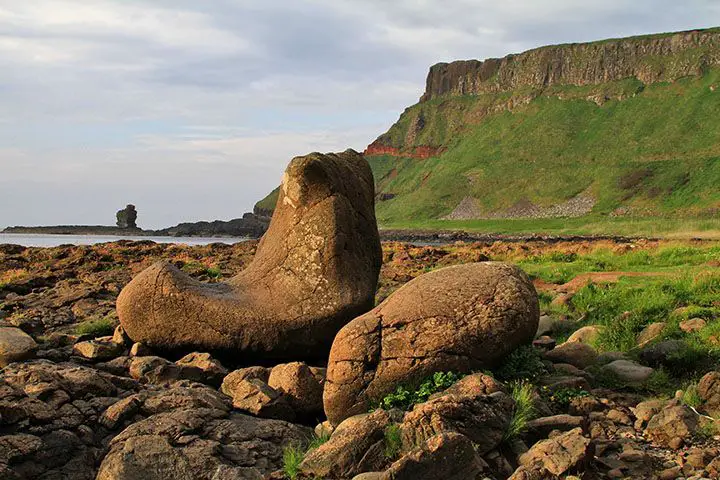
MYTHS & LEGENDS OF THE CAUSEWAY
The Giant’s Causeway near Bushmills is one of the UK and Ireland’s most popular tourist destinations, and it is known for its rare geological formations and enigmatic nature. According to local legend, the columns of the causeway are the remnants of a path built by the giant Finn McCool. The story goes that Finn MacCool, an Irish giant from Gaelic mythology, was challenged by the Scottish giant Benandonner. Fionn accepted the challenge and built the causeway across the North Channel to meet the two giants. Visitors can learn about this legendary battle between Finn McCool and Benandonner at the Giant’s Causeway Visitor Centre, operated by the National Trust.
Flora & Fauna
The Giant’s Causeway is not only known for its stunning rock formations, but it is also a sanctuary for various species of seabirds such as fulmar, petrel, cormorant, shag, redshank guillemot, and razorbill. Additionally, the weathered rock formations are home to several uncommon and exotic plant species, including sea spleenwort, hare’s foot trefoil, vernal squill, sea fescue, and frog orchid.

A Gallery Of The Causeway
The Giant’s Causeway is one of the most photographed places in Northern Ireland, if not the world. It offers stunning views of sunrises, sunsets, and even the solar system. You can check out some fantastic pictures of this grand causeway on our Instagram and other platforms.
Affiliate Disclaimer
Remember that we may receive commissions when you click our links and make purchases. However, this does not impact our reviews and comparisons. We try our best to keep things fair and balanced in order to help you make the best choice for you.
© Content Kings Media Ltd
Thanks for visiting nordicvisitor.com! For the very best browsing experience on our website, we urge you to upgrade to the most recent version of your browser . Some of our site features may not function properly on older versions.
Ireland travel update | New tours of the UK!
- Search Suggested Results View All Results
- EUR (€)
- GBP (£)
- Self Drive i
- Guided Small Groups i
- Privately Guided i
- Castles & Royalty i
- Countryside & Nature i
- Culture & History i
- Ireland & Scotland i
- All Types & Themes
- All Ireland Tours
- Best Sellers i
- Special Offers
- Book With Confidence i
- Ireland is open i
- Why book with us i
- Travel Update
- Booking Terms i
- Sustainability Policy i
- Ireland at a Glance i
- Useful Information i
- Ireland Attractions i
- Ireland Blog i
- Scandinavia
- Switzerland
- United Kingdom
- Manage Booking
- Privacy policy
Iceland Bíldshöfði 20 110 Reykjavík +354 578 20 80 View Map
Sweden Scotland View Details
- Giant’s Causeway
- Travel Guide
- Attractions
- Northern Ireland
FOLLOW IN THE FOOTSTEPS OF GIANTS
The Giant’s Causeway is the crème de la crème of natural landscapes in Ireland, so make sure to visit this world-famous attraction.
Made up of over 40,000 basalt columns, the causeway is an impressive sight to behold, especially as it juts into the Atlantic Ocean.
The Giant’s Causeway has been a UNESCO World Heritage Site since 1986. It is no wonder as you admire its dramatic cliffs, stunning views, and otherworldly columns. For centuries this landscape has captured the imagination of artists.
You can walk along the stones free, but access to the car park and visitor centre are paid. Guided tours and audio guides are available.
Make sure to try to find the specially shaped Giant’s Boot and Wishing Chair.
Those who enjoy walking and spectacular views may want to sign up for the Clifftop Experience. It is a fully guided 5-mile hike along the rugged coastline.
Giant's Causeway
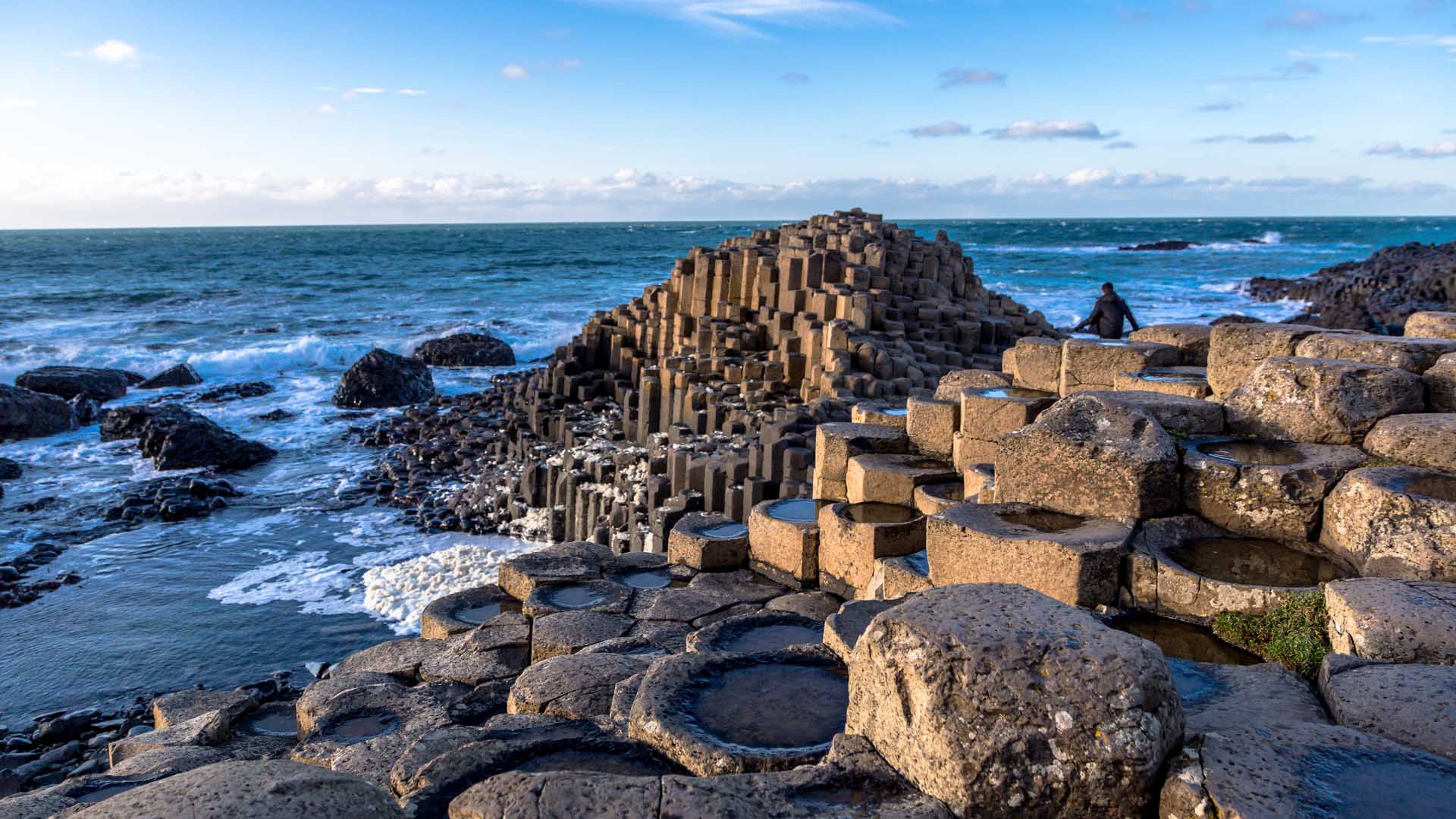
Giants Causeway ©Tourism NorthernIreland
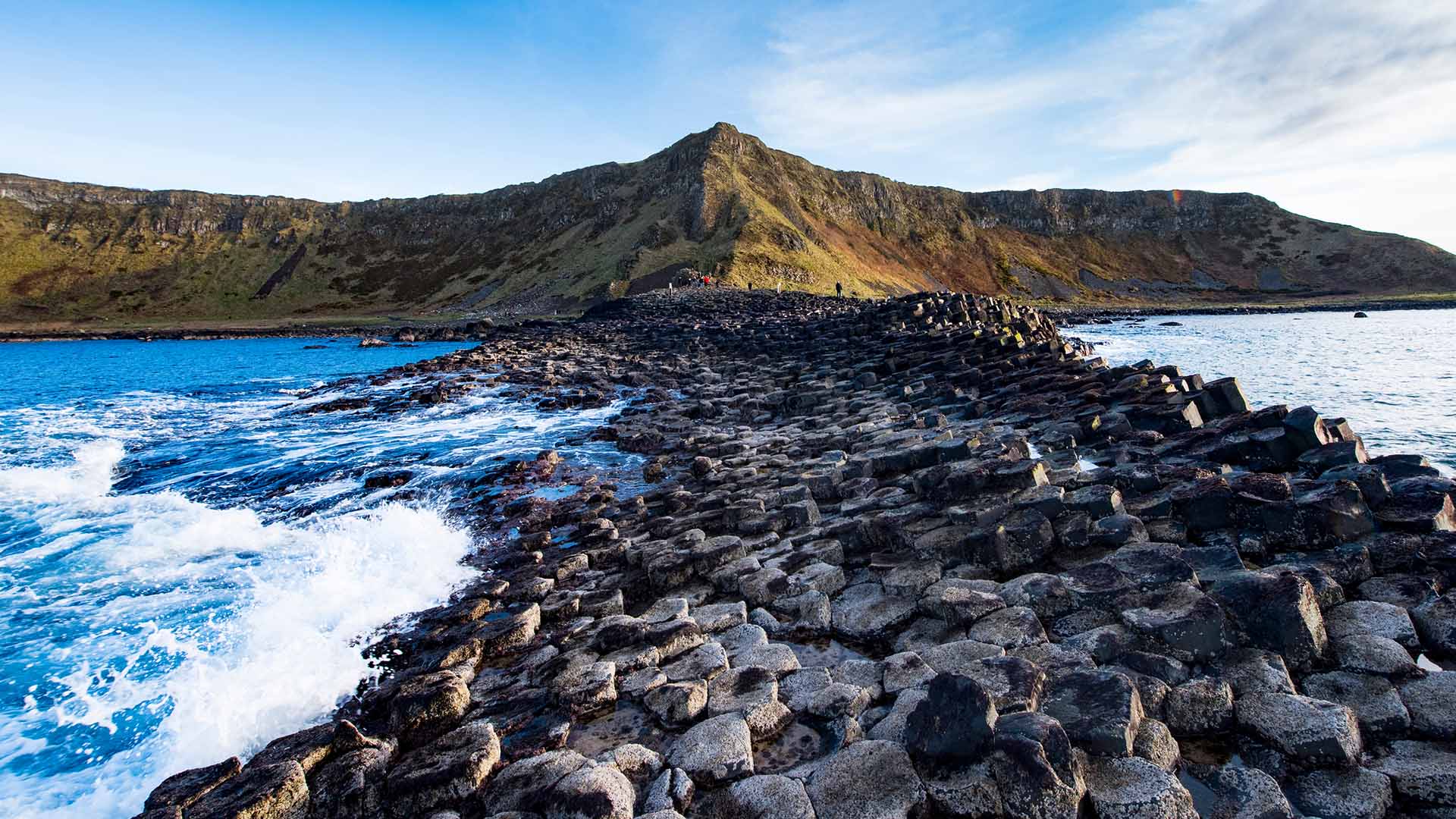
View attractions close by Giant’s Causeway
Dunluce castle, bushmills distillery, carrick-a-rede rope bridge, tours including giant’s causeway.
You could experience Giant’s Causeway through any one of these tours below.
Complete Ireland
Grand tour of ireland, ultimate tour of scotland & ireland, scottish highlands, north coast 500 & wild atlantic way, northern ireland road trip.
Whether you have a single question or a special request, we're here for you.


- Small Group Tours
- Self-Drive Tour
- Tailor-Made Tours
- Private Tours
- Overland TV
- Travel Guides
- Jewel Tours
- Self-Drive Tours
- Trust in Travel
- Accommodation
- Overland Transport
Everything You Need To Know About the Giant’s Causeway in Northern Ireland
The UNESCO World Heritage Site Giant’s Causeway is one of the top tourist attractions in Northern Ireland. It’s also one of the most unusual, yet most spectacular, natural features found anywhere in the United Kingdom. And as guests on our small-group tours of Ireland will confirm, it never fails to impress!
The Giant’s Causeway consists of thousands of basalt columns formed millennia ago by violent volcanic eruptions that changed the landscape forever. Legends abound at the Giant’s Causeway, and the natural spectacle is steeped in local lore as well as geological history, making it a fascinating place to explore.
It’s a must-visit destination and one of the most instantly recognizable sights in Northern Ireland. To help you plan your journey here, we’ve put together this detailed guide explaining everything you need to know about the Giant’s Causeway. If you have any questions for us as you read, please just get in touch .
What is the Giant’s Causeway?
The Giant’s Causeway is a surreal natural wonder. Basalt columns stretch along the coast, covering an area of several miles in Northern Ireland. These columns number around 40,000 and each is uniquely shaped and sized. The largest can reach heights of 12 meters and most are hexagonal, although each individual column is different.
The coastline surrounding the Giant’s Causeway is rugged and dramatic. The whole area is one of fascinating natural beauty, with excellent hiking routes, historic castles, and breathtaking views to enjoy. If this sounds like the kind of place you’d love to explore, we think you’ll appreciate taking a deeper dive with our Guide to Ireland’s Northern Coast .
The History of the Giant’s Causeway
The Giant’s Causeway is a truly ancient structure. The basalt columns were formed over 50 million years ago, and have been shaped and weathered ever since. Volcanic basalt seeped through the surface of the earth after a huge eruption. The molten rock then cooled slowly and, in a long geological process, the huge plain of basalt began to crack as the temperature lowered. This is how the basalt columns you can see today were shaped and formed.
Although the Giant’s Causeway has been steeped in local legend and known by the people in the surrounding areas for centuries, it wasn’t until 1692 that the ‘discovery’ of this natural wonder made it famous across the world.
The Royal Society began to produce drawings and papers on the Giant’s Causeway, and an unbelieving world initially refused to believe that something so perfect could be produced by the forces of nature alone.
It quickly became a popular tourist site, particularly amongst the European elite who were beginning to travel across the continent and were drawn in by such destinations. At first, it was unclear what had formed the Giant’s Causeway, and scientists and visitors threw around several stories. Many who saw the basalt columns couldn’t quite understand how nature could have created them; they even argued that it must have been workers using chisels that sculpted the rocks in an elaborate practical joke.
In the 18 th century, geologists began to understand more about volcanic activity. This knowledge was applied to Giant’s Causeway, which people finally understood had been created millions of years ago, not by men, but by geological forces.
Ever since its ‘discovery’, the Giant’s Causeway has been a popular travel spot, and in recent decades visitor numbers have reached millions of people. Modern developments have included being listed as a UNESCO World Heritage Site , which occurred in 1986. The National Trust now manages the area in an effort to promote conservation and control the effects of mass tourism to this wild and beautiful part of Northern Ireland.
Read our Guide To Ireland’s UNESCO World Heritage Sites to find out which other locations on the island of Ireland have the same level of cultural and historical value.
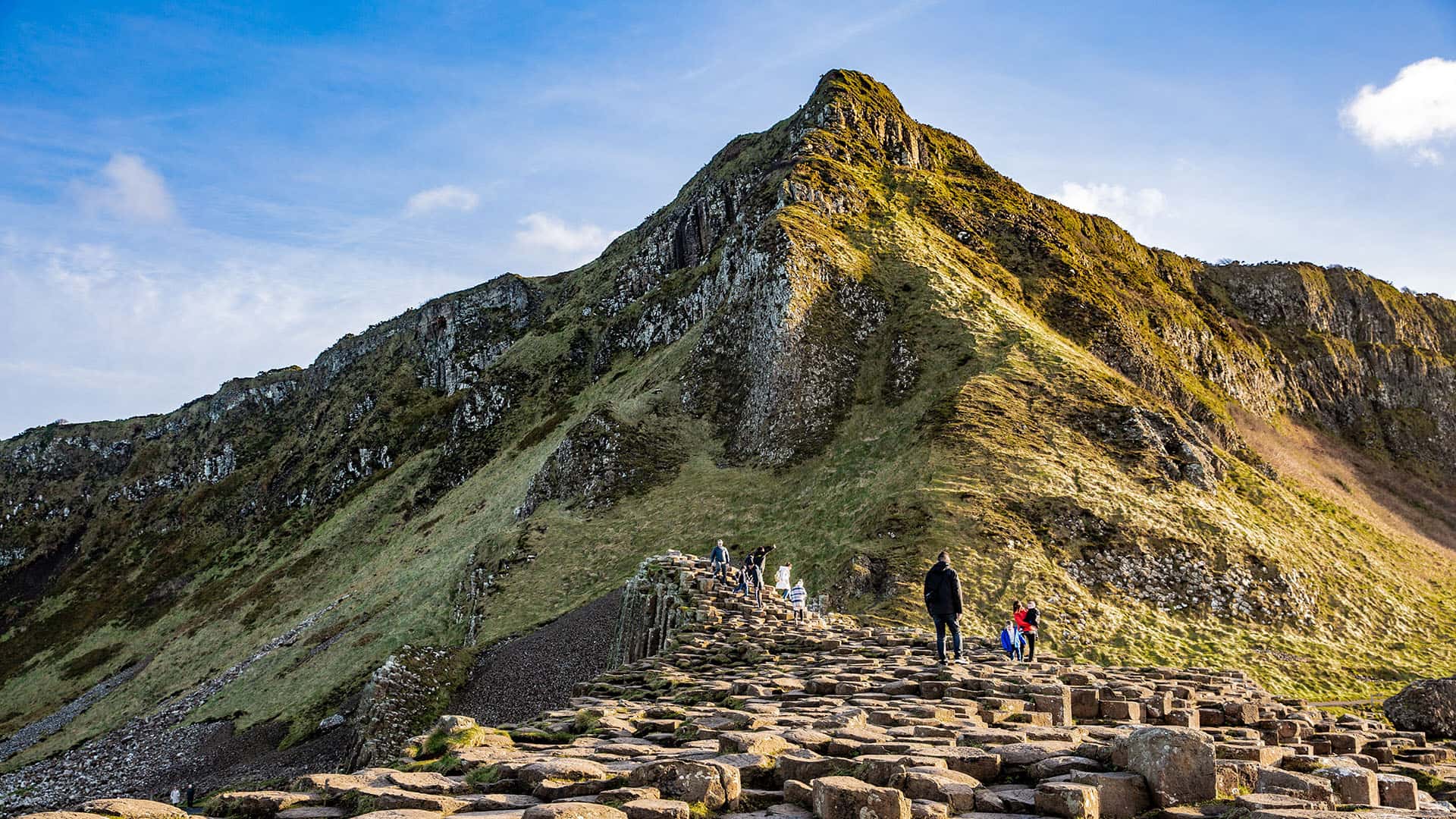
Popular Myths Surrounding the Giant’s Causeway
Local legends attribute the rock formations to be the work of giants, a story that’s given the natural site its enduring name: Giant’s Causeway. It’s said that the legendary giant Finn McCool was protecting the coast of Northern Ireland from another giant in Scotland, just across the stormy seas.
The Scottish giant, Benandonner, wanted to pick a fight with Finn McCool and began to enrage his Irish counterpart. Finn McCool then used his strength to pick up huge pieces of the coastline, before hurling them into the ocean to build a causeway that would stretch across the sea, so he could battle with his nemesis.
The legends have proven popular in local history, and many different versions and retellings of the story have been passed down through the generations, but every tale revolves around giants building the rock formation.
This combination of myth, legend, geological marvels, and breathtaking natural beauty all add up to make Giant’s Causeway one of the top five places to visit in Ireland !
Where is the Giant’s Causeway, Northern Ireland?
The Giant’s Causeway is located on the far northern coast of Northern Ireland, a part of the wider United Kingdom. The site is within County Antrim, along what’s known as the Causeway Coast. The nearest town is a few kilometers away at Bushmills, while Belfast and Derry are around 90 kilometers and 70 kilometers away, respectively.
The Visitor Centre, located just a short walk from the coast, is the most popular access point to the Giant’s Causeway.

How to Get to the Giant’s Causeway?
The Giant’s Causeway is one of the most popular tourist destinations in the United Kingdom, so it has great transport links and infrastructure. There are several different ways to visit, ranging from public transport to private tours. If you are short on time and want to maximize your activities in Northern Ireland, then the most efficient method of travel is a group tour. These leave Belfast daily for the northern coast, and many combine a trip to the Giant’s Causeway with stops at other locations along the way. Of course, some of our own tours of Ireland visit the causeway too, including the 10-day Ultimate Ireland Tour and the 6-day Wild West and North Ireland Tour .
Belfast is often the main base for travelers in Northern Ireland, as there are great flight connections from the rest of the UK and to Europe. From Belfast, it’s just a one-and-a-half hour drive to the Giant’s Causeway, so you can rent a car and enjoy a road trip along the coast to see the rest of the area’s spectacular scenery at your own leisure.
If you are driving, you can either park at the Visitor Centre or drive to Bushmills and take the convenient park and ride for the last stretch to the entrance. The Bushmills option can be much less chaotic and much easier, given the huge number of cars and coaches trying to access the main entrance.
If you want to spend longer exploring the area, then you can stay in Bushmills and enjoy the local region rather than just passing through.
If you wish to take public transport from Belfast, it’s fairly simple to reach the Giant’s Causeway independently. It will take longer than your other options, although it will certainly be more cost-effective.
There is a direct bus, which takes approximately two hours, departing once a day at 9.30 am from the Europa Bus Centre in Belfast. The return journey departs at 2 pm. Fares are cheap, however the service only runs during peak season, usually from May through September. Unfortunately, the fact that it only runs there and back once a day also limits the time you can spend at the Giant’s Causeway, as well as limiting any flexibility you might want.
Another more flexible method of public transport available all year is to travel from Belfast to Coleraine, and then to change here to another service to the Giant’s Causeway. There are several services throughout the day and it’s very cost-effective, as you can buy a day ticket for the route.
When using public transport, double-check when the last return bus is if you need to get back to Belfast on the same day, as timings can change.
Most people will arrive at the Visitor Centre, regardless of their mode of transport, and from here it’s just a short walk down to the coast to see the Giant’s Causeway.
If you’re already writing down notes and planning an adventure in this part of the Emerald Isle, we think you’ll appreciate reading our Complete Guide to Visiting Northern Ireland when you have finished here.

When is the Best Time to Visit Giant’s Causeway?
The Giant’s Causeway can get incredibly busy, as it is one of the most visited attractions in the United Kingdom. Peak season is when the crowds will be at their worst; you’ll find most people choose to travel here in summer, generally between May and September. This is when the weather is at its best, so it’s when people flock here to enjoy the best outdoor activities in Northern Ireland .
If you visit during peak season, consider renting a car to drive here early in the morning or staying overnight nearby so you can arrive nice and early. The earlier you arrive at the Giant’s Causeway, the smaller the crowds will be.
If you don’t mind the cold weather and windswept coastline, it’s perfectly fine to travel here in winter too, and you’ll avoid most of the crowds. Be prepared with raincoats and warm clothing, as the weather can be particularly bracing.
The Giant’s Causeway is technically open all day as it’s public land, however, the Visitor Centre is open from 9 am until 6 pm in summer and from 9 am until 5 pm in winter. There is an entrance fee to visit the information center, where you can learn more about the human and geological history of the coastline, but the causeway itself is free.
Things to See and Do Near Giant’s Causeway
The Giant’s Causeway is one of the biggest reasons why Northern is worth visiting ! Of course, it’s the main sight to see when you visit the north coast of County Antrim, and you’ll need at least an hour to truly appreciate the scale and volcanic beauty of the rock formations.
However, there’s more to do here if you have the time, and you can start by calling in at the excellent Visitor Centre, which is run by the National Trust and has a wealth of information.
Step Back in Time at Dunluce Castle
One of the best places to visit close to the Giant’s Causeway is Dunluce Castle. This ancient fortification dates back to the medieval era, but centuries of neglect and conflict have left it in ruins today.
The crumbling walls and towers are found in a dramatic location atop a rocky outcrop of basalt that stretches into the ocean. Legends abound here too, just as they do at Giant’s Causeway. There are tales of haunted towers and kitchens being swept away into the sea during mighty storms.
Embrace Adventure at Carrick-a-Rede Rope Bridge
Also looked after by the National Trust, Carrick-a-Rede is another stretch of spectacular coastline in County Antrim that shouldn’t be missed.
You can find a rope bridge here, which stretches precariously across a wide chasm, connecting the mainland with a small island off the shore. Fishermen originally built the bridge, and you can walk over the swinging planks while the wind howls for a truly adventurous experience.
Sample the Good Stuff at Bushmills Distillery
In the town of Bushmills, there’s a great local distillery creating some of the best whiskey in Northern Ireland. They have been distilling whiskey since the 17 th century and you can tour the premises to learn more about their history and the production process.
The Best Walking Trails Around Giant’s Causeway
With such a rugged and spectacular coastline, one of the best things to do around the Giant’s Causeway is to lace up your hiking boots and start walking. There are some excellent trails along the coast of County Antrim and you’ll be spoilt for choice. Several trails lead to the Giant’s Causeway, and these can be a great option if you want to avoid the crowds and enjoy some unique views of the rock formations.
The Red Trail is a short hike of one hour that takes you along the coast one way from the Visitor Centre and to some of the best viewpoints over the Giant’s Causeway. The Blue Trail only takes half an hour and leads you directly to the main collection of rocks, with the option to then link up with the Red Trail.
If you are looking for a real adventure, then you can take on the Causeway Coast Trail, a long-distance hiking route that takes two or three days to complete and takes you along much of the northern coast of County Antrim.
Our blog What To Look For In A Hiking And Trekking Tour In Ireland is a great resource for anyone looking to hit the trails while in the Emerald Isle.
Find Out Which of Our Ireland Tours Visit Giant’s Causeway!
If you’d like to visit the Giant’s Causeway as part of a small-group Ireland tour , check out our great range of itineraries or contact Overland Ireland to find out more.
Planning on visiting Ireland soon? Get our free guides! We answer your Ireland Travel FAQs + offer local tips for visiting Dublin.
Recent Posts

- Destination Guides
- Dingle Peninsula
- Food and Drink
- Northern Ireland
- Overland Ireland
- Ring of Kerry
- Skellig Michael
- Traditions & Culture
- Travel Styles
- Travel Tips
- Wild Atlantic Way
Join Us on a Tour!

Magical Southern 5-Day Ireland Tour

Ireland to Island 7-Day Tour
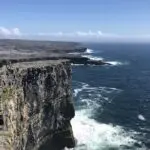
The Wild West & North Ireland 6-Day Tour

Emerald Explorer 7 Day Ireland Tour
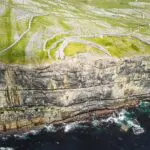
The Ultimate Ireland 10-day Tour Package
See our self-drive tours.
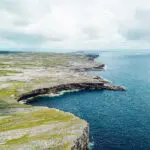
Wild Atlantic Wanderer 6-Day Self-Driving Tour of Ireland
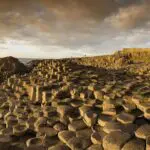
The Ultimate 10-Day Self-Drive Ireland Tour

The Northern Way 7-Day Self-Drive Tour of Ireland

The Ultimate Giant’s Causeway Day Trip from Belfast
Last Updated on March 5, 2024
by Maggie Turansky
Disclaimer: This article contains affiliate links. That means if you click a link and make a purchase, we may make a small commission. As an Amazon Associate we earn from qualifying purchases. For more information, see our privacy policy.

Planning a Giant’s Causeway day trip from Belfast is one of the most popular days out from the Northern Irish capital.
Located on the County Antrim coast in the north of Northern Ireland , the Giant’s Causeway is a UNESCO World Heritage Site and it is about as spectacular as you might think. In recent years, visiting these basalt rock formations has increased in popularity but that doesn’t take away from the beauty of this location.
So-called because, according to legend, the Irish giant Fionn mac Cumhaill (Finn McCool) suggest a causeway to be built to fight the Scottish giant Benandonner – this was to explain how there are virtually identical rock formations at Fingal’s Cave on the Scottish isle of Staffa. In reality, these were part of the same ancient lava flow during the Paleocene Epoch.
Steeped in folklore, the Giant’s Causeway is just one part of the incredible Causeway Coast in Northern Ireland and whether you choose to visit independently or as part of an organised tour, there is no doubt that visiting this iconic attraction is an unforgettable experience.
Table of Contents
Getting to the Giant’s Causeway from Belfast
There are a few options for visiting the Giant’s Causeway as a day trip from Belfast and which you choose really only depends on your travel style and preferences.
By Organised Tour
The easiest way to visit this iconic natural site from Belfast is via organised tour. There are a number of day tours to the Giant’s Causeway from Belfast to choose from and it’s a great way to take the hassle of planning out of it and enjoy your time in Northern Ireland.
While you won’t have the flexibility you could have if you go independently, you will be able to fit in quite a lot on most of these tours.
For example, this full-day tour is a great option for Game of Thrones fans who also want to visit the Giant’s Causeway. It will pick you up from Belfast, allow you to spend some time at the Causeway and also take you to some filming locations from the popular HBO series.
Another great option is this full-day tour which will take you to some beautiful coastal stops including Carrickfergus Castle, the Cushendun Caves and Carnlough Harbour while en route to the Causeway from Belfast city. It includes some time at the Giant’s Causeway and also will stop at the ruins of Dunluce Castle and the Dark Hedges before heading back to the city.
If you happen to be visiting Belfast as a stop on a cruise, then this shore excursion will pick you up from the cruise port and take you to the Giant’s Causeway and a few other highlights of the area.
And if you’d prefer not to go as a group but would still rather have a tour organised for you, then this private tour can be a great option as you will have an experience tour guide all to yourself.

By far the easiest and most flexible way to visit the Giant’s Causeway is by your vehicle. When having your own car, you can arrive at the Causeway as early as you’d like (it can get very busy later in the day), see which site you want to and skip which ones you don’t.
The drive from Belfast to the Giant’s Causeway itself is incredibly scenic and takes about 1-1.5 hours depending on the route. The Causeway Coastal Route, in general, is absolutely gorgeous and having enough time and flexibility to enjoy this area is far preferable.
Parking prices can vary, especially at the Giant’s Causeway itself. Generally, at the majority of the stops listed in the day trip itinerary below, you won’t need to pay much for parking fees throughout the day if you know what to do.
If you’d like to hire a car for your day trip, then consider browsing Rentalcars.com to compare prices across major rental companies.

By Public Transport
If you want to visit the Giant’s Causeway independently but don’t want to drive, then you can do it by public transport. There are direct buses operated by Northern Ireland’s Translink that connect Belfast and the Giant’s Causeway in about 1.5 hours.
From the Giant’s Causeway, you can also hop on local bus 402 to see some of the stops on the Causeway Coast, like the town of Bushmills (if you want to go to the whiskey distillery) and Dunluce Castle.
The 402 can take you all the way to the town of Portrush (a great place for a pint or dinner). From there, it is possible to grab a train back to Belfast in about 1.5 hours (though you may need to make a change depending on the route and time).
You can map out your journey and check timetables on the Translink website .

Giant’s Causeway Day Trip Itinerary
This itinerary really only works if you’re travelling independently by car, however, you can still experience the first 3 of these stops if you’re using public transportation.
One thing to keep in mind is that this is quite an active day and ensuring that you have proper shoes is essential. And, because the Irish weather can be erratic at best, having a good waterproof jacket is never a bad idea, either.
Giant’s Causeway
The first stop of your day trip should be at the Giant’s Causeway – it’s best to get here as early as possible to avoid the crowds and the tour buses that inevitably come a bit later.
It’s worth noting that, while it may not seem like it, entry into the Giant’s Causeway is actually completely free and you can visit this incredible natural site without having to pay a penny.
With this in mind, however, you cannot park at or visit the visitor’s centre – which is the closest car park to the Causeway itself.
If you choose to head to the visitor’s centre and park there, expect to pay at least £13.50 (£15.50 in peak season) per adult – so this can quickly add up depending on how many people you have in the car.

There are numerous other places you can park for a much-reduced fee or even for free.
If you’re up for a bit of an easy walk and want to visit the Causeway free of charge, then consider parking at the Salmon Rock Beach car park in the town of Portballintrae. Parking here is free of charge and there are also free public toilets here, as well.
From the car park, it is about a 30-minute walk to the visitor’s centre along the beach and the Bushmills railway path. It’s an incredibly pleasant walk and highly recommended. If you don’t feel like walking, you can also take local bus 402 to and from Portballintrae to the Giant’s Causeway.

Once you reach the visitor’s centre, we recommend heading on the Blue Trail to wind your way down to the iconic rocks of the Giant’s Causeway.
It’s worth noting, as well, that there is a shuttle bus that operates between the visitor’s centre and the rocks of the Causeway – it is £1 each way and can be used even if you didn’t pay to enter the visitor’s centre.
If you’re walking, continue along the Blue Trail after visiting the most iconic rock formations. The trail then winds its way up the cliffs and past the Organ Pipes formation and to the Amphitheatre viewpoint.

You can then follow the trail up the stairs until you join the Red Trail, which winds at the top of the cliffs and provides excellent views before you get to the visitor’s centre.
For those who walk all the way from Portballintrae to the Causeway and back, plan to spend about 2-3 hours in total there. If walking from the visitor’s centre, then plan to spend 1-2 hours here.
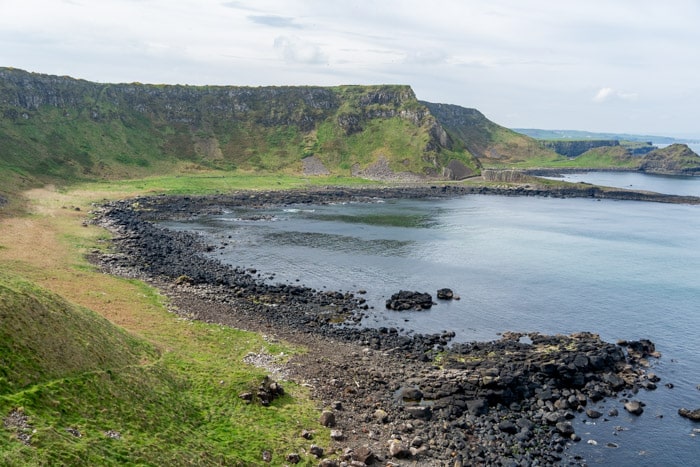
Dunluce Castle
After you’ve got your fill of natural splendour at the Giant’s Causeway, it’s time to visit our next stop on this day trip itinerary – Dunluce Castle. This is a beautiful ruined castle perfectly perches on the dramatic green cliffside of the Causeway Coast.
You’re able to tour the castle if this is something that interests you — tickets are £6 per person — or, if you’re simply interested in taking in the views of this gorgeous building, make sure to head to the Magheracross Viewing Point where you can get beautiful panoramic views of the castle and the surrounding coastline.

Looping back, take the time to explore the little town of Bushmills, which is located just south of the Causeway and is an excellent stop to include on your day trip to the Giant’s Causeway from Belfast. The town itself has a few pubs and shops to pop into, but the main draw is definitely the whiskey distillery.
Whiskey fans will love a visit and tour of the Old Bushmills Distillery – which claims to be the oldest licensed whiskey distillery in the world.
You can tour the distillery for £15 per person and the 1-hour tour includes an introduction to how the whiskey is made along with a tasting. If you’re interested, there are more premium tastings available, as well.
Causeway Coastal Route
If you didn’t drink too much whiskey in Bushmills (please remember to drink responsibly!) then take a bit more of your time to enjoy some of the other stops on the Causeway Coastal Route.
There is a surprising amount to see in this beautiful area that isn’t just the Giant’s Causeway itself and it’s very much worth taking the time to enjoy some of the incredible views.
For those who have the time or energy, another popular spot on the coastal route is Carrick-a-Rede which is an old rope bridge suspended over to a small island.
You have to pay to enter this area and it is popular as it was included as a filming location for Game of Thrones . From this area, you can also view Larrybane Quarry, which was also used as a filming location for the series
If you don’t want to walk across the bridge itself, you can also get a great view of it from the Portaneevy Car Park, which is also completely free of charge to visit.
Other stops on the Causeway Coast include Ballintoy Harbour, Dunseverick Castle and Falls and the beautiful White Park Bay beach.

Dark Hedges
Moving away from the coast, it’s time for the last stop on this Giant’s Causeway day trip itinerary – the Dark Hedges. While this is, in my opinion, a somewhat overrated stop – it is popular because it was used as yet another filming location for Game of Thrones .
The Dark Hedges is basically a small country road over which are some intertwining trees. It’s worth noting that, if you’re visiting in late autumn to mid-spring, you’re unlikely to see any leaves on these trees either which takes away from their charm. It’s also an incredibly popular spot and hard to get away from the tourist crowds.
Located about 20 minutes south of the Giant’s Causeway, there is a large car park where you’re meant to pay a £4 fee in the hotel. It’s then about a 5-minute walk before you can get to the trees and the laneway itself.
The actual road with the Dark Hedges is a few hundred metres long and it doesn’t take long to stroll along it. For those who are interested in seeing more Game of Thrones sites and want to imagine that they’re walking along the King’s Road, then it’s worth the stop.

Have More Time?
If you have more time than just a day trip to the Giant’s Causeway, there are lots of areas where you could enjoy yourself. Base yourself in the town of Portrush, which is a lovely seaside resort town with a beautiful beach and a little amusement park.
There are plenty of incredible walks and hikes to enjoy in this area, as well, and it is a great place to spend some time in the area if you’re a nature lover and want to explore some places at a slower pace.
For instance, if you didn’t have time to walk the Carrick-a-Rede rope bridge during your day trip, having another day will definitely allow you to have this experience.
Spending a bit more time on the Causeway Coast will also allow you to have the time to spend as much time hiking at the Giant’s Causeway as possible while still allowing you to hike around other places.

Where to Stay in Belfast
Harpers Boutique B&B – Located in the Queen’s Quarter of Belfast, this boutique bed and breakfast is a fantastic base for your day trip. It is within walking distance to many of the city’s main attractions and there are several comfortable rooms to choose from. They also offer a great breakfast which is included in the nightly rate.
The Warren Belfast – This centrally-located hotel is the perfect choice if you’re after a bit of luxury during your stay in the Northern Irish capital. It is also located in the heart of the Queen’s Quarter, and they offer plush rooms great amenities and a filling breakfast included in the price.
Central Belfast Apartments: Citygate – If you’d like your own self-catering accommodation while visiting Belfast, then these apartments are an excellent option. They have a range of fully-furnished flats to choose from and there is also free on-site parking – perfect for those visiting the Giant’s Causeway by car.
Vagabonds – The perfect choice for budget and solo travellers, this centrally-located hostel has both dorm beds and private rooms available, clean facilities and excellent common areas to meet other, like-minded travellers.
Not quite what you’re looking for? Click here to browse more Belfast hotels!
Visiting the Giant’s Causeway as a day trip from Belfast is an excellent way to enjoy the dramatic natural scenery that Northern Ireland has to offer within a short amount of time.
Are you planning to visit the Giant’s Causeway? Have any questions? Let us know in the comments!

Related Posts:

10-Day Ireland Itinerary: 3 Road Trip Routes

The Perfect 1, 2, or 3 Days in Belfast Itinerary

The Perfect 3, 4 or 5 Days in Northern Ireland Itinerary

About Maggie Turansky
Maggie is a co-founder and writer for The World Was Here First. Originally from the US, she has lived in five different countries and has travelled to dozens more, both solo and with her partner, Michael. She particularly loves exploring Spain and spending time in the Caucasus and the Baltics. Read more about Maggie
Leave a Comment Cancel reply
National Geographic content straight to your inbox—sign up for our popular newsletters here

- INTELLIGENT TRAVEL
My Favorite Place in Northern Ireland: Giant’s Causeway
One usually gets to the Giant’s Causeway by way of Bushmills. It doesn’t hurt that there’s a distillery in the village that makes that great Irish whiskey.
I’d driven north from Belfast on narrow roads that stitch the Irish hills together like an old quilt. Somewhere in County Antrim I encountered a snag: The lane was closed to facilitate a game of road bowling .
Men hurled steel balls down the hedge-lined path while bookies shouted their wagers and drowsy cows looked on, unimpressed by the scene. (Only in Ireland.)
I was behind schedule, and, with sundown looming, passed on an intended stop at the Old Bushmills Distillery . (I guess 1608 counts as old, even in Ireland.)
But you don’t need spirits to bring the Causeway to life. It does that just fine all by itself. As I would soon discover, this bit of primordial geology is loaded with spirits of another stripe.
Like most everyone else, I’d seen photographs of the hulking, interlocking columns that grace Northern Ireland’s wild Atlantic coast.

The pictures don’t prepare you, I can tell you that.
A sea of basalt blocks, black and hexagonal, a long step from one to the next, descending into the sea, like primal pistons thrusting out of the earth.
The thought that they might rise and fall beneath our feet, but very, very slowly, out of all reckoning by human time, made me giddy. I hopscotched across the stones, a feckless man-child cut free. I got too close to crashing waves that thundered in with the hollow thump of power, then drained away like a chorus of hushed whispers.
The sun was going down. I was listening for the Giant.
There are two incredible stories connected with Giant’s Causeway—one is factual, the other mythical.
I like the mythical one more. But here are the facts. The hulking pillars are the remnants of a vast volcanic outpouring some 60 million years ago. The molten basalt cooled just so, spawning the 40,000 or so blocks we see and clamber across today.
Now, insist on doltish facts if you must, but this is Ireland; if you’re not going to let your heart loose from that sheep pen where it’s been locked up while you’re here, you might as well stay at home.
Finn MacCool (Fionn MacCumhaill in Gaelic) built this causeway.
I could see his steps leading out into the North Channel, off toward Scotland. If I could have followed them into the sunset, I’d have reached Fingal’s Cave on uninhabited Staffa, an isle in Scotland’s Inner Hebrides, by morning.

Depending on who’s recounting the tale, MacCool strode across the ocean to see his enemy/lover—a giant like him—in order to battle/tryst with him/her, and found his way to Gaelic legendary fame.
- Nat Geo Expeditions
You can see that there is fair bit of wiggle room to the story and that, given a few centuries (and the Irish being Irish), the yarn could grow—and it has. Like the six-sided stones beneath my feet, fact and fiction fit together seamlessly, all snug and just right, like a well-told Irish tale.
There is one more fact that I found compelling. Where the stone pillars have horizontal joints, one side will be convex, where the other is concave.
You know by walking across them that they are not perfectly flat, but slightly cusped—each missing its particular partner, now gone missing. Seawater pools in them after the waves ebb. It’s just the physics of cooling lava at play, I know. But the night I first stepped foot onto the Giant’s Causeway, it was a bit eerie, too.
Jim Richardson is a contributing photographer at National Geographic Traveler magazine. Follow his story on Twitter and Instagram @JimRichardsonNG.
> Related:
- Circumnavigate the coast of Ireland on the National Geographic Orion
For Hungry Minds
Related topics.
- DISTILLERIES
You May Also Like

Everything you need to know about English whisky

Meet the mixologists shaking things up in the Big Apple

Why you should try Indian Ocean rum

Fun tastings, fancy tours: how Scottish whisky experiences are evolving

Liquid sunshine: everything you should know about Caribbean rum
- Environment
- Perpetual Planet
History & Culture
- History & Culture
- History Magazine
- Gory Details
- Mind, Body, Wonder
- Paid Content
- Terms of Use
- Privacy Policy
- Your US State Privacy Rights
- Children's Online Privacy Policy
- Interest-Based Ads
- About Nielsen Measurement
- Do Not Sell or Share My Personal Information
- Nat Geo Home
- Attend a Live Event
- Book a Trip
- Inspire Your Kids
- Shop Nat Geo
- Visit the D.C. Museum
- Learn About Our Impact
- Support Our Mission
- Advertise With Us
- Customer Service
- Renew Subscription
- Manage Your Subscription
- Work at Nat Geo
- Sign Up for Our Newsletters
- Contribute to Protect the Planet
Copyright © 1996-2015 National Geographic Society Copyright © 2015-2024 National Geographic Partners, LLC. All rights reserved

Award Winning Tour

Giant's Causeway Tour
Daily Tours to Giant's Causeway
2022 TripAdvisor Travellers Choice Award Winner!
Tour departs daily at 8.30am (returns at approx 6pm)
McComb's Travel offers visitors to Northern Ireland the longest established tour to what is commonly called "The eighth wonder of the world". Travel in one of our award winning coaches along the Causeway Coastal Route for a fun filled day!
Why choose us?
- Ours is THE most comprehensive tour from Belfast, with the most stops
- We have the most modern & comfortble coaches, meaning you enjoy the tour in both safety and comfort
- We're the original Giant's Causeway Tour Company - we created this tour almost 30 years ago!
- Our driver/guides are the most experienced there are - some in our driving seat for more than 20 years!
Enjoy the first stop of the day at Carrickfergus Castle , before travelling onward along the Causeway Coastal Route , stopping off at lovely places like Carnlough and the Caves at Cushendun . We'll move along what has been voted one of the "Top 5 Scenic Drives in the World", where you'll also see towns and villages like Glenarm, Ballygally, Balllycastle, the Glens of Antrim, Cushendall & much more.
We'll stop off at Portaneevy View Point to get some Instagram worthy photos of the iconic Carrick-a-rede Ropebridge - we hope you've a head for heights!
You'll be ready for a rest by now at our lunch venue - The Fullerton Arms in Ballintoy, where there's a tastly pub grub style lunch on offer (payable locally).
The highlight of the tour is definately a visit to Giant’s Causeway , Irelands only World Heritage Site. Spend some time climbing over the ancient stones, snapping some photos, and enjoying the myths and legends that surround this world famous attraction.
We then re-board our luxury coach, and make our way to along the coast, for a short stop at the breathtaking ancient ruins of Dunluce Castle .
For the Whiskey lovers onboard, we will visit Ireland's Oldest Licenced Whiskey Distillery - Old Bushmills ! There will be time to visit their gift shop, which offers Whiskey only available to buy at Bushmills, or have a tipple or two in the Whiskey Bar.
Our final stop of the day is at the iconic Dark Hedges . Made famous by it's appearance as The Kings Road in Game of Thrones, this picture perfect location ends the tour on a high!
All that then remains to be done is to sit back and relax on the comfortable journey back to Belfast (arrives back at around 6pm depending on the time of year) in one of our award winning luxury coaches.
This really is a must take tour, and with the combination of our luxury coaches, experienced and friendly tour guides, and wonderful attractions, you'd be mad to miss it!
IMPORTANT INFORMATION: There is some walking on what are sometimes uneven surfaces during this tour, and it therefore requires moderate fitness levels. Please come dressed appropriately for not only the season, but also for the activity. While it is always our intention to visit all of the locations listed, if there is an unforeseeing event which means it is not possible to stop at them we may have to adjust the itinerary accordingly. Your driver will always give priority to your safety, and access for the coach without causeing any loss or damage.
Please Also Note: Unfortunately we cannot currently pre-book entry tickets for the visitor centre at Giant's Causeway. You will be able to visit the Giant's Causeway stones Free of Charge (we think that's the best part anyway)!! The National Trust have also made the decision to no longer allow any coaches to visit Carrick-a-rede Ropebridge, therefore we will instead have a Photo Stop at the Portaneevy Viewing Point.
Belfast’s longest running Causeway Tour
Tours available all year
Award Winning Company
- Tour departs at 8.30am from 22 Donegall Road
- Carrickfergus Castle (photo stop)
- Causeway Coastal Route
- Carnlough Harbour
- Cushendun Caves
- Carrick-a-rede Ropebridge (photo stop)
- Pub Grub Lunch Stop
- Giant's Causeway
- Dunluce Castle (Photo stop)
- Bushmills Distillery
- The Dark Hedges
- Tour ends in Belfast City Centre at approx 6pm
or call 028 9031 5333
Excellent value for money and is a must for any new visitor to Belfast !!!
Sunny Day Diner, Leeds
Perfect in every way!
Linda, Florida
Definitely do this trip - it was the highlight of my travel through Dublin and Northern Ireland
LeeLee, Madrid
Like this tour? Then you may also be interested in...

Game of Thrones Tour
By travelling with McComb's you're travelling with the same company as the cast and crew of Game of Thrones!

Airport Transfers
Take the Hassle out of Holidays

Visiting The Giant’s Causeway: History, Parking, Tickets + Seeing It For Free
By Author Keith O'Hara
Posted on Last updated: January 30, 2024

I’ve a love/hate relationship with the Giant’s Causeway, mainly due to the ridiculous parking charges .
You can visit the Giant’s Causeway free if you’re walking/cycling , but if you’re driving and you want to park near by, you really do pay for the privilege …
Now, there are ways of visiting the Giant’s Causeway for free , and you’ll find them below, but if you drive up with 3 adults in the car you could end up forking out £45 …
Below, you’ll find info on the Giant’s Causeway tickets to the different walks in the area and the parking options.
Some quick need-to-knows about visiting the Giant’s Causeway
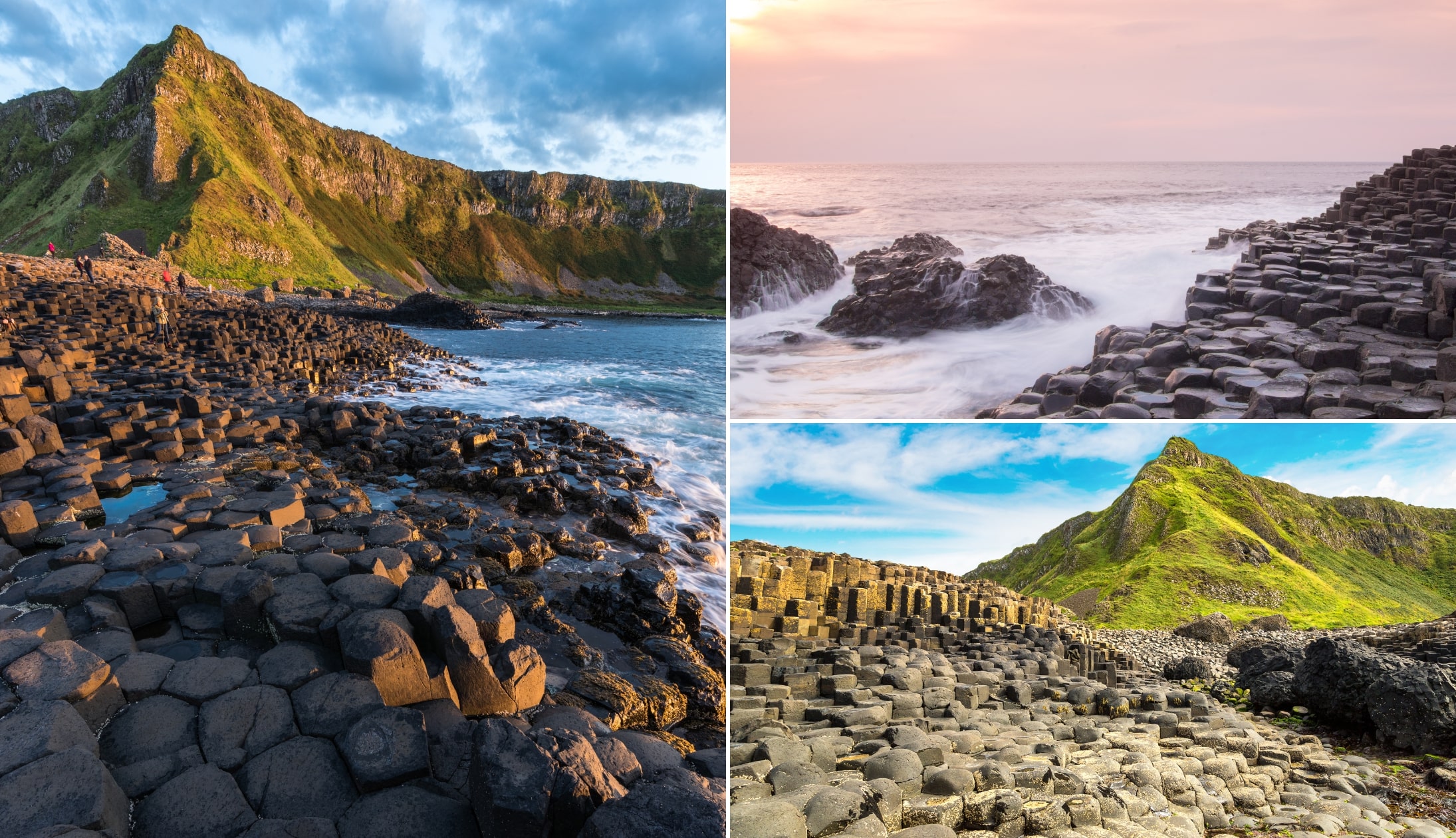
Photos via Shutterstock
Although a visit to the Giant’s Causeway is fairly straightforward, there are a few need-to-knows that’ll make your visit that bit more enjoyable.
1. Location
The Giant’s Causeway is situated on the Antrim Coastal Route , a 5-minute drive from the Old Bushmills Distillery , a 10-minute drive from Dunluce Castle and a 15-minute drive from Carrick-a-rede .
You’ll need to pay for the Giant’s Causeway tickets if you want to park at and visit the visitor centre. There are peak and off peak prices . I’ll put the peak prices in brackets:
- Adult : £13.50 (£15.00)
- Kids : £6.75 (£7.50)
- Family : £33.75 (£37.50)
The Giant’s Causeway parking is what you’re paying for with the ticket prices above. Although the visitor centre has an interactive exhibition, most people only head into it to use the toilets and restaurant. There are other Giant’s Causeway parking options, which we’ve plotted on the map below.
4. Opening hours
The opening hours change slightly , depending on time of the year, however, the visitor centre is generally open from around 09:00 to 17:00 while parking is open all day.
5. How to see it for free
You can visit the Giant’s Causeway for free if you walk from either Dunserverick Castle or Portballintrae . These are long and scenic coastal walks. If you/someone you’re travelling with has limited mobility, you are best off parking at the visitor centre. More info below.
6. The shuttle bus
If you don’t want to walk from the visitor centre to the Causeway, there’s a shuttle bus that runs at 15-minute intervals . It costs £1 per person.
7. Weather plays a big part
If you arrive at the Giant’s Causeway on a day when the rain is pummelling down, you’re in for a tough time . The Giant’s Causeway is completely exposed – even if you take the shuttle bus, you’ll be soaked when you reach the basalt columns, so ensure to 1, pack rain gear and 2, pack a change of clothes.
The main Giant’s Causeway parking options

Click to enlarge map
There are four main Giant’s Causeway parking options that are within a reasonable walking distance of the entrance point.
Each of these are paid parking – if you want to visit the Giant’s Causeway for free, scroll to the next section.
1. The ‘main’ car park
The main spot for parking at the Giant’s Causeway is the visitor centre car park ( here on maps).
They use a system similar to the Cliffs of Moher where they justify the ridiculous cost by pushing the fact that you also get access to the visitor centre.
The advantage of parking here is that it’s right next to the Giant’s Causeway, so it’ll be handy for visitors with limited mobility.
2. Causeway Coast Way Car Park
The second Giant’s Causeway Car Park, known as the ‘Causeway Coast Way Car Park’, is a 7-minute walk away and it’s also a rip-off ( here on maps).
You’ll pay £10 to park here and this doesn’t include access to the visitor centre. Now, they’ll justify this by saying ‘But sure you have all-day parking’, when realistically you’ll be here for 2 hours max.
3. Parking at The Nook
The Nook ( here on maps) is right next to the visitor centre and, if you buy food here, you can also use their car park.
This is a handy option, if you can get a spot, as at least you’ll get a feed on top of your parking!
4. Parking at the Causeway Hotel
The car park at the Causeway Hotel ( here on maps) charges you £10 upon entry, but with that you’re given a £10 voucher to spend in the hotel restaurant.
Decent value when you compare it to the 2nd car park above where you’ll only get access to the toilets for your £10er.
How to visit the Giant’s Causeway for free

The only way to visit the Giant’s Causeway for free if you have a car is to park at either Portballintrae or Dunseverick and then walk from there.
Of course, if you have a bike and can cycle there from where you’re staying, that’d give you access to the Giant’s Causeway for free, too! Here’s an overview of both options:
1. Walk from Portballintrae (1.5 – 2 hour loop)
Park your car for free at Salmon Rock Beach and take the 1.5 to 2-hour coastal loop from Portballintrae.
This is a gorgeous coastal walk that treats you to stunning views throughout. Good walking shoes are needed as the trail can get muddy in places.
2. Walk from Dunseverick Castle (1.5 hours each way)
If you fancy a decent ramble, you can always park at Dunseverick Castle and take the 4.8 mile (one way) trail to the Causeway. The scenery is incredible and the trail, for the most part, is well maintained.
The walk from the castle to the Causeway takes roughly 1.5 hours each way. If you don’t fancy walking back to the car, you can get the Translink Service 172 from near The Nook just down from the visitor centre back to Dunseverick.
About the Giant’s Causeway in Northern Ireland
Right, now that we have info on the Giant’s Causeway parking out of the way, it’s time to dive into some Giant’s Causeway facts.
1. It’s a UNESCO world heritage site
The Giant’s Causeway is a UNESCO world heritage site and it is considered by many to be among Europe’s greatest natural wonders.
It made the list thanks to the ‘Outstanding Universal Value’ that it offers visitors .
2. It’s old. Really old
It’s believed that the Giant’s Causeway is between a whopping 50 and 60 million years old (more info on how it formed below) and geologists have been studying the Causeway for nearly 300 years.
3. It’s made up of 40,000+ basalt columns
One of the most popular Giant’s Causeway facts is the number of huge, black basalt columns that it comprises of – there are 40,000 of them jutting proudly out of the sea.
4. There’s a ‘giant’ tale linked to the Causeway
According to Irish folklore, the Giant’s Causeway was formed after an Irish giant was challenged to a fight by a fierce Scottish Giant (more info below).
The story goes that the Causeway is in fact stepping stones that the Irish giant used to get to Scotland.
How was the Giant’s Causeway Formed? The facts and the folklore!

Now, you tend to hear two different stories about how the Giant’s Causeway in Ireland formed. The first story is the sciencey one. It involves volcanic activity and that kind of thing.
The second is a tale that many people that grew up in Ireland were told at bedtime. I’m talking, of course, about the legend of Fionn MacCumhaill and his fight with a Scottish giant.
Story 1: Volcanos and eruptions
Roughly 60 million years ago, the area around what is now known as the Giant’s Causeway was a hotbed of volcanic activity.
This era is referred to as the Paleocene Epoch, a time when the earth looked very different from how we see it today When molten basalt leaked through chalk beds to make a large lava plateau, the lava cooled and then contracted.
Horizontal contraction fractured and the cracks propagated down as things cooled, hence the pillarlike structures we see today.
In most situations, the horizontal fracture brought about a convex bottom end whilst the upper was concave. The size of the columns was determined by how quickly the lava cooled.
Story 2: The legend of Fionn MacCumhaill
Although story 1 is the official, scientific explanation of how the Causeway formed, there remain those who err on the side of ancient legend to explain how the Giant’s Causeway was formed.
According to Irish mythology , the causeway was formed when a giant named Fionn Mac Cumhaill built it to get to Scotland for a duel with another giant.
Whilst certainly more entertaining than the official version of events, this explanation is today mostly reserved for children! Read the full story in our guide to the legend of the Giant’s Causeway .
The best Giant’s Causeway tours
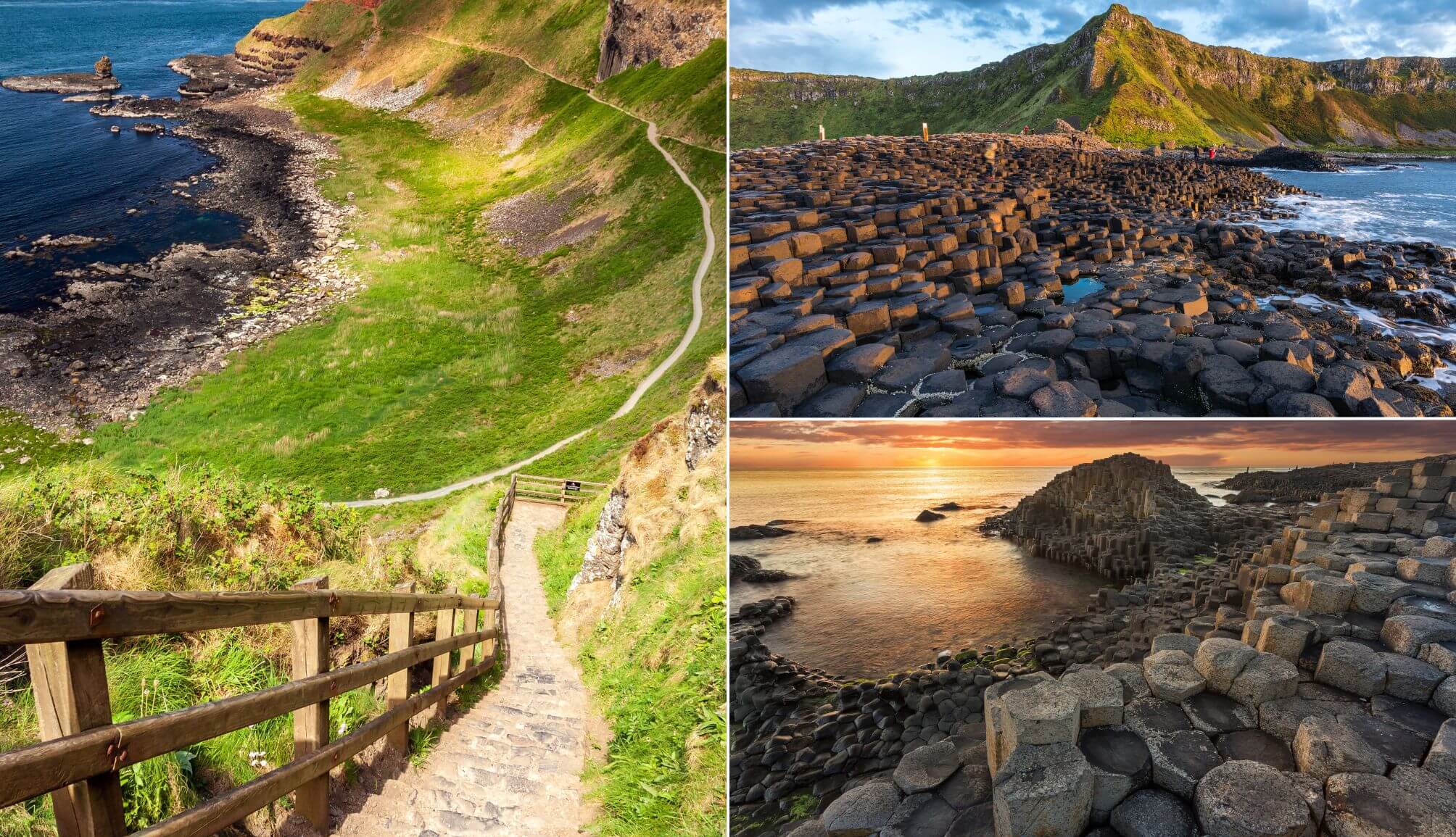
We receive a constant stream of emails and direct messages from tourists asking for advice on the best Giant’s Causeway tour, so we’ve rounded up several with great reviews.
Note: if you book a tour through one of the links below we may make a tiny commission that helps us keep this site going. You won’t pay extra, but we really do appreciate it.
Giant’s Causeway Tours from Dublin
When it comes to visiting the Giant’s Causeway from Dublin, it is key to remember that it’ll take just over three hours to get there by car/tour bus, so factor that into your planning. Here are two with excellent reviews:
- Giants Causeway, Dark Hedges, and Belfast Tour from Dublin
- Giant’s Causeway and Game of Thrones Tour from Dublin
Giant’s Causeway Tours from Belfast
If you’re looking to visit the Giant’s Causeway from Belfast, you’ve plenty of choice. Here are two tours with top-notch reviews:
- Giants Causeway & Game of Thrones Locations Tour from Belfast
- Giant’s Causeway Fully Guided Day Trip from Belfast
Things to do near the Giant’s Causeway
One of the beauties of the Giant’s Causeway is that it’s a short spin away from a clatter some of the best places to visit in Antrim .
Below, you’ll find a handful of things to see and do a stone’s throw from the Causeway (plus places to eat and where to grab a post-adventure pint!).
1. Old Bushmills Distillery (5-minute drive)

Photos courtesy of Tourism Northern Ireland
One of the most popular things to do near the Giant’s Causeway (especially when it’s raining!) is to do the Old Bushmills Distillery tour. It’s popular among whiskey lovers and non-whiskey drinkers alike. You can also visit The Dark Hedges when you’re done.
2. Castles galore (10 to 20-minute drive)
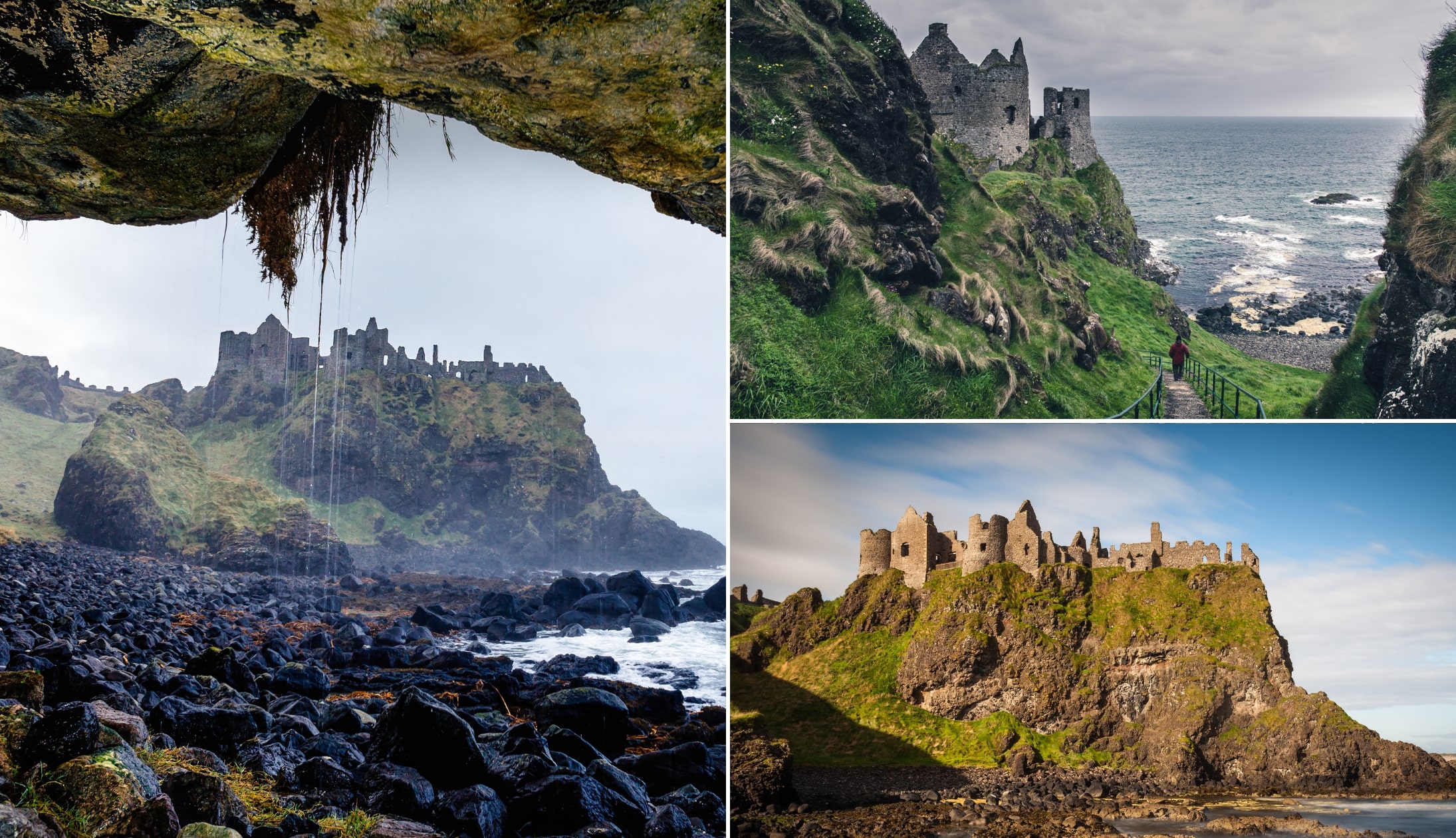
One of the more unique things to do near the Giant’s Causeway is to visit one of the many medieval ruins that can be found nearby. Dunluce Castle is a 10-minute drive away, Dunseverick Castle is a 5-minute drive and Kinbane Castle is a 20-minute drive.
3. Heaps more attractions (10 to 25-minute drive)

If you’re looking for more things to do near the Giant’s Causeway, you’ve plenty to choose from, with many of the most popular Causeway Coastal Route attractions a short spin away. Here are some of our favourites:
- Portrush Beach (20-minute drive)
- Torr Head Scenic Route (20-minute drive)
- Whitepark Bay (10-minute drive)
FAQs about Giant’s Causeway facts and tours
We’ve had a lot of questions over the years asking about everything from ‘How was the Giant’s Causeway formed? ‘To where to park for the Giant’s Causeway?’.
In the section below, we’ve popped in the most FAQs that we’ve received. If you have a question that we haven’t tackled, ask away in the comments section below.
Where is the best parking near the Giant’s Causeway?
If you don’t want to get stung with the hefty Giant’s Causeway parking charges at the visitor centre, park at the Causeway Coast Way Car Park (10 minute walk) for £10.
How can you visit the Giant’s Causeway for free?
If you want to visit the Giant’s Causeway for free, park at Dunseverick Castle or Salmon Rock Beach (info on the walks above).
What are the best things to do near the Giant’s Causeway?
There are plenty of things to do near the Giant’s Causeway, from Dunluce Castle and the Bushmills Distillery to The Dark Hedges and more (see above).
Keith O’Hara has lived in Ireland for 35 years and has spent most of the last 10 creating what is now The Irish Road Trip guide. Over the years, the website has published thousands of meticulously researched Ireland travel guides, welcoming 30 million+ visitors along the way. In 2022, the Irish Road Trip team published the world’s largest collection of Irish Road Trip itineraries . Keith lives in Dublin with his dog Toby and finds writing in the 3rd person minus craic altogether.
This site uses Akismet to reduce spam. Learn how your comment data is processed .
Joan Mulvey
Thursday 14th of July 2022
Are you able to take dogs on the causeway?
Saturday 7th of January 2023
The Causeway Coast Way Car Park is now £10
Monday 3rd of October 2022
@Keith O'Hara, Thanks for this Keith. Very helpful.
Keith O'Hara
Saturday 16th of July 2022
Hi Joan - according to this article it's fully dog friendly: https://www.nationaltrust.org.uk/giants-causeway/news/we-are-now-fully-dog-friendly
Wednesday 27th of April 2022
Great guide however due to the long summer evenings, just arrive after 6pm when the visitor center is closed, there are no crowds and park at the centre for free, you can even watch the sunset from the Causeway. This is what I did 👍
Live Adventure Travel contains affiliate links and is a member of the Amazon Services LLC Associates Program. If you make a purchase using one of these Amazon links, I may receive compensation at no extra cost to you. See my Disclosure Policy for more information.
The Giants Causeway Walk: Parking, Routes & Local Tips
The Giants Causeway Walk is one of the most popular things to do on the island of Ireland. The Causeway is located in County Antrim, in the North and it is one of the most visited attractions on the island. A visit to the Causeway is a truly unique experience, a must on any Ireland vacation. The Causeway is a UNESCO World Heritage site and is made up of interlocking basalt columns, a result of an ancient volcanic eruption. However, how the Causeway truly came to be is the subject of Irish myths and legends.
There are a total of 3 walking routes along the Causeway Coast, however, before we dive into which route is best for you let’s discuss opening times, parking and how to get there.
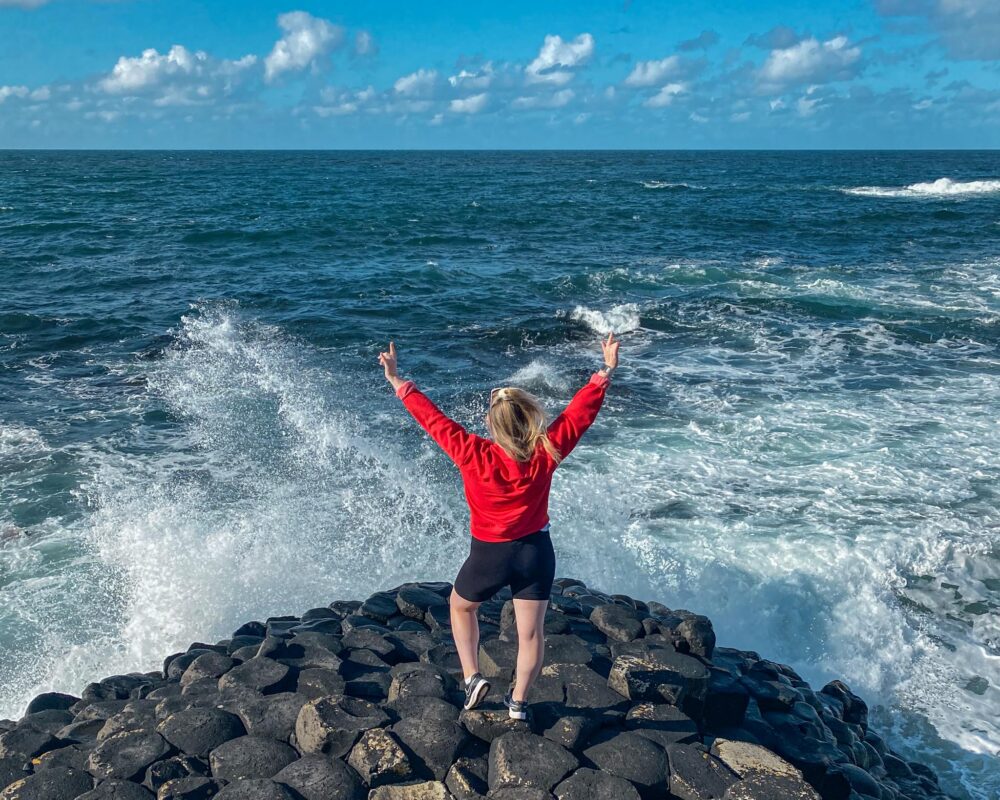
The Giants Causeway Opening Times
The Causeway itself is technically always open, it’s possible to visit the basalt columns at any time. However, if you wish to take part in the visitor experience it is best to check opening times before you arrive.
At the time of writing, the summer and Autumn months (May-October) the visitor centre is open from 10.00am to 5.00pm.
And in the winter months, the visitor experience is open from 10am to 4.00pm.
The Causeway closes for Christmas (24th,25th & 26th of December).
The Giants Causeway Visitor Experience
If you wish to take part in the Giants Causeway visitor experience it will cost £13.00 for Adults and £6.50 for children.
Tickets include on-site parking, access to the visitor centre, toilets and the option to take part in a guided tour or go on a self-guided tour with an audio guide.
The visitor centre also has a coffee and souvenir shop onsite.
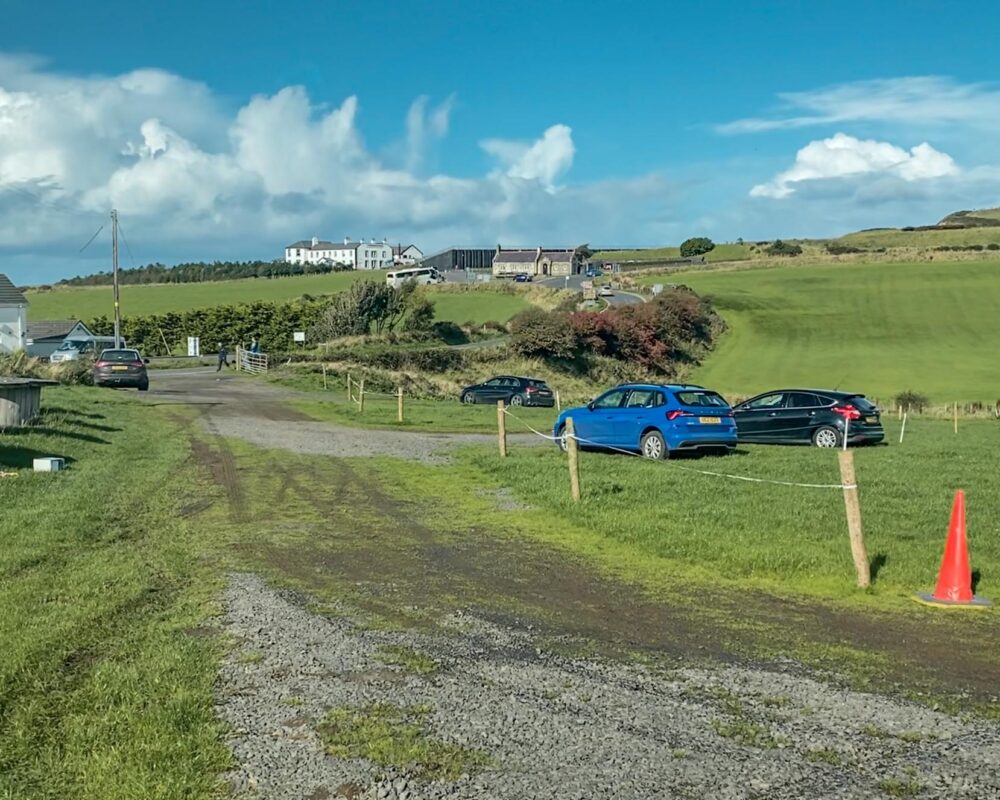
Giants Causeway Parking for FREE
While taking part in the visitor experience for first-timers in Ireland can be enjoyable, it is rather expensive. If you would prefer to visit the Causeway on your own accord without any of the included facilities, I’d advise parking in the car parks outside the property. These parking sites are no more than a 5-minute walk from the causeway entrance and are generally a lot cheaper.
I usually park in the car park facing Finn McCool’s Giants Causeway Hostel , it’s cost £5 per car and is only a short walk away from the main car park.
How to get to the Giants Causeway:
By Car: It is rather easy to reach the Giants Causeway by car, with a range of parking facilities nearby. The Causeway is located just 1 and 30 minutes drive from Belfast and a 3 hour and 20-minute drive from Dublin .
Day Trip from Belfast: If you don’t have access to a car one of the most popular ways to visit the Causeway is by taking a day trip from Belfast . You can book your ticket here.
Day Trip from Dublin: The Giants Causeway is also a perfect addition for those who have an extra day to add to their Dublin Itinerary as it is a popular day trip from Dublin . You can book your ticket here.
It is also common for those visiting the causeway to stay in the nearby town of Bushmills, here you can get there by bus, car or taxi .
These tours generally include stops at other famous attractions along the Causeway Coast including the Carrick a Rede Rope Bridge , Dunluce Castle and Game of Thrones filming sites, The Dark Hedges and the town of Ballintoy .
The Giants Causeway Walks
There are a total of 4 walking trails at the Giants Causeway, the blue, red, green and yellow trails. I had a browse on the National Trust Website for a greater understanding of each trail and while it gives a good indication of the start and endpoints of each walk. I would like to add my own route which combines the routes together to make sure you get the most out of your Giants Causeway Experience. Let’s call this the Causeway Loop. It will be route 5 on the list 😉
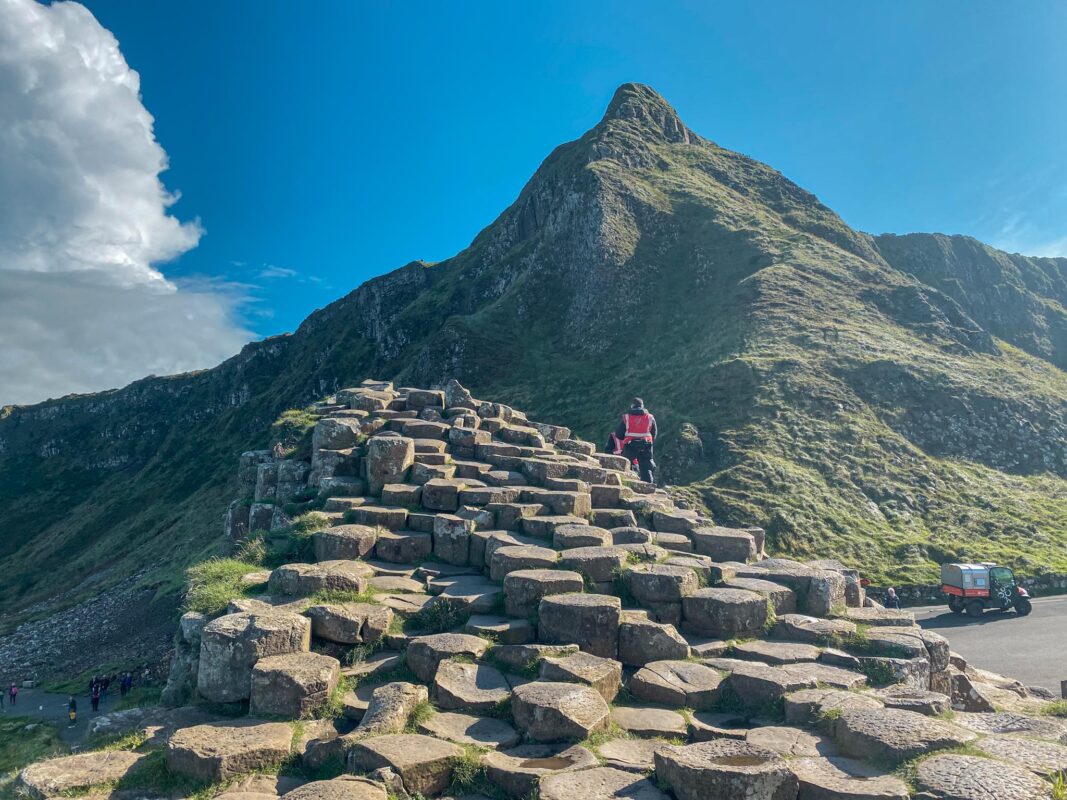
1. The Blue Route – Straight to the Causeway
The Blue Route is the shortest of all 4 walks in the Giants Causeway. It begins at the visitors centre and continues along a wide road for about 15 minutes before reaching the main part of the Causeway. Most visitors are unaware, that when visiting the causeway you must take the blue route to the main area as the visitor centre is not located at the main site. For those taking part in the Visitors Experience, there is a free shuttle bus included in the ticket price, this will allow you to visit the Causeway without having to walk at all. Please be mindful that walking back towards the visitors centre via the Blue Route can be steep in places, I, therefore, suggest the shuttle bus for those with reduced mobility.
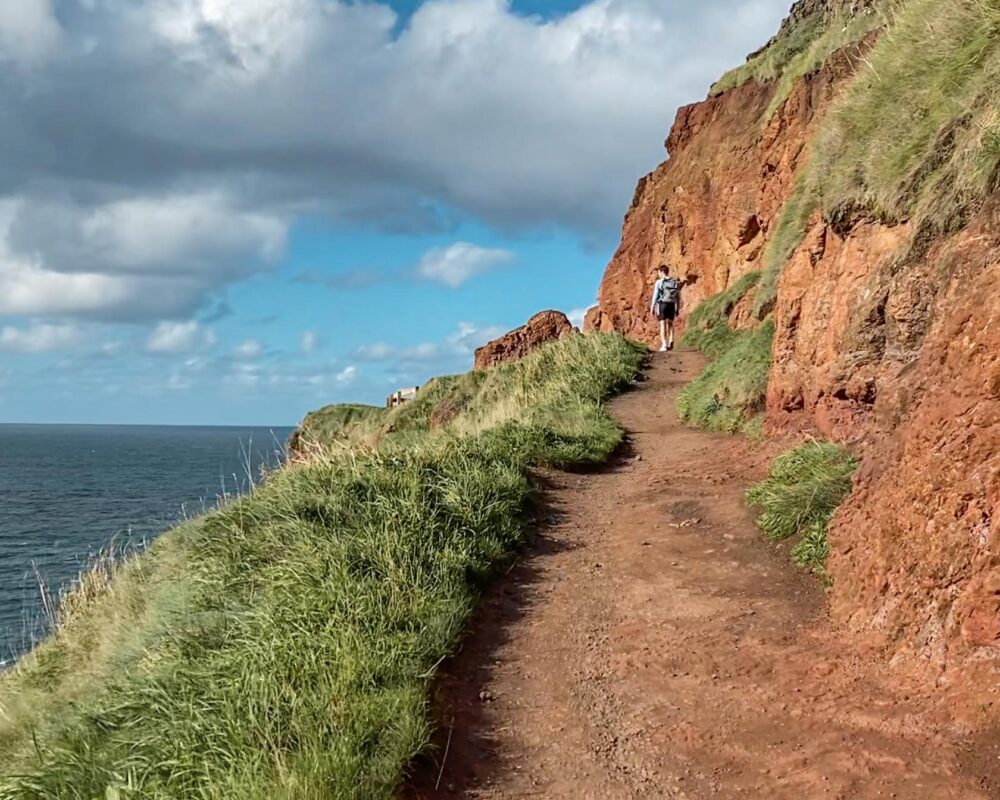
2. The Red Route
The red route brings visitors along the one of the most beautiful cliffs in Ireland and offers a 360 view of the Causeway and the coastline. This route begins at the Causeway Hotel and continues for 3.2km before reaching Shepherd’s Steps.
In order to stay on the Red Trail, you need to walk down the steps until you reach the lower floor of the Causeway. From there, take a right and walk towards the Organ and the marvellous red rocks (My favourite area of the Causeway). From the red rocks, you will be able to see the Causeway off in the distance.
I’d highly recommend checking out the red route as it is not too strenuous and allows walkers to see the Causeway from a different perspective.
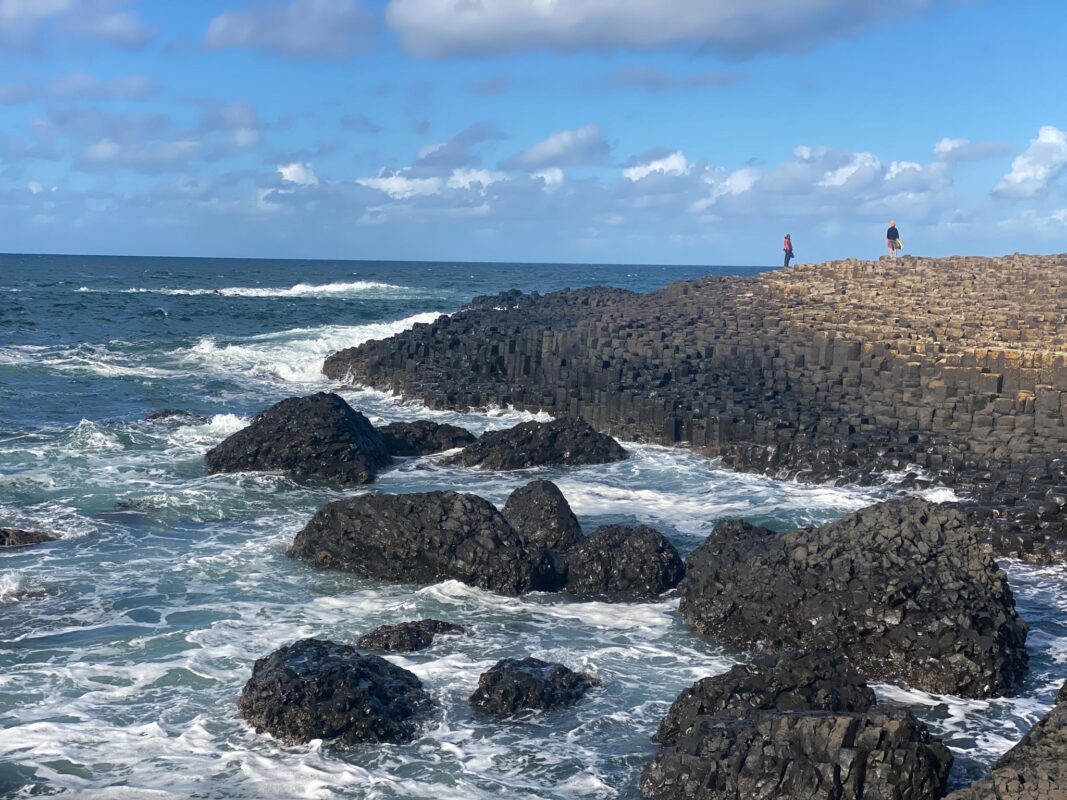
3. The Green Route
The Green Route is for those of all abilities, making the Causeway accessible for those with mobility concerns. As well as those looking to bring strollers.
Ireland is known for the iconic Cliffs of Moher , however, the Green Route is also home to some beautiful cliffs with outstanding views of the Causeway, on a clear day it is also possible to see as far as Scotland. The walk itself takes about 1 hour and 30 minutes to complete and is 3.2km long. However, getting to the main viewing point takes around 30 minutes.

4. The Yellow Route
The Yellow Route is for those who want to get a little further off the beaten path and enjoy the Giants Causeway Hike. Much like the Red Route, the yellow route brings walkers along the cliff edge for a spectacular 360 view of the Causeway and the coastline.
However, instead of descending down the Shepard Steps like the Red Trail, the Yellow trail continues to follow the Cliff Edge until you reach Hamilton’s Seat.
This trail will take 30/40 minutes to complete, it is only suitable for those with a moderate to a high level of fitness as it can be steep and dangerous in areas.
Check Out my Tip For Visting Ireland for the First Time Guide
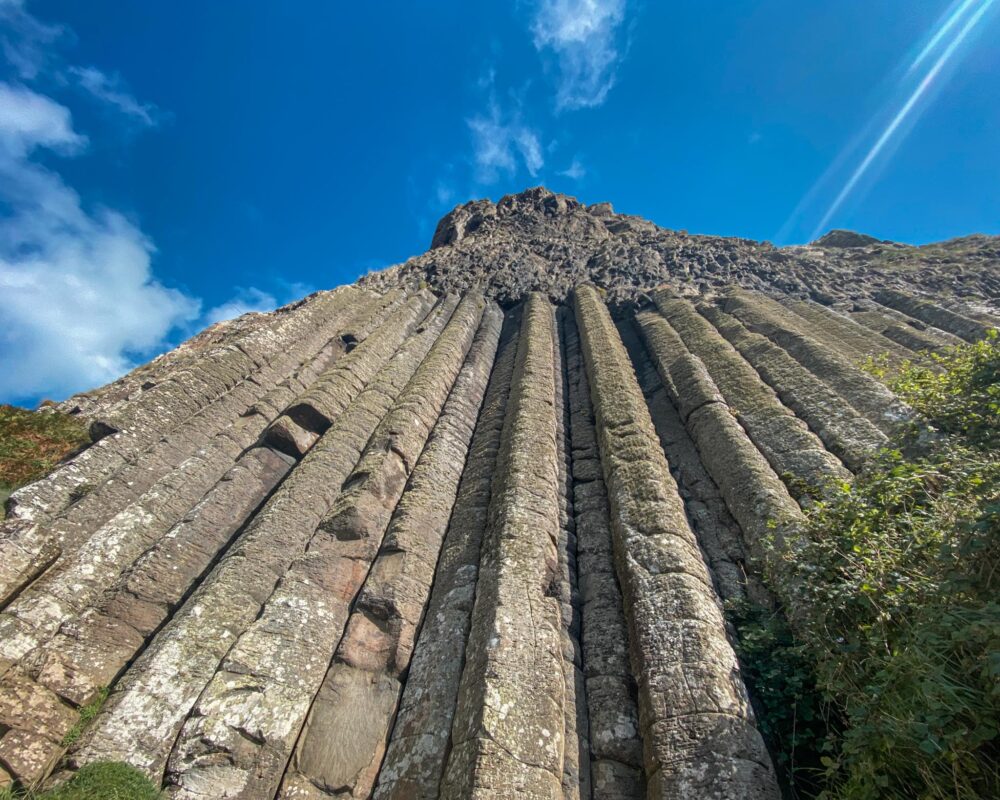
5. The Causeway Looped Walk
While the official Giants Causeway Coastal Trails all share an equal level of beauty, combining them is the best way to see all of which the Causeway has to offer.
I suggest you begin your trip to the Giants Causeway by walking down the main road leading from the visitor centre (aka the blue route). This will take 15 minutes and will bring you to the main area of the Causeway. Here, I suggest taking some time to take photos and enjoy the basalt columns up close and personal.
Once you are finished follow the path towards the Red Rocks seen in the distance (aka the end of the Red Trail). Before approaching the red rocks you will come across the organ. A line of basalt rocks that shoots up towards the sky.
Once you reach the red rocks, it’s time to retrace your steps. Continue along the path until you reach Shepards Steps, don’t worry if you missed them on the way, they are a lot easier to see on the way back.
The steps will bring you up onto the cliff edge, from here you will have a birdseye view of the Causeway. Continue along the red trail until you reach the visitors centre.
Tips for visiting the Giants Causeway
- Check the Weather : The Giant’s Causeway is an outdoor attraction, and its enjoyment can be greatly influenced by the weather. Checking the forecast in advance will help you prepare better, especially if you follow a good packing guide . Now don’t get me wrong, the likely hood of getting snow while you are there is slim but the chances of rain is much greater so dress accordingly.
- Wear Comfortable Shoes : The site involves a great deal of walking over uneven surfaces, so sturdy, comfortable footwear is highly recommended.
- Visit During Off-Peak Times : To avoid the crowds, try visiting early in the morning or late in the evening. Moreover, the site looks beautifully tranquil during these times.
- Bring Snacks and Water : There are limited options for food and drink at the site. It’s advisable to bring your own, especially if you plan to spend several hours there.
Causeway Coast Road Trip Youtube Video
On my 3-day road trip down the Causeway Coast, we decided to walk the Causeway Looped walk. Feel free to give the video a watch for a better idea of the walk and other places to visit along the Causeway Coast.
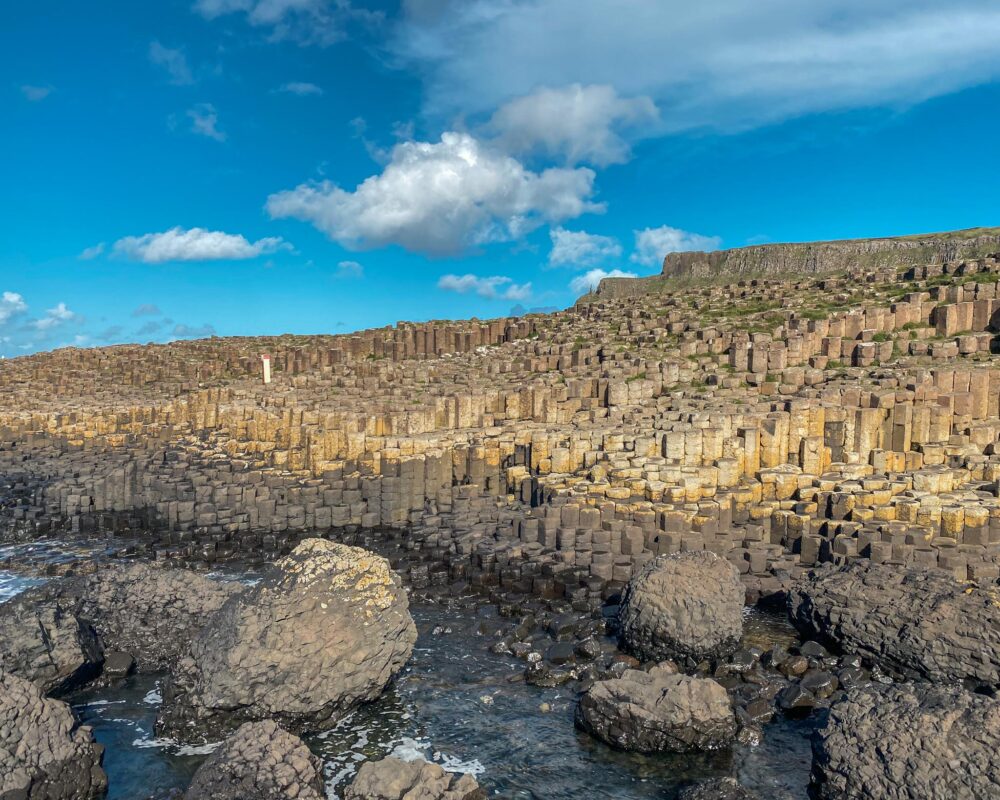
The Giant Causeway Myths and Legend
Like many famous sites across Ireland, the Giants Causeway is the subject of Irish Myths and Legends. The Causeway was said to be created by Giant Fionn mac Cumhaill, a Giant that lived off the coast of Ireland.
One day Benandonner a Giant from Scotland threatened Ireland, Fionn got angry and started to break up parts of the Causeway Coast to create a passageway to meet Benandonner. However, when Fionn reach Scotland he soon realised that Benandonner was a much larger Giant than he was. He quickly made his way back to Ireland and with the help of his wife dressed himself up as a baby. The plan was to trick Benandonner into thinking Fionn was much larger than his baby. Once Benandonner reached Ireland, he got scared and started to break up bits of the Causeway on the way back to Scotland.
Now, whether you believe in Myths and legends one aspect of the story has been proven to be true. There is in fact a part of Scotland known as Fingal’s Cave which features the style of Basalt Collums as the Giants Causeway. It is said to be the opposite end of the Causeway built by Fionn mac Cumhaill.
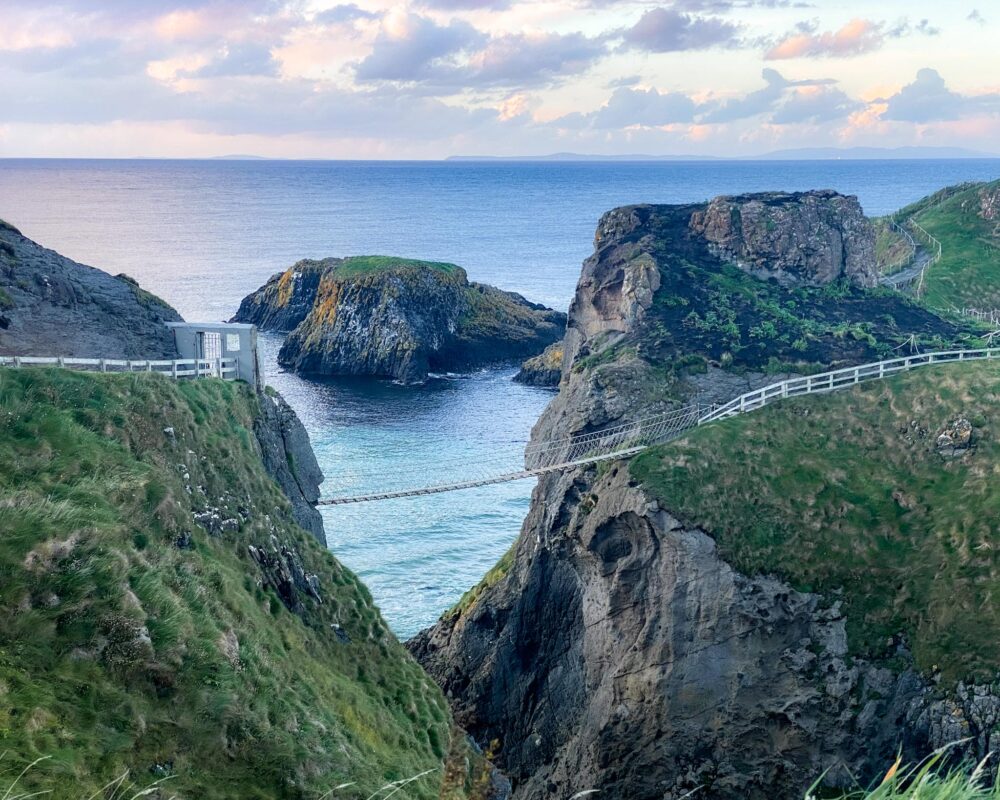
The Carrick a Rede Rope Bridge & Nearby Attractions
Located just a short distance down the road from the Giants Causeway lies the Carrick a Rede Rope Bridge, which translates to ‘the Rock in the Road’ from the Irish Language . The bridge is not for the faith hearted, spanning 30 metres above the water and rocks below. Tourists flock here to get the adrenaline pumping and the heart racing as they cross. The bridge is connected to Carrickarede Island. The Island is the host to stunning views of Antrim’s coastline.
In fact, the causeway coast is home to many wonderful hidden gems , such as Mussenden Temple and the Gobbin Cliff path, which are all worth adding to your Ireland itinerary if time allows.
Carrick a Rede Rope Bridge FAQ
How long does the carrick a rede rope bridge stay open for.
February to June: 9.00am to 6.00pm July to August: 9.00am to 8.00pm October to December: 9.00am to 3.30pm (This is a general time schedule and may change) Carrick a Rede Day Trip
How much does the Carrick a Rede rope bridge stay open for?
Admission into the Carrick a Rede rope bridge costs 9 pounds for Adults and 4 pounds 50 for children. Carrick a Rede Day Trip
Is there parking at the Carrick a Rede rope bridge?
Yes, the car park is built into the price of the ticket and is located directly in front of the ticket kiosk. Carrick a Rede Day Trip
Thanks for Reading! I hope you enjoyed this guide to the top Giants Causeway Coastal Walks. If you have any more questions please feel free to send me a message over on Instagram .
Disclaimer: Please note that some blog posts on LiveAdventureTravel contain affiliate links, meaning I may make a commission on purchases through those links. This is of course at no extra cost to you. Live Adventure Travel is a participant in the Amazon Services LLC Associates Program, an affiliate advertising program designed to provide a means for sites to earn advertising fees by advertising and linking to Amazon.
Similar Posts

HIDDEN GEMS in IRELAND: 57+ ways to discover Ireland Off Beaten Path
Those planning a trip to Ireland often race to discover some of the Island’s most well-known attractions such as the Cliffs of Moher or the Giants Causeway. And while these locations are a must on any Ireland itinerary, there are so many wonderful hidden gems in Ireland that deserve the same love and attention. However,…

33+ HIDDEN GEMS IN DUBLIN – That not even locals know about!
Dublin is a fantastic city to explore for the first time. You have those iconic attractions, such as the Guinness Storehouse, Dublin Castle, and the Book of Kells. And while they are all wonderful places to visit, they also have ALOT in common. And that is crowds, lots and lots of crowds. So, as an…
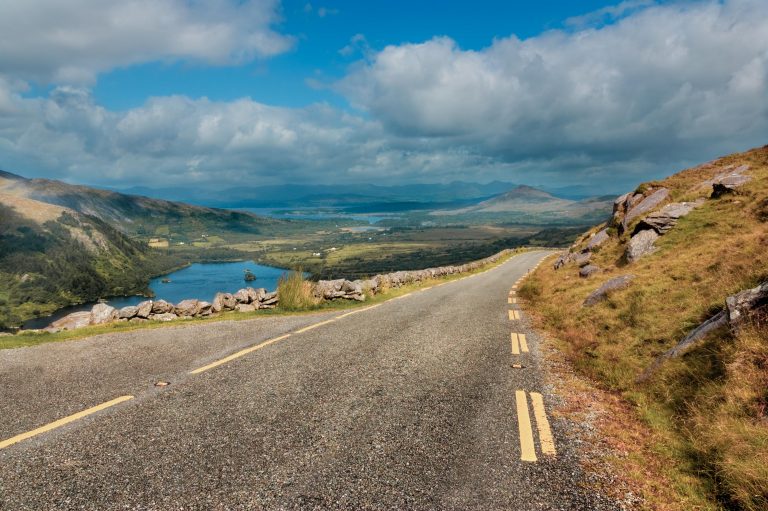
41+ Ireland Travel Tips: Things you SHOULD NOT do on your first trip to Ireland!
Tips for Traveling to Ireland for the First Time – According to a Local The more I venture around the world, the more questions I am asked about Ireland. Ironic isn’t it? But…If I am being honest, I don’t mind it all too much. In fact, I really love talking about my home country. We…
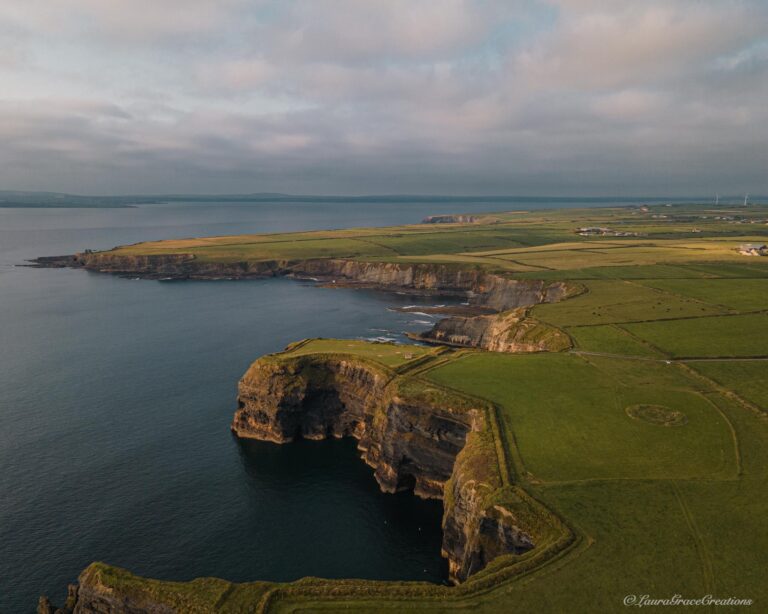
29+ of the Best Cliffs in Ireland: That are NOT the Cliffs of Moher
Most of those planning a trip to Ireland will have the mighty Cliffs of Moher high up on their bucket list. And, all for a good reason. The famous cliffs are visited by over 5 million people each year and they are the backdrop for many iconic movies such as Harry Potter and Leap Year….
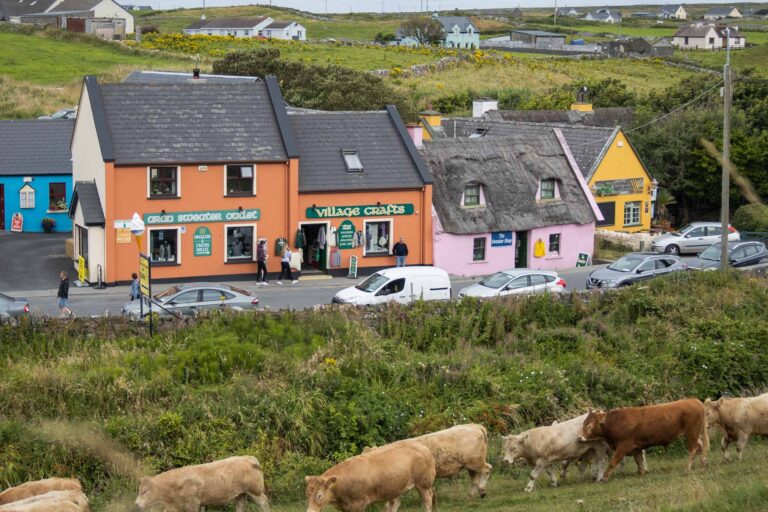
Things to do in Clare, Ireland (Video Guide)
Things to do in Clare, Ireland (Video Guide) In this weeks episode of our Ireland Travel series, we are discovering some of the beautiful surroundings of County Clare. Join us as we explore some of the Top Things to do in Clare. Stay tuned for a future Clare Blog Post

Things to do in Sligo (Video Guide)
Things do in Sligo (Video Guide) I have recently started an Ireland Travel series over on my youtube channel. In this series, we are exploring the beautiful surrounding of my home country, Ireland. In this episode, we check out some of the top things to do in Sligo and County Leitrim. Eagles Rock, Leitrim Glencar…
Leave a Reply Cancel reply
Your email address will not be published. Required fields are marked *
Save my name, email, and website in this browser for the next time I comment.
Sequoia National Park’s giants are the friendly type. Hugs are welcome.

People all over the world watched with rapt attention in 2021 as a wildfire threatened to engulf the world’s largest tree . Firefighters carefully wrapped the base of the General Sherman Tree in shiny, protective blanketing as flames drew closer at Sequoia National Park .
Ultimately, the roughly 275-foot-tall icon was spared, but other giant sequoias weren’t so lucky. Redwood Mountain Grove in neighboring Kings Canyon National Park “lost an estimated 974 to 1,574 large sequoias,” according to Sequoia and Kings Canyon National Parks, which are managed jointly.
“Given the amount of giant sequoias that were lost in the last few years – almost 20% of the entire giant sequoia population was lost in a short amount of time – we're not feeling as confident as we were just a few years ago about these trees really being around for generations and generations to come,” said Sintia Kawasaki-Yee, chief of Communications and Management Support for both parks in California. “We really want to bring attention to their mortality.”
That’s not the only thing Sequoia visitors should know.
What is so special about Sequoia National Park?
Sequoia protects some of the largest trees in the world and a wide array of habitats.
“I would say the most special feature is that you enter at about, I want to say, 1,600 feet of elevation and within about a 45-minute span, you're able to reach 6,500 feet, which is a huge elevation gain in a really small amount of miles,” said Kawasaki-Yee. “You come in in the foothills area. In the spring, we have really great wildflowers. We have the river. We have great access there year-round, but if you drive just 45 minutes into Giant Forest , you get to see the change in the terrain and wildlife.”
Visitors can feel the change too, as temperatures dip and winds whip higher up, so pack accordingly.
Is the General Sherman Tree the tallest tree in the world?
No. It’s not the tallest tree in the world. That title belongs to Hyperion, a coast redwood at Redwood National Park, according to Guinness World Records .But the General Sherman Tree is the largest by volume, with a trunk volume of 52,508 cubic feet, according to the park.
Can you touch the General Sherman Tree?
No. “The Sherman Tree is fenced off, so you cannot touch it, but there are many other sequoias in that same area that you can definitely walk up to and touch,” said Kawasaki-Yee.
She recommends feeling their fibrous bark, which she noted is softer to the touch than one might expect.
“Feel free to hug a tree, connect with a tree,” she added. “That connection is really important to really build that connection for people and hopefully that commitment to protect these trees in the long term.”
From Acadia to Zion: What travelers should know about each of America's national parks
Which park is better, Redwood or Sequoia?
“They're basically siblings, and so it's like comparing your kids,” Patrick Taylor, Interpretation and Education manager for the National Park Service at Redwood , told USA TODAY in April. “You love them both for slightly different reasons.”
He explained that giant sequoias tend to have more volume to them.
“So they're bigger in the sense that they usually have a wider base, and they don't taper off as fast,” he said. “The coastal redwoods are usually a little taller and a little more slender.”
Is Sequoia National Park free?
No. Most visitors will have to pay a flat $35 vehicle entrance fee that covers access to both Sequoia and Kings Canyon.
Certain groups are eligible for free entry to all national parks, namely military service members, veterans, Gold Star families , U.S. citizens and permanent residents with permanent disabilities, and fourth graders and their families .
Can you just drive through Sequoia National Park?
Yes. “You can actually do both parks in one drive,” said Kawasaki-Yee. “A lot of people that are doing road trips will drive through both parks on the same day or the same trip.”
The park is located about a 1 ½ hour drive from Fresno. Fresno Yosemite International Airport is the nearest commercial airport.
What is the best time of year to visit Sequoia National Park?
Kawasaki-Yee recommends visiting in the spring or fall to avoid summer crowds and winter road closures.
“Maybe right before Memorial Day weekend, so you don't get the crowds but you still get access to the areas,” she suggested.
Can I stay inside Sequoia National Park?
Yes. The park offers a variety of on-site camping and lodging , though some lodges, operated by third parties, are only open seasonally.
Who are the Indigenous people of the area?
“Sequoia and Kings Canyon National Parks are the homelands of the Mono (Monache), Yokuts, Tübatulabal, Paiute, and Western Shoshone,” according to the parks’ website, which lists the following affiliated federally recognized tribes:
◾ Big Pine Band of Owens Valley Paiute Shoshone Indians
◾ Big Sandy Rancheria Band of Western Mono Indians
◾ Bishop Paiute Tribe
◾ Bridgeport Indian Colony
◾ Cold Springs Rancheria
◾ Fort Independence Indian Community of Paiute Indians
◾ Fort Mojave Indian Tribe
◾ North Fork Rancheria of Mono Indians
◾ Paiute-Shoshone Indians of the Lone Pine Community
◾ Picayune Rancheria of the Chukchansi Indians
◾ Santa Rosa Rancheria Tachi-Yokut Tribe
◾ Table Mountain Rancheria
◾ Tejon Indian Tribe
◾ Tule River Tribe
◾ Utu Utu Gwaitu Paiute Tribe of the Benton Paiute Reservation

COMMENTS
The Giant's Causeway is a spectacular series of rock formations on the north coast of Northern Ireland. The main site stretches for 2-3 miles, with some 40,000 basalt columns rising out of the sea. ... This park travel guide to Giant's Causeway is a usable article. It has information about the park, for getting in, about a few attractions, and ...
The Giant's Causeway and Visitor Centre is located on the B147 Causeway road. It is 2 miles from Bushmills village, 11 miles from Coleraine and 13 miles from Ballycastle. Parking in the vicinity of the Giant's Causeway is limited. The main car park, adjacent to the Visitor Centre, is reserved for members and Visitor Experience ticket holders.
Visitor centre: Officially opened in July 2012, the Giant's Causeway visitor centre was the result of an international architecture competition. Dublin-based architects heneghan peng won the £18.5 million commission to design the building. The building has won many prestigious awards for design innovation and sustainability.
Local weather warnings and useful travel information; Enable location access. Location access has been enabled. ... the Giant's Causeway. Stand on the hills that gently arc this unique place and you'll look down on thousands of basalt columns tumbling down into the Atlantic Ocean. It's an epic sight, with a whopping 40,000 or so of these ...
The best time to visit the Giant's Causeway during the day is at sunrise or sunset. The Visitor Centre is open from 9:00 AM to 5:00 PM daily, but you can visit outside of opening hours. To truly appreciate its splendor without the crowds, aim to visit either early in the morning or late in the afternoon.
Address. 44 Causeway Road, Bushmills BT57 8SU, UK. Phone +44 28 2073 1855. Web Visit website. The Antrim coast is known for its unique and rugged beauty, but the most breathtaking stop of all is surely the Giant's Causeway. Made up of 40,000 black basalt stone columns placed at the water's edge, the Giant's Causeway is an important ...
The Giant's Causeway and Causeway Coast is a spectacular area of global geological importance on the sea coast at the edge of the Antrim plateau in Northern Ireland. The most characteristic and unique feature of the site is the exposure of some 40,000 large, regularly shaped polygonal columns of basalt in perfect horizontal sections, forming ...
The Giant's Causeway is a vast and impressive expanse of closely packed hexagonal basalt columns approximately 40,000 in number that poke out of the Irish Sea. Formed as a result of intense volcanic activity, it lies on the north coast of the County of Antrim, Northern Ireland. The symmetrical and unique rock formations have mesmerised ...
The Giant's Causeway is a popular destination, particularly during peak times such as bank holidays and the summer months. We recommend choosing to visit before 11am or after 2pm as these are normally quieter times at the World Heritage Site. Pre-booking helps us prepare for your visit and also helps reduce queue times for everyone.
The giant's causeway is made up of around 40,000 hexagonal volcanic basalt columns that are neatly arranged in a promontory. The columns were formed some 6 million years ago from basaltic lava flow. The resulting formation is a testament to Earth's ancient geological processes and looks almost too perfect to be natural.
The Giant's Causeway (Irish: Clochán an Aifir) is an area of about 40,000 interlocking basalt columns, the result of an ancient volcanic fissure eruption. It is located in County Antrim on the north coast of Northern Ireland, about three miles (4.8 km) northeast of the town of Bushmills.. It was declared a World Heritage Site by UNESCO in 1986 and a national nature reserve by the Department ...
Formed 50 to 60 million years ago, during the Paleogene Period, the Giant's Causeway resulted from successive flows of lava inching toward the coast and cooling when they contacted the sea. Layers of basalt formed columns, and the pressure between these columns sculpted them into polygonal shapes that vary from 15 to 20 inches (38 to 51 cm) in diameter and measure up to 82 feet (25 metres ...
The Giant's Causeway is the crème de la crème of natural landscapes in Ireland, so make sure to visit this world-famous attraction. Made up of over 40,000 basalt columns, the causeway is an impressive sight to behold, especially as it juts into the Atlantic Ocean. The Giant's Causeway has been a UNESCO World Heritage Site since 1986.
The Giant's Causeway is a UNESCO World Heritage Site located on the north coast of Northern Ireland near Bushmills. It's pretty incredible- a collection of around 40,000 Basalt rocks, mostly in hexagonal shapes (although some are tall columns), that act like stepping stones protruding from the ocean.
The Giant's Causeway is a surreal natural wonder. Basalt columns stretch along the coast, covering an area of several miles in Northern Ireland. These columns number around 40,000 and each is uniquely shaped and sized. The largest can reach heights of 12 meters and most are hexagonal, although each individual column is different.
Planning a Giant's Causeway day trip from Belfast is one of the most popular days out from the Northern Irish capital. Located on the County Antrim coast in the north of Northern Ireland, the Giant's Causeway is a UNESCO World Heritage Site and it is about as spectacular as you might think.In recent years, visiting these basalt rock formations has increased in popularity but that doesn't ...
Flanked by the wild North Atlantic Ocean and a landscape of dramatic cliffs, the Giant's Causeway is a geological wonder and home to a wealth of history and legend. The 40,000 basalt stone columns left by volcanic eruptions 60 million years ago, has captured the imagination of all who see it. Recognised as one of Northern Ireland's most ...
Northern Ireland's Giant's Causeway is a volcanic formation of nearly 40,000 mostly hexagonal columns, forged 60 million years ago when molten lava cooled quickly in the ocean water and ...
Pedestrian acess to the Giant's Causeway is free. However, if you wish to use any of the facilities at the site, including parking but excluding the Visitor Information Service, the visitor experience charge will apply. Prices: Standard Admission Ticket: Adult £9.00, Child £4.50, Family £22 (2 adults + up to 3 children under 17 years)
Giant's Causeway Tour. 2022 TripAdvisor Travellers Choice Award Winner! Tour departs daily at 8.30am (returns at approx 6pm) McComb's Travel offers visitors to Northern Ireland the longest established tour to what is commonly called "The eighth wonder of the world". Travel in one of our award winning coaches along the Causeway Coastal Route for ...
The second Giant's Causeway Car Park, known as the 'Causeway Coast Way Car Park', is a 7-minute walk away and it's also a rip-off (here on maps). You'll pay £10 to park here and this doesn't include access to the visitor centre.
If you wish to take part in the Giants Causeway visitor experience it will cost £13.00 for Adults and £6.50 for children. Tickets include on-site parking, access to the visitor centre, toilets and the option to take part in a guided tour or go on a self-guided tour with an audio guide.
Sequoia protects some of the largest trees in the world and a wide array of habitats. "I would say the most special feature is that you enter at about, I want to say, 1,600 feet of elevation and ...